The Ultimate Guide to the Taj Mahal in India
:max_bytes(150000):strip_icc():format(webp)/10947453_10153084623948270_8191342691038933499_o-591d1e8d3df78cf5fa731909.jpg)
The Taj Mahal looms fairytale-like from the banks of the Yamuna River. It's India’s most recognized monument and is also one of the Seven Wonders of the World. The monument dates back to 1632 and is actually a tomb that contains the body of Mumtaz Mahal—the wife of Mughal emperor Shah Jahan. He had it built as an ode to his love for her. It's made out of marble and took 22 years and 20 000 workers to complete. Words cannot do the Taj Mahal justice, its incredible detail simply has to be seen to be appreciated.
Agra, in the state of Uttar Pradesh, approximately 200 kilometers (125 miles) from Delhi. It's part of India's popular Golden Triangle Tourist Circuit.
The best time is from November to February, otherwise it can be unbearably hot or rainy. You'll be able to get some excellent off-season discounts though.
The Taj Mahal appears to gradually alter its color in the changing light of the day. It’s well worth the effort to get up early and spend sunrise there, as it majestically reveals itself. Visiting around dawn will also enable you to beat the huge crowds that start arriving later in the morning.

Getting There
The Taj Mahal can be visited on a day trip from Delhi. Agra is well connected by rail. The main railway station is Agra Cantt. High speed Shatabdi Express services operate from Delhi, Varanasi, and cities in Rajasthan.
- Find out the best trains from Delhi to Agra .
The Yamuna Expressway opened in August 2012 and has reduced the travel time by road from Delhi to Agra to under three hours. It starts from Noida and a toll of 415 rupees per car for a one way trip (665 rupees round trip) is payable. Read more about hiring a car and driver.
The bus is a good option if getting a train isn't possible. Comfortable, air-conditioned Volvo buses depart from Anand Vihar terminal in New Delhi every hour during the day. The cost is about 700 rupees per person. The buses go via the Yamuna Expressway and stop at Vaango restaurant for a 30 minute snack and restroom break (the toilets are clean).
Alternatively you can fly from major Indian cities, or take a tour from Delhi.
Taj Mahal Tours
Viator (in conjunction with Tripadvisor) offers a popular and highly rated Private Day Tour to Agra and the Taj Mahal from Delhi, as well as a combined Day Tour to Agra and Fatehpur Sikri and Day Tour to Agra with Culture Walk. It's also possible to see the Taj Mahal at night during the full moon on this 2 Day Private Tour of Agra from Delhi.
Alternatively, see the Taj Mahal on one of these recommended Agra day tours: 11 Hour Agra Day Tour including Sunrise and Sunset at Taj Mahal , Private Taj Mahal and Agra Fort Tour including meal with a view and optional professional photographer, or Sunrise or Sunset View of Taj Mahal .
If you're looking for an inexpensive tour option, U.P. Tourism runs daily, full-day sightseeing bus tours (except on Fridays), to the Taj Mahal, Agra Fort and Fatehpur Sikri. The cost is 750 rupees for Indians and 3,600 rupees for foreigners. The price includes transport, monument entry tickets, and guide fees.
Opening Hours
The Taj Mahal opens 30 minutes before sunrise and closes 30 minutes before sunset, usually around 6 a.m. to 7 p.m. every day, except Friday (when it's closed for prayer). The Taj Mahal is also open for night viewing every full moon from 8.30 p.m. until 12.30 a.m., plus two days before and two days after the full moon (a total of five days). Night viewing is suspended during the holy month of Ramadan every year.
Entry Fees and Information
For foreigners, the ticket price is 1,100 rupees and for Indians, the price is 50 rupees. Children younger than 15 years can enter free. Tickets can be purchased at ticket offices near the entry gates or online at this website. (Do note, tickets for the Taj Mahal are no longer able to be purchased at Agra Fort or other monuments, and only offer a minimal discount if you wish to visit other monuments on the same day).
The foreigner's ticket includes shoe covers, bottle of water, tourist map of Agra, and bus or golf cart service to the entry gate. It also enables ticket holders to enter the Taj Mahal ahead of any Indian ticket holders already waiting in line.
Night Viewing tickets cost 750 rupees for foreigners and 510 rupees for Indians, for half an hour’s admittance. Children aged three to 15 years must pay 500 rupees. These tickets must be purchased between 10 a.m. and 6 p.m., one day in advance from the Archaeological Survey of India office on Mall Road. See more details here, including night viewing dates.
Vehicles aren't allowed within 500 meters of the Taj Mahal because of pollution. There are three entry gates—South, East, and West.
- The West gate is the main gate that the majority of local Indian visitors enter through, and it generally has the longest lines throughout the day. However, it's the preferred option at sunrise to avoid the crowds at the East gate.
- The East gate is popularly used by foreign tourists, as it's closest to a number of well-known hotels. It usually has shorter queues except for at sunrise, when large groups tend to arrive there. If you buy your ticket in advance the day before, it's still the best entry point. Do note that the ticket office (in Shilpgram) is inconveniently located about 10 minutes walk from the gate. Buses, golf carts and cycle rickshaws are available for those that can't, or don't want to, walk.
- The South gate is the least-used gate. It's close to a congested market area where many of the cheap hotels are situated, making it favored by budget and independent travelers. However, it doesn't open until 8 a.m. A huge sandstone gateway provides access to the inner compound there.
There are exclusive ticket counters for foreigners at both the East and West gates.
Security at the Taj Mahal
Strict security is in place at the Taj Mahal, and there are checkpoints at the entrances. Your bag will be scanned and searched. Large bags and day packs aren't allowed to be taken inside. Only small bags containing essential items are permitted. This includes one cell phone, a camera, and a water bottle per person. You can't bring edibles, tobacco products or lighters, electrical items (including phone chargers, headphones, iPads, torches), knives, or camera tripods inside. Cell phones are also banned during night viewing sessions, although cameras are still allowed. Luggage storage facilities are provided at the entry gates.
Guides and Audio Guides
If you want to marvel over the Taj Mahal without the distraction of having a tour guide with you, government-approved AudioCompass provides an inexpensive official Taj Mahal audio guide on its cell phone app. It's available in many foreign and Indian languages, including English, French, German, Italian, Spanish, and Japanese.
See the Taj Mahal Without Going Inside
If you don’t want to pay the costly admission fee or battle the crowds, you can get a great view of the Taj from across the river bank. This is ideal for sunset. One such place there is Mehtab Bagh—a 25 acre Mughal garden complex directly opposite the monument. The entry cost is 250 rupees for foreigners and 20 rupees for Indians, and it's open until sunset. Unfortunately, an unsightly barbed wire fence has been erected beside the river to stop tourists from wandering along it.
It's possible to take a row boat out on the river. Head down the path along the eastern wall of the Taj Mahal to the riverside temple, where you will find boatmen.
There's also a little-known abandoned watchtower across a sandy field on the eastern side of the Taj Mahal. It's an ideal place for a splendid sunset view of the monument. Reach it by heading east from the East Gate and taking a right at the fork in the road. Pay the official 50 rupees to enter.
Uttar Pradesh Tourism's Taj Khema hotel offers notable vistas of the Taj Mahal from its gardens too. A new marble bench was installed on a mound there in early 2015, especially for visitors. Sip tea and watch the sunset! The hotel is located about 200 meters from the monument, on the eastern side. It's a government-run establish, so don't expect great service though.
Another option is the rooftop of the Saniya Palace hotel, on the southern side of the Taj Mahal.
Cleaning of the Taj Mahal's Exterior
The first thorough cleaning of the Taj Mahal to remove the yellow discoloration from pollution and restore the marble to its original brilliant white color occurred in 2018. To achieve this, a natural clay paste was applied to the monument's exterior. The clay packing of the main dome remains and is planned to be undertaken in stages, starting from the front of the monument.
Taj Mahotsav takes place at Shilpgram in Agra, right near the Taj Mahal, from February 18-27 each year. The focus of this festival is on arts, crafts, Indian culture, and recreating the Mughal Era. It gets underway with a spectacular procession that includes elephants, camels, and drummers. Camel rides are on offer, and there are also games for the kids and a food festival. The venue has special significance, as it's apparently located on the site where the artisans who built the Taj Mahal once lived.
Where to Stay
Unfortunately, many of the hotels in Agra are as uninspiring as the city itself. However, these top Agra hotels should help make your stay a memorable one. There are accommodations to suit all budgets and many have Taj views.
Dangers and Annoyances
Visiting the Taj Mahal can be overwhelming for all the wrong reasons. Be prepared to encounter plenty of beggars and touts there. According to this news report , it has become an increasingly troublesome problem, and many visitors go back home feeling cheated, threatened and abused. Touts operate in sophisticated gangs that have counterparts in other cities who identify potential targets at railway stations. Once the tourists reach Agra, the touts start pestering them by claiming that they are guides or taxi drivers. They commonly use ploys such as free taxi rides or the promise of heavy discounts.
Note: There are 24 hour official prepaid auto rickshaw and taxi booths just outside Agra railway station. Use these to avoid the hassle, and if you book a tour there check the quality of your vehicle to make sure it's satisfactory.
Do be sure to tell auto rickshaw drivers which Taj Mahal entry gate you wish to be taken to, otherwise it's likely that you'll find yourself dropped off in the area where expensive horse and cart or camel rides wait to take tour groups to the west gate.
Apparently, there are only 50-60 approved guides at the Taj Mahal. However, more than 3,000 touts posing as photographers, guides or middleman, openly solicit customers at the monument's three gates (especially at the western gate, which receives around 60-70% of visitors). Hundreds of hawkers (who pay bribes to the police) are also a problem at the Taj Mahal, despite being officially banned.
In addition, foreigners, particularly women and parents with young children, are frequently asked to pose for photographs (or even being photographed without permission) by other people including groups of guys. This can be intrusive and uncomfortable. This news article warns about selfie seekers at the Taj Mahal.
Lastly, do be aware of the notorious gem scam , which is alarming prevalent in Agra.
Other Attractions Around Agra
Agra is a rather dirty and characterless city, so don’t spend too much time there. In case you're wondering what else to do in and around the city, take a look at these Top Places to Visit in Agra and Around.
Nature lovers will appreciate a trip to the Bharatpur Bird Sanctuary at Keoladeo Ghana National Park, 55 kilometers (34 miles) from Agra.
How to Visit Agra Fort: The Complete Guide
Guide to India's Palace on Wheels Luxury Train
Fatehpur Sikri in India: The Complete Guide
One Week in Delhi: The Perfect Itinerary
Guide to India's Mahaparinirvan Express Buddhist Circuit Train
Humayun's Tomb in Delhi: The Complete Guide
11 Places to Visit Around Agra Beyond the Taj Mahal
14 Famous Forts and Palaces in India that You Must See
Jaipur's Hawa Mahal: The Complete Guide
One Week in Mumbai: The Perfect Itinerary
Essential Guide to Visiting Mandu in Madhya Pradesh
Nahargarh Fort in Jaipur: The Complete Guide
How to Travel from Delhi to Agra by Train, Bus, and Car
The Best Day Trips to Take From Delhi
12 Most Popular Historical Monuments of India
15 Top Tourist Places to Visit in North India

Visiting the Taj Mahal: Everything you need to know
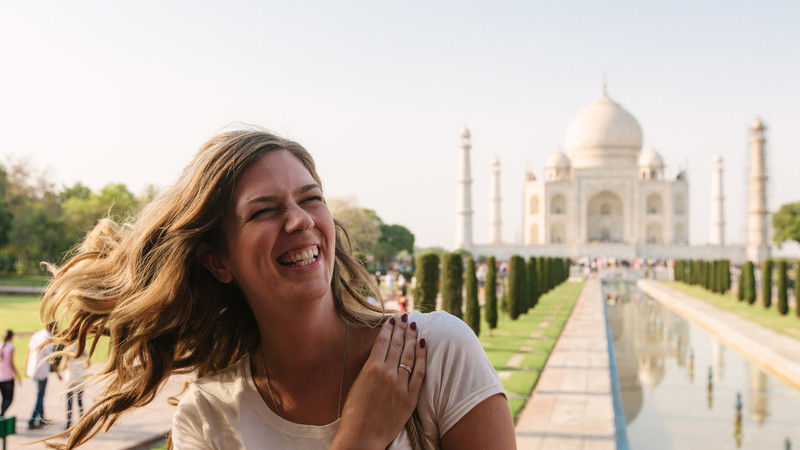
Is there a sight more iconic, more beautiful, more jaw-droppingly spectacular than the Taj Mahal?
Quite honestly, we can’t think of one.
At the very least, there’s no mausoleum more grand, no declaration of love more apparent than building a marble masterpiece for one’s favorite wife… And no better reason to travel than seeing its magnificence up close.
After all, this is art. Built in Agra, India between 1631 and 1648, it’s also history. And, of course, it’s the perfect opportunity to take some otherworldly photos. So, to help visitors prepare for their Taj Mahal travels, we’ve prepared a little guide, enlisting the help of some Intrepid experts – from Destination Managers to acclaimed trip leaders – to cover all the bases.
Coming up: what to bring, where to take the best snaps, what else to see in Agra (and beyond), and so much more…
Before you arrive at the Taj Mahal
That old saying ‘patience is a virtue’ really comes into its own when discussing the Taj Mahal.
Be prepared to be surrounded by hundreds (if not thousands) of people. These include Indian men, women and children who may ask to take photos with you.
To prepare with the help of other travelers and a local tour guide, consider taking a group tour. Intrepid have Taj-visiting trips that range from 8-day Golden Triangle tours (now with solo-only departures !) to 15-day trips dedicated to food , to 19-day trips combining the highlights of India and Nepal .
If you’re more pressed for time, you can check out the Taj Mahal on a whirlwind day tour from Delhi. Check out Urban Adventures to see the itinerary that we’d recommend for this. And while you’re at it, check out their day trips in Delhi , Jaipur , Varanasi and Mumbai !
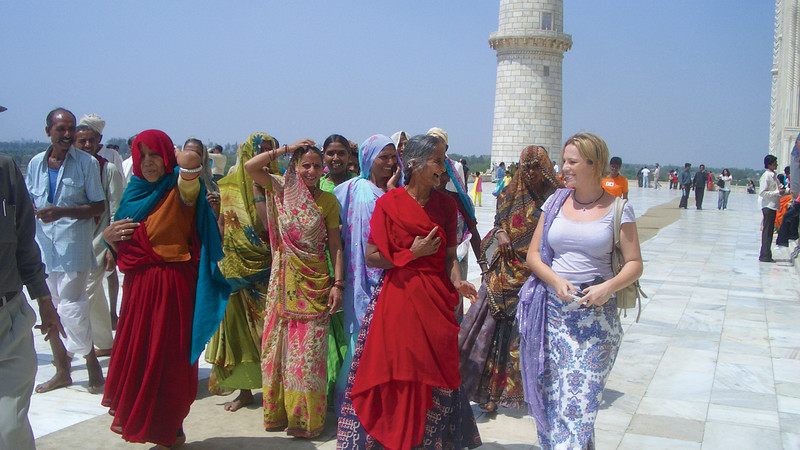
What to bring to the Taj Mahal
Always leave your valuables in the hotel. There are lockers available at the Taj but it’s best to have minimal belongings on you so you don’t spend too much time checking in.
You really only need to bring the following in one small bag:
What to wear to the Taj Mahal
There is no dress code but you should still be respectful. If you want to enter the mosque, you will need to cover your head, shoulders and knees.
It gets hot in Agra and there is very little shade, so wear light clothing and make sure you wear sunscreen. Then again, Agra also gets very cold in winter (Nov-Feb) so layers are your friend too.
If you visit with Intrepid, you’ll be taken there earlier in the day or later in the afternoon to avoid the worst of the heat.
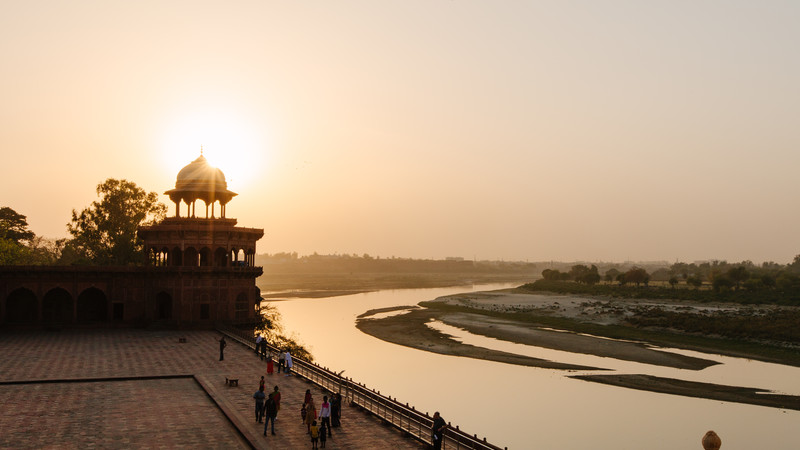
Having been to the Taj a few times, I’ve learnt the importance of wearing shoes that are easy to remove. You need to take your shoes off when you go inside and the easier they are to slip on and off the better. This actually applies to much of India – shoes with loads of laces are hard!
Other things you need to know
No food is allowed inside.
Cigarettes and lighters are also not allowed.
Tripods and additional lighting equipment need prior permission to be brought with. Photography inside the mausoleum is prohibited. Most electronics (except cameras and small video cameras) are not allowed.
Be wary of touts, thieves and rude shop keepers. It’s a busy, high-pressure area, but keep your wits about you and you won’t need to worry!
When you’re at the Taj Mahal
Go early, wait for space to explore and photograph, and get yourself away from the crowds (if possible).
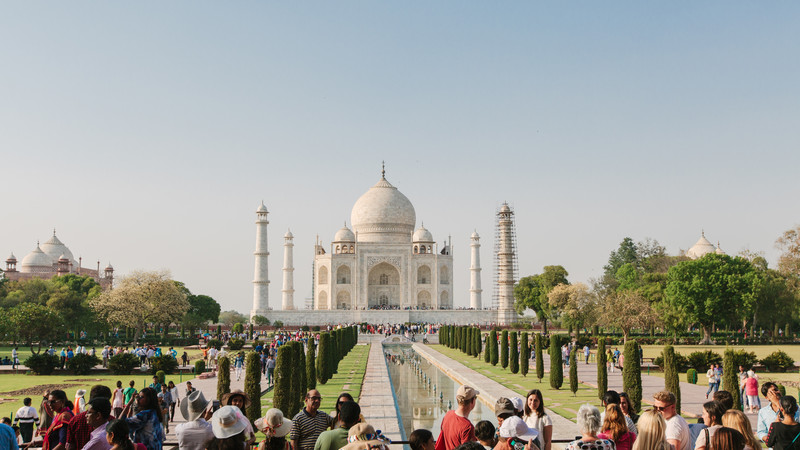
And simply focus on taking in all the magic. Even Intrepid leaders who see the Taj Mahal monthly (or more!) remain in awe of it. Sana Jinah , one of the company’s inspiring female tour guides, has some tips on how to do this:
The Taj Mahal is a place for exploring quietly on your own or with loved ones. So, once I’m done briefing my groups I give them a good 2-3 hours inside the Taj. There are ways I try to make the experience special and memorable for travelers, but if I say what they are then they will no longer be surprises! The Taj has such a charm. Every time I see it it looks different (due to the direction of the sunlight). It’s so beautiful…
She also recommends those looking for optimum conditions try visiting the Taj Mahal at sunrise on a clear day.
Tips for taking photos at the Taj Mahal
Everyone wants that iconic shot of themselves at the Taj Mahal. You know the one – where you sit on the bench and the grandeur of the marble mausoleum forms the backdrop.
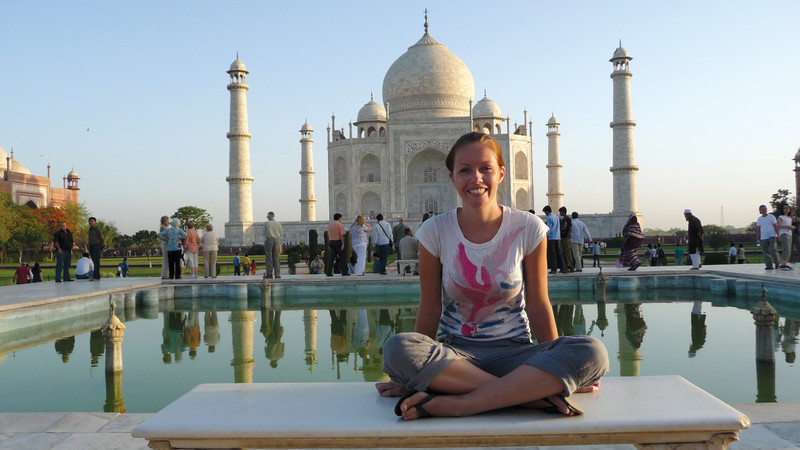
Below are some photography suggestions from Intrepid’s General Manager in India, Pravin Tamang . (His photography is amazing – check it out !)
- Shot from the arch of the main doorway
- Capture the reflection of the fountains that line the route towards the Taj Mahal’s main platform
- Shot of Taj Mahal from the riverside with the reflection on the river
- Shot from the other side of the river, ‘Mehtab Bagh’, where you get a glimpse of Taj
- The Taj Mahal can also be shot from some parts of the Red Fort
You can also get great photos from the many rooftops of restaurants close to the Taj Mahal. Unfortunately, Agra does get pretty smoggy, so winter can often have poor visibility earlier in the day and around sunset. That said, this can make shots look very atmospheric!
What to do after visiting the Taj Mahal
First, go back to your hotel room, take a shower, and revel in the relative peace and quiet. Then explore these cool destinations both in and out of Agra:
What to do in Agra
The Taj Mahal is, quite clearly, the star of the show in this northern Indian city. But the Agra Fort is also stunning, especially if you didn’t get a chance to go to the Red Fort in Delhi. A 16th-century Mughal monument and UNESCO World Heritage site, it’s a sight not to be missed.
Despite being located on the Golden Triangle tourist circuit, there’s less to do in Agra than in many other Indian cities. It’s pretty polluted from the heavy industry (more on that later) and you likely won’t spend too long there, whatever the trip.
One way that Intrepid tries to show visitors a different perspective on the country is by (sometimes) taking travelers to Sheroes Hangout . Just blocks from the Taj Mahal, it’s a small cafe run entirely by female acid attack survivors. Here, victims of attacks are employed and tell their stories. It can be confronting, but also inspiring and memorable in equal measures.
SUBSCRIBE TO INTREPID’S NEWSLETTER FOR MORE TRAVEL GUIDES, COMPETITIONS, GIVEAWAYS & MORE
Where to go outside of Agra
There are various great destinations only a few hours drive (well, 4-7) from the Taj Mahal. Of these, Orchha, Jaipur and Pushkar are all tourist-friendly, peaceful and beautiful places.
Orchha is a town that travelers often overlook. This is a shame, because it’s historic, laid-back and has a bunch of beautiful temples. It’s not always on tour itineraries, but you CAN visit it on this 15-day trip from Delhi to Kathmandu (cooking demo and palace visit included!).
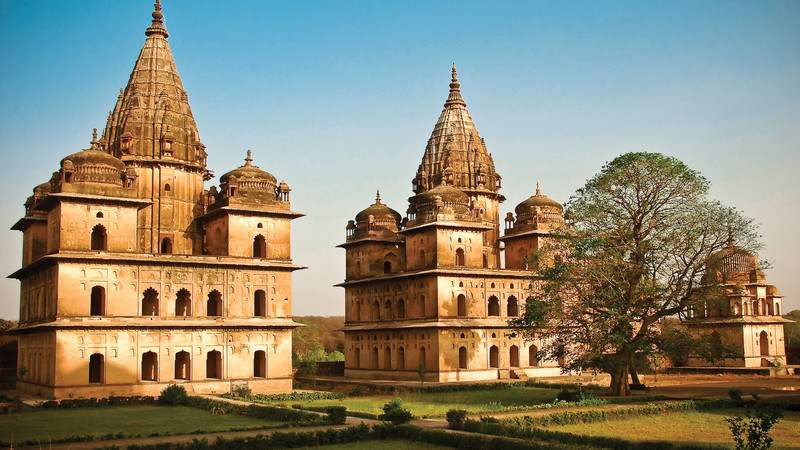
Chaturbhuj Temple in Orchha
Jaipur is much more well-known. Also known as the ‘Pink City’ , the capital of Rajasthan is full of chaos, charm and unique architecture. Visit the hilltop Amber Fort, haggle in the enchanting bazaars, and consider taking a hot air balloon over the city to take it all in.
Pushkar is another underrated town. One of the oldest and most serene towns in India, it’s home to Pushkar Lake, a sacred spot for Hindus that’s utterly dazzling at sundown. Because of its holy nature, the vegetarian food here is simply unmissable. Visit on this 15-day trip all around Rajasthan.
A final note about the Taj Mahal’s mud therapy
As you may have read or heard, the Taj Mahal has recently been undergoing a very thorough clean. Yep, to be precise, a mud mask as of April 2018.
Why? Air pollution from factories in Agra had been slowly turning the Taj Mahal’s ivory-white surfaces yellow – and this was one way of restoring them to their former glory. The work – applying a clay traditionally used to clean marble to the entire structure of the Taj – was carried out by the Archaeological Survey of India. And this work was part of a series of restorative projects carried out on the historic site.
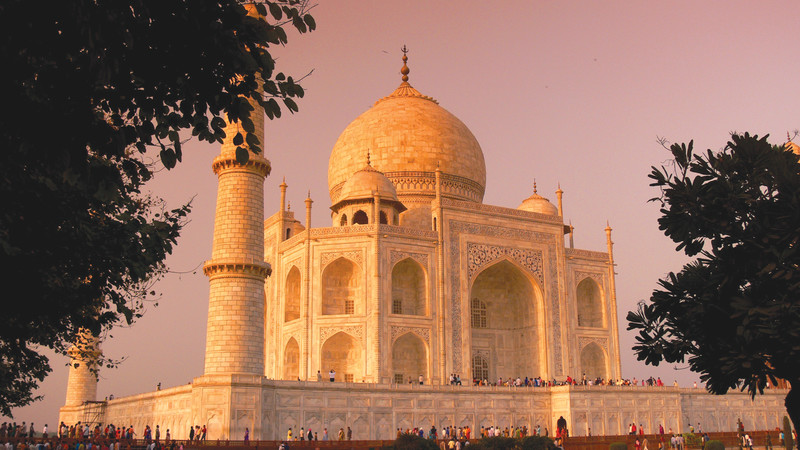
(Image credits from top to bottom: Intrepid Travel, Stephanie Young, Intrepid Travel, Intrepid Travel, Sarah Dibdin, Chris Grundy, Hamish Cattell, David Williams)
Feeling inspired?
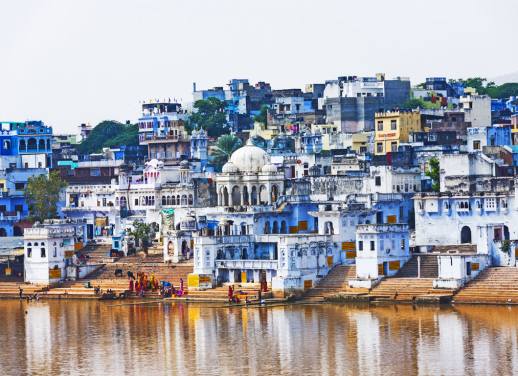
Bex Shapiro
Born in London and based in Toronto, Bex is happiest anywhere she can connect with interesting people over good food. She's passionate about sustainable travel and powerful storytelling, and her favourite cities are New York and Shanghai. She's also the Senior Editorial Manager at Intrepid. Follow her adventures on Twitter and Insta @BexShapiro.
You might also like
Skip paris this summer and explore these 3..., all aboard the rail renaissance: 7 reasons to..., explore these 7 tea rituals from around the..., why travellers are choosing the galapagos off-season, tips and hacks for train travel in europe, why train travel is the one experience you..., everything you need to know about a night..., mind your manners: dining etiquette around the world, 5 places to escape the crowds in italy..., is australia safe everything you need to know, 10 fun facts you might not know about....
Visiting the Taj Mahal: plan the perfect trip to India's iconic monument

Mar 2, 2022 • 11 min read

From why it was built to where you can stay nearby, here's everything you need to know about visiting the Taj Mahal © SasinTipchai / Shutterstock
There are few sights in the world as iconic as the Taj Mahal . The grandeur of this magnificent monument is equaled only by the tragedy of its backstory – the tomb of a royal bride, created by a mourning emperor, who ended his days robbed of his empire, imprisoned in a gilded cell with a view of this beautiful, tragic mausoleum.
As the single most famous sight in the subcontinent, the Taj is a must-see on most India itineraries, particularly for travelers on the famous Golden Triangle circuit, linking Delhi , Agra , and Jaipur . However, the Taj is mobbed daily by sightseers from across India and around the world, so get used to the idea of sharing the experience.
Here is an introduction to the history and legends surrounding India’s most famous building, and tips for making the trip of a lifetime.
Where is the Taj Mahal?
The Taj Mahal stands in gorgeous Mughal gardens in the Taj Ganj district of Agra, a historic but noisy city of four million people on the hot, dusty plains of Uttar Pradesh in northern India .
Agra has a reputation as a hectic spot, but its historic wonders – not just the Taj, but nearby Agra Fort , and a string of other Mughal monuments – make it worth braving the touts, pollution, and persistent rickshaw drivers.
Agra is well connected by road, rail, and air. The easiest route from Delhi is the 6:55am 12280 Taj Express train, which reaches Agra in just three hours.
What is the Taj Mahal?
The Taj Mahal is often described as the greatest monument built for love, but the Taj Mahal is actually a memorial to tragedy. When Mumtaz Mahal, the chief consort of the Mughal emperor Shah Jahan, died in childbirth in 1631, the heartbroken emperor devoted years and a considerable fortune to constructing a tomb worthy of his great love.
The mausoleum was finally completed in 1648 after years of painstaking chiseling and carving by the most skilled craftspeople in the Mughal empire. The queen consort was interred inside in a private chamber at the heart of the monument and Shah Jahan was later buried alongside his wife when he died in 1666.
The Taj Mahal has many special features
The riverside location reveals a lot.
The Taj is tucked into a curve of the Yamuna River, a tributary of the sacred River Ganges, about 1.5km (1 mile) east of Agra Fort. The rediscovery of the "moonlight garden" – built across the river from the tomb but later buried by silt – hints at religious connotations to the Taj’s riverfront location, with the tomb’s eight rooms representing the hasht bihisht (eight paradises) and the Yamuna representing the rivers of milk and honey that wait for the virtuous in the afterlife.
The Taj is built with perfect symmetry
From its gleaming domes and filigree marble screens to its towering minarets, the Taj shows perfect bilateral symmetry along an axis running through the center of the main dome and the surrounding gardens. The only break in symmetry is found in the burial chamber, where the grave of Shah Jahan sits just to one side of the grave of Mumtaz Mahal set at the geometric center of the monument.
The dome is remarkable
The elegant onion-dome atop the Taj Mahal is a perfect illustration of the complex geometry used in Islamic architecture. The base of the dome – which is almost as tall as the building below, and flanked by four smaller domes – is supported by eight angled ogive arches, allowing the transition from a square plan to a circular structure.
The stonemasonry is a masterpiece
While it looks like it was carved from gleaming white marble, the Taj is a masterpiece of stone facing. Entombed behind intricately carved marble panels and perforated screens is a brick-and-lime mortar skeleton, but it cannot be glimpsed from any of the open areas of the monument. For insights into this style of Mughal architecture, check out Khan-i-Khanan’s Tomb in Delhi, which was stripped of its sandstone and marble veneer to build a tomb for a higher ranking Mughal dignitary.
The Taj is covered in magnificent ornamentation
The Taj isn’t the only Mughal monument to feature pietra dura – intricate inlay work, made from semi-precious stones – but it is unquestionably the finest. While it shines brilliant white from a distance, up close the Taj is adorned with an elegant tracery of filigree scrollwork, leaves, flowers and Islamic motifs, executed in marble, jasper, lapis lazuli, carnelian, malachite, and other colored stones.

Cultured calligraphy covers the four pishtaqs
The four pishtaqs (arched recesses) on the four sides of the Taj are framed by passages from the Quran in intricate calligraphy made from strips of jasper inlaid into marble panels. The script increases in size as it climbs the walls of the monument, but appears to be a uniform size when viewed from the ground – a testament to the complex architectural understanding of the craftspeople who built it.
The gardens are heavenly
Everyone has seen the photos of world leaders posed at the end of the ornamental ponds in front of the Taj. Both the main gardens inside the complex and the so-called moonlight garden on the north bank of the Yamuna River are built to mirror the charbagh , the four gardens of heaven. Note the influence of Islamic geometry – flowerbeds are shaped like the rub el hizb (Islamic star) and water features split each quarter of the gardens into four equal parts.
Shah Jahan and Mumtaz Mahal's graves are elsewhere
While the inlaid marble cenotaphs of the royal couple stand in an elegant space beneath the main dome, shielded by an octagonal perforated screen, these do not contain the bodies of Shah Jahan and Mumtaz. The actual graves of the emperor and his wife are hidden in an underground vault that has been closed to the public since the tomb was constructed.
The minarets are deliberately angled
Although they were never used for this purpose, the four towers marking the corners of the tomb were built as working minarets, with stairways and balconies allowing a muezzin to call the faithful to prayer. If you look closely, you’ll notice that the minarets are angled slightly outwards, allowing the towers to collapse away from the mausoleum in the event of an earthquake.
The Taj is flanked by a mosque and its mirror image
To the west of the main mausoleum is an elegant red sandstone mosque that is still in use today, with two low minarets that sit almost flush with its roofline, so as not to distract from the grandeur of the Taj. The identical building on the east side of the tomb was constructed purely for symmetry; it was not suitable for prayer as it faces away from Mecca.
The building's exterior is discolored due to pollution
The Taj still shimmers like it did in 1648, but up close, you may notice a yellow, green, and brown sheen, caused by toxic pollution from heavy industry and vehicle emissions in Agra. Despite government schemes to close factories and reduce traffic in the area around the Taj, and several attempts to clean the marble with "face packs" made from a fine clay that absorbs stains and other pollutants, the problem persists. In 2018, the Supreme Court issued an ultimatum to the Indian government to properly restore the Taj, or demolish it! In response, the Archaeological Survey of India announced a six-month program of mud-pack facials for the main dome in October 2021.
The Taj has often been copied, but never equalled
Copies of the Taj Mahal have been built around the world. Constructed by Aurangzeb’s son Azam Shah in 1679, the Bibi-qa-Maqbara in Aurangabad , is an obvious tribute to the Taj, though much less refined. There are also modern reproductions of the Taj Mahal in Bangladesh, China, Indonesia, Malaysia, the US, Brazil, Colombia, and several Gulf States.

The story of the Taj Mahal
The Taj didn’t spring into the world fully formed from the imaginations of its architects. Instead, it was the product of a generations-long process of architectural evolution, running throughout the Mughal period, with a string of earlier tombs marking the progress towards the Taj's funereal perfection.
Agra’s Itimad-ud-Daulah , built for Mumtaz Mahal’s grandfather in 1622, features many of the same design elements as the Taj Mahal, but lacks its finesse and perfect proportions. The nearby tomb of the emperor Akbar , built in 1605, was another imperfect Taj prototype, making similar use of ornamental minarets and white marble inlays. However, both monuments were merely refinements of architectural ideas first established by the tomb of Humayun , constructed in Delhi in 1569.
There are many legends of the Taj...
Many myths have grown up around the Taj. It’s claimed, for example, that the craftspeople who built it were mutilated so they could never build anything so beautiful again – though there’s no historical evidence for this. The same applies to the tale that Shah Jahan planned to build a mirror-image "Black Taj Mahal" on the opposite bank of the Yamuna River.
One story that is definitely true is that Shah Jahan was imprisoned in Agra Fort by his son, Aurangzeb, in a chamber with a view of the Taj Mahal– a torturous incarceration for the deposed emperor. It’s also true that the Taj is tilting ever so slightly, as the changing flow of the Yamuna River has dried the soil beneath its foundations. We’re some centuries away from a Leaning Taj of Agra, however!
...as well as some controversies
Some stories about the Taj are more controversial than others. Although no physical evidence has been discovered, some Hindu nationalists claim that the Taj was built over the desecrated ruins of a Hindu temple called Tejo Mahalya. There are even conspiracy theories about hidden doors protecting secret rooms full of looted Hindu treasures.
There is some historical precedent for Mughal monuments being built over temples – Delhi’s Qutab Minar complex was built using stones from 27 destroyed Hindu and Jain temples – but claims about the Taj were publicly debunked in court in 2017 by the Archaeological Survey of India .

Everything you need to know to plan your trip to the Taj Mahal
What is the best time to visit the taj.
It is possible to visit the Taj Mahal year-round, but it’s much more pleasant to explore the monument during the dry winter months, from October to March. From April to May, temperatures soar, and the skies open up for the monsoon from May to September.
How long do you need at the Taj?
Allow at least three hours to explore the mausoleum, gardens, and outlying buildings. Add in nearby Agra Fort and you’ll easily fill a day. Staying nearby in Taj Ganj will help you get to the gates ahead of the crowds.
What are the opening hours of the Taj?
The Taj is open from dawn to dusk, from Saturday to Thursday (the complex is reserved for worshippers on Fridays). Technically, the Taj opens 30 minutes before sunrise, so arrive before this time to be first through the doors. For the latest information on opening, visit the Taj’s official website .
When do night tours take place?
For five nights around the full moon the Taj is open between 8:30pm and 12:30am for special Night View tours. You only get to view the mausoleum from the edge of the compound, but it’s certainly a memorable way to see the Taj. Book tickets in advance through Agra’s Archaeological Survey of India office.

How much does it cost to visit the Taj?
International visitors pay Rs 1100 entry, while Indian visitors pay just Rs 50, and visitors from SAARC and BIMSTEC countries pay Rs 540. For all visitors, there’s an optional Rs 200 to enter the mausoleum. Tickets are available online via the Archaeological Survey of India payment portal . There’s no charge for using a still camera, but for video cameras, there’s a Rs 25 fee.
Where are the best places to stay nearby?
Accommodation close to the monument in the Taj Ganj district comes at a premium, but you might sneak a view of the Taj. At opposite ends of the price spectrum, the grand Oberoi Amarvilas and economical Saniya Palace Hotel both have stunning vistas of the mausoleum. However, you may have a cheaper and quieter stay if you pick a hotel near Sadar Bazaar or Fatehabad Road.
What's the best way to travel around in Agra?
Rickshaw, autorickshaw and taxi drivers in Agra are notorious for charging elevated rates; haggle firmly for a fair price before you set off. For a fair fixed fare, try booking a ride-share through the Ola app, or use the prepaid desks at Agra Cantonment Train Station.
What is the dress code and etiquette at the Taj Mahal?
The Taj Mahal is an active place of worship, so dress respectfully. Wear clothing that covers the upper arms and legs, and try not to be intrusive with your camera. Photos are prohibited inside the mausoleum, and tripods are banned completely. There are separate lines for men and women; food and tobacco are banned from the complex, and bags must be left in the free lockers at the west gate.
You might also like: When to go to India "I had to start a travel company to travel." How one agency is making tourism more inclusive and accessible Celebrating Diwali: India's festival of lights
This article was first published Jun 23, 2020 and updated Mar 2, 2022.
Explore related stories

Mar 11, 2020 • 6 min read
From Srinagar’s gardens to Agra’s mausoleums, Mughal architecture is distinctive and divine. Here's where to see it.

Nov 22, 2019 • 7 min read

Sep 19, 2019 • 6 min read

Apr 18, 2024 • 6 min read

Mar 29, 2024 • 6 min read

Dec 17, 2023 • 22 min read

Oct 18, 2021 • 8 min read

Jan 28, 2021 • 5 min read

Feb 6, 2020 • 6 min read

Jan 5, 2020 • 4 min read

The Ultimate Guide to Visiting the Taj Mahal
There was no question about whether I’d go.
For my travel partner, however, visiting sounded more like a chore than a crossing off a long-held bucket list item.
Yes, Dave wanted to skip the Taj Mahal.
I was convinced he’d lost his mind.
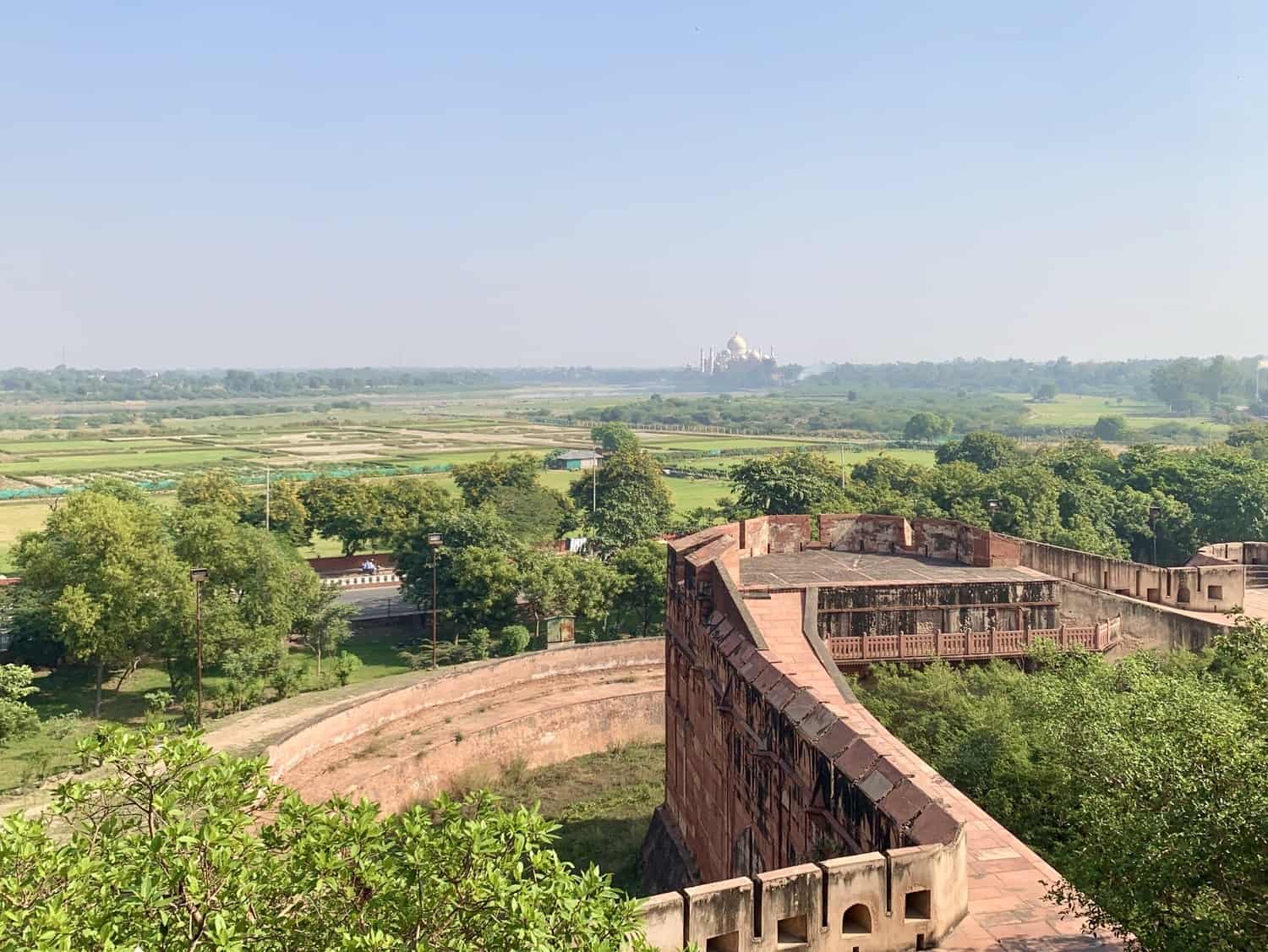
I couldn’t comprehend going to India and not seeing its most famous monument. Having the opportunity to see one of the most iconic buildings in the world and being like, nah, I’ll pass? I could never.
Dave believed the treasures of this country would lie outside of its most crowded attraction.
I thought the Taj had the potential to be just as wondrous as Angkor Wat, the Great Wall of China , or the Great Barrier Reef …
We both stayed firm to our point of view, but I think we also secretly expected the other to be right.
Because while I wondered if seeing the Taj Mahal could be something that would stay with me forever, I also thought the crowds could ruin the experience.
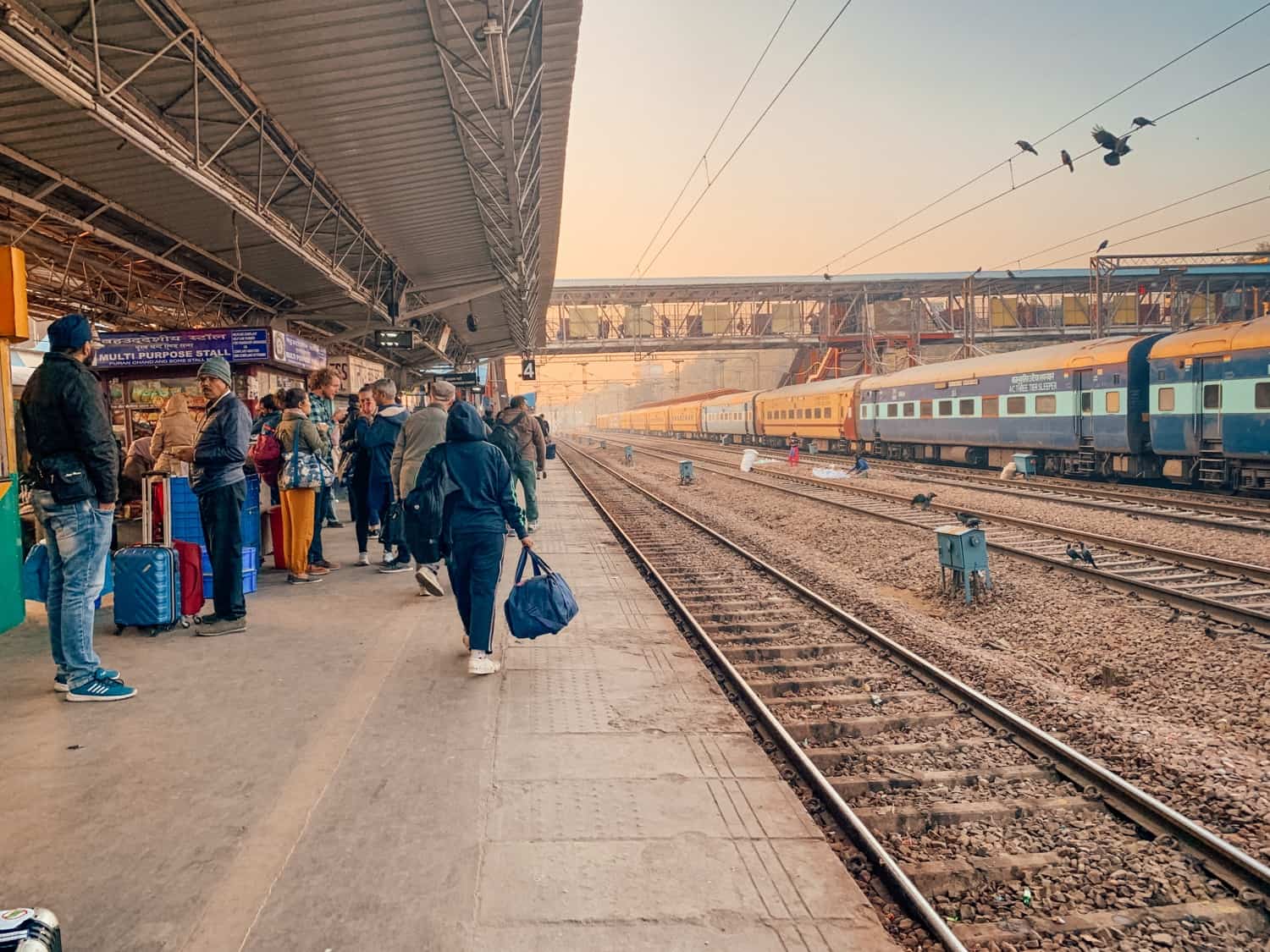
We set off early from New Delhi, on the Gatimaan Express — the fastest train in India — that left from Hazrat Nizamuddin station at 8:10 a.m. and arrived in Agra by 09:55 a.m., preparing ourselves for an action-packed day of movement. As I sat beside the window and gazed out at the smoggy scenes whipping past us, I smiled.
I was in India. After so many daydreams and freak outs, I was finally here and I couldn’t get enough of it. I wondered if I’d warm to my second destination as much as I had to Delhi .
Because, well, everybody seems to hate Agra.
Despise it.
I couldn’t find a single positive write-up of the city before we arrived in town. Detractors labelled the city the dirtiest in all of India, claimed it was full of scammers; announced that the best part of Agra was leaving Agra.
And so I gave us just one day to see everything.
Twenty-four hours to take the train to Agra, check-in to our guesthouse, visit the main attractions of city, and marvel at the Taj Mahal. The following day, we’d be leaving at 9 a.m. to drive to Jaipur.
Once we arrived in Agra, we would need to hit the ground running.
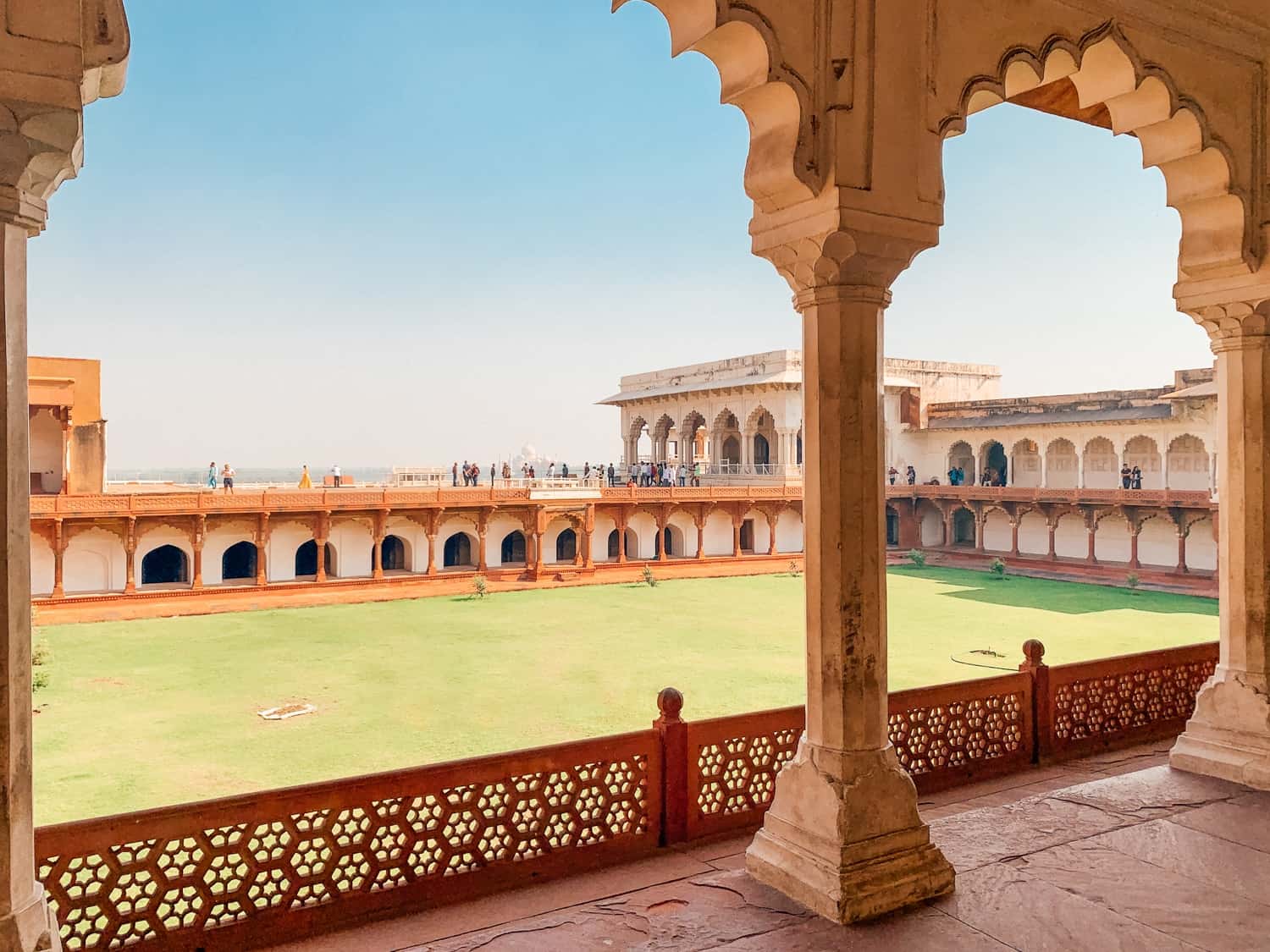
Now, I have a thing for liking places that people hate, and I kind of warmed to Agra.
It was polluted, noisy, crowded, dirty, and I didn’t hate it.
I can’t even explain why.
I think I was still on an India high — so excited to be in the country — that I could be wowed by just about anything.
Dave, like everybody else, hated it.
I thought it was okay.
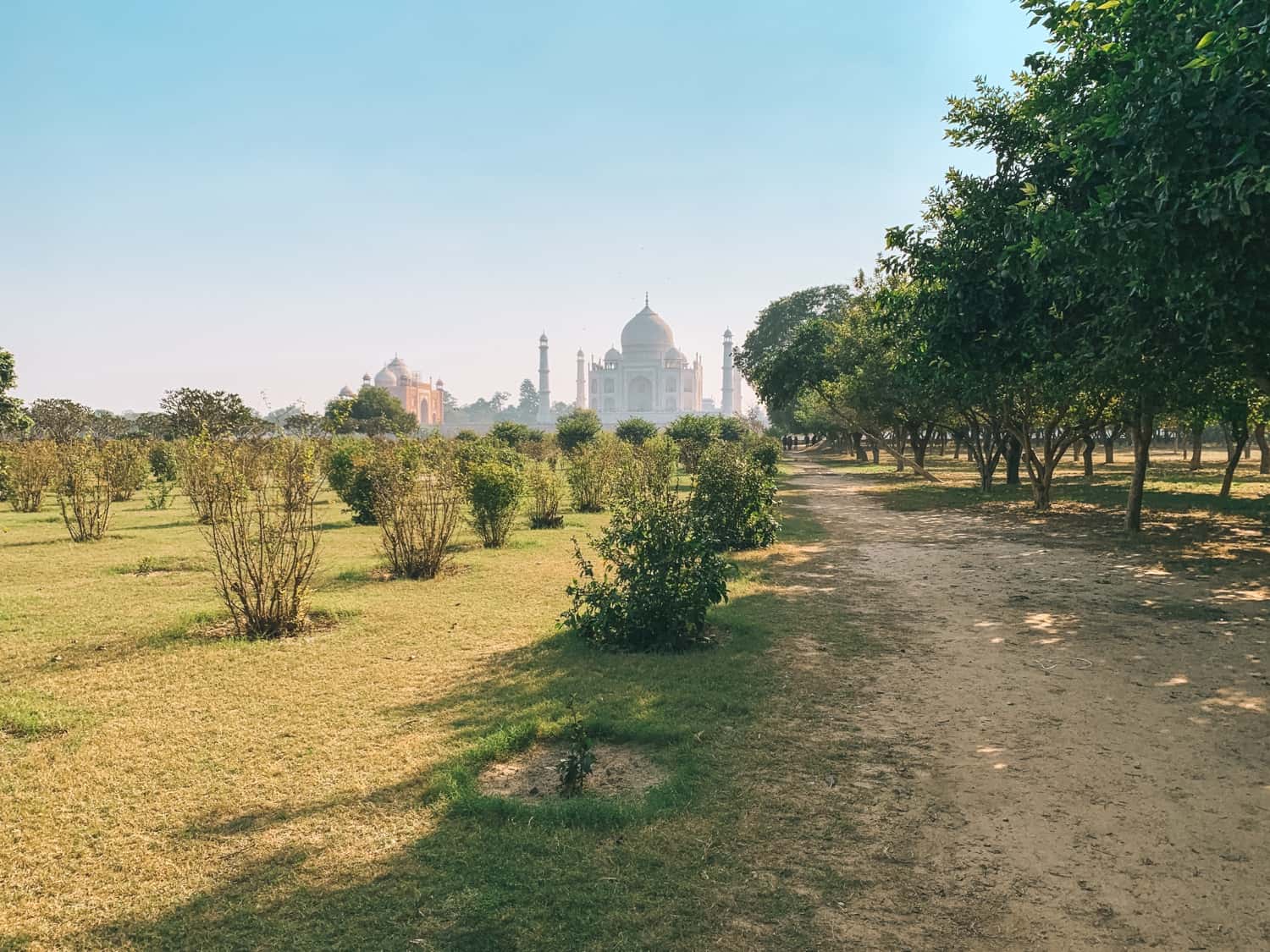
My First Sighting of the Taj Mahal
The Taj Mahal is seemingly everywhere in Agra. You’ll spot it from most of the tourist attractions, restaurants, and guesthouses.
I caught my first glimpse from Agra Fort, which was surprisingly quiet when we visited after lunch. The fort provides a hell of a lot of wonderful viewpoints, often with nobody else around. I was surprised by how peaceful it was to walk around and was wowed by the structure as much as I was its views.
Later on in the day, we ventured to Mehhtab Bagh Garden on the Yamuna River’s north bank to see the Taj Mahal from a different angle, and it was one of my favourite spots in the city. There was nobody else around when we visited — just me and Dave snapping a ton of photos.
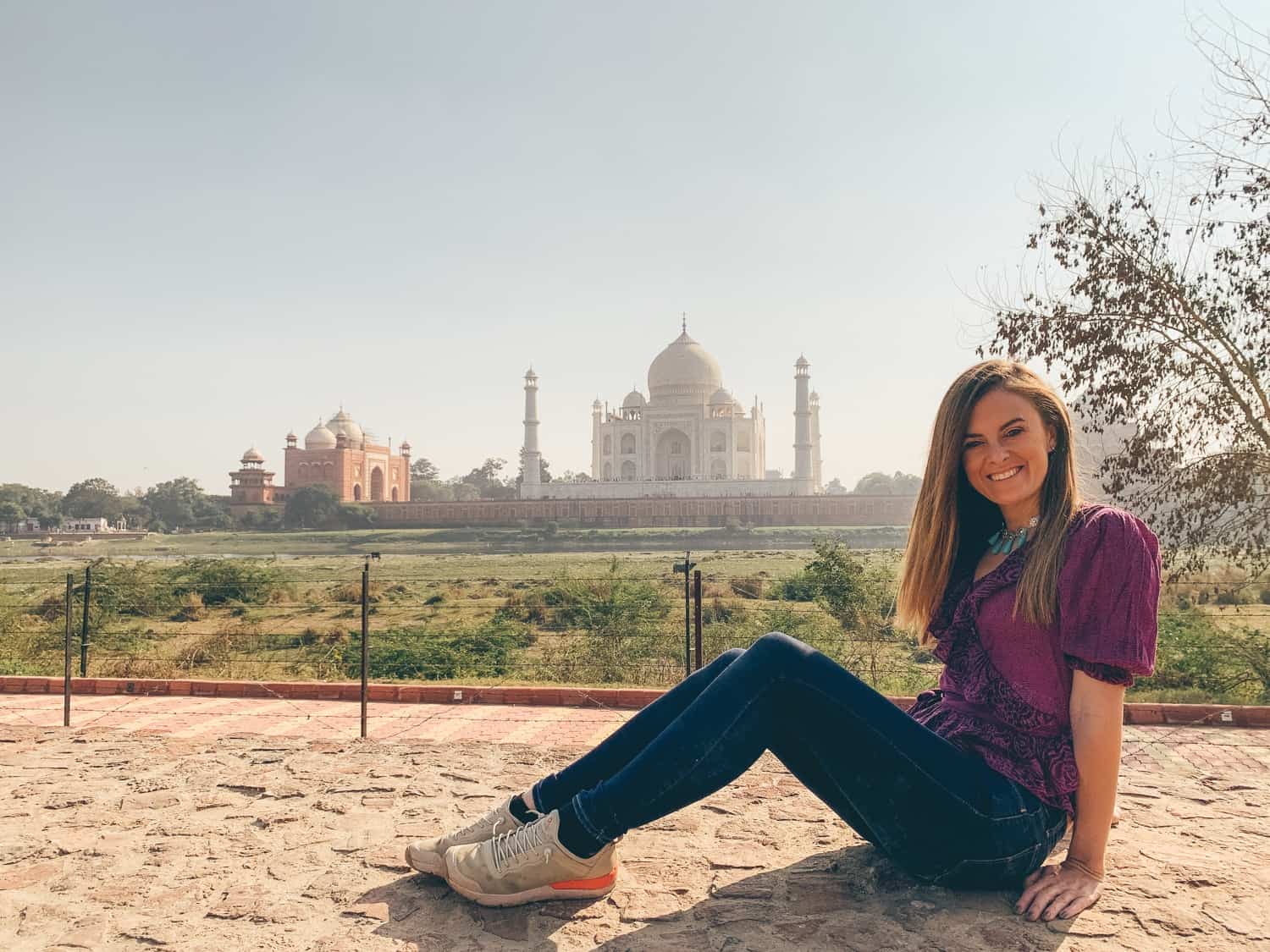
I always thought I’d visit the Taj Mahal for sunrise, because that’s what everyone does. That’s the best way to see it, I’d read.
But our guesthouse owner had put doubts into my mind.
I was visiting in winter, you see. In December. Full-on smog central. Fog mayhem. At this time of year, the Taj can be blanketed in fog and hard to make out, especially in the morning.
In the afternoons, the haze burns off and the skies are as pristine as they can get in India. The guesthouse owner had strenuously advised us to visit later in the day.
“Should we do it?” I asked Dave, as we sat beside the river looking up at the Taj. “Shall we just go now?”
“I think we should.”
“If we hate it, we can always return at sunrise, right?”
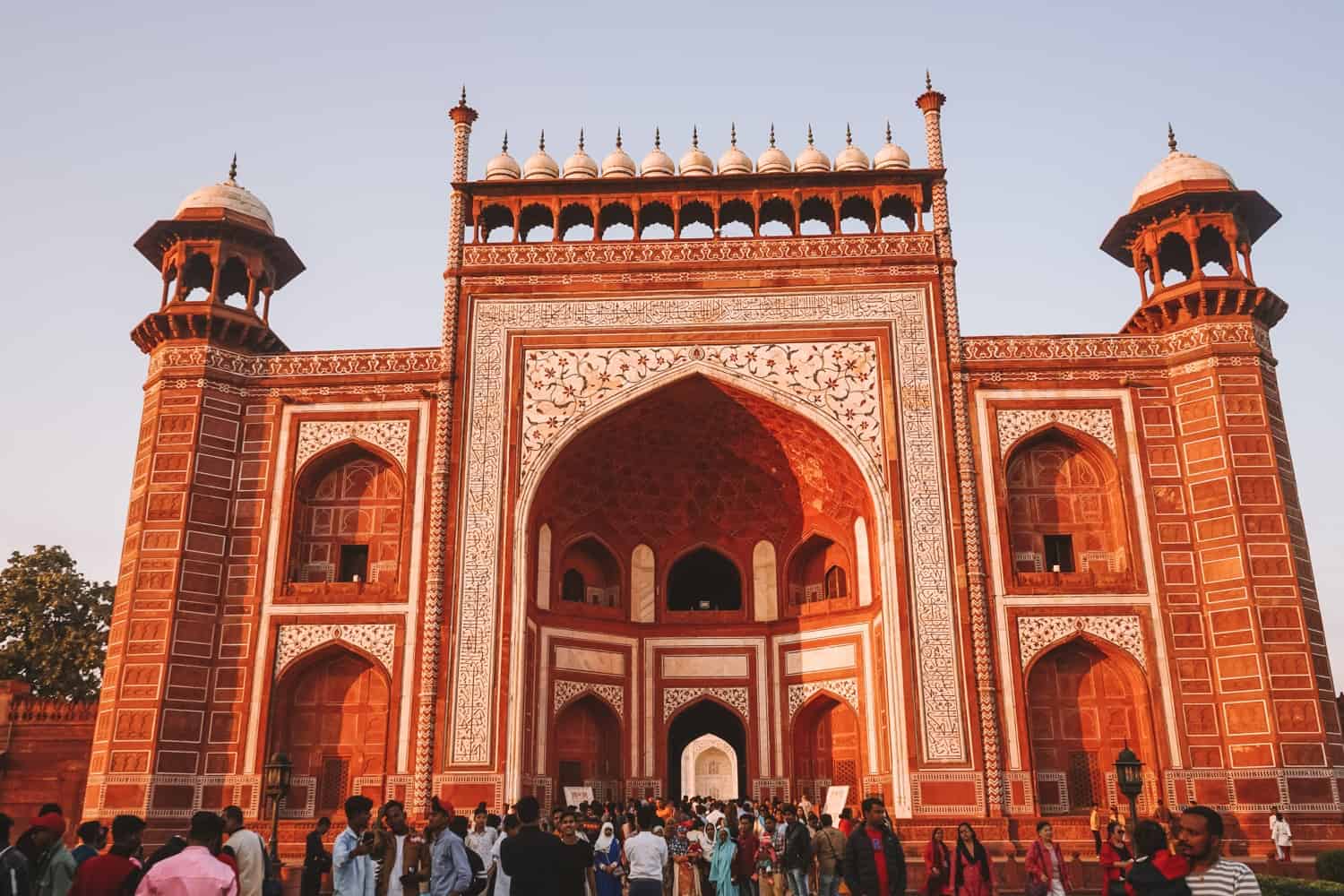
We returned to our rickshaw and asked our driver to take us to the East Gate. There are three entrances to the Taj Mahal — each with their pros and cons (more on that below) — and I’d decided the East Gate would be best for us.
Everybody says that Taj Mahal gets busier and busier throughout the day, but there were few foreigners opting to visit at 3 p.m. on a Tuesday. In fact, there was nobody at all in the foreigner queue for tickets. We paid our entrance fee, separated to head through the male- and female-designated lines, then met back up at the gate.
I was buzzing, eager to catch my very first glimpse of the Taj Mahal.
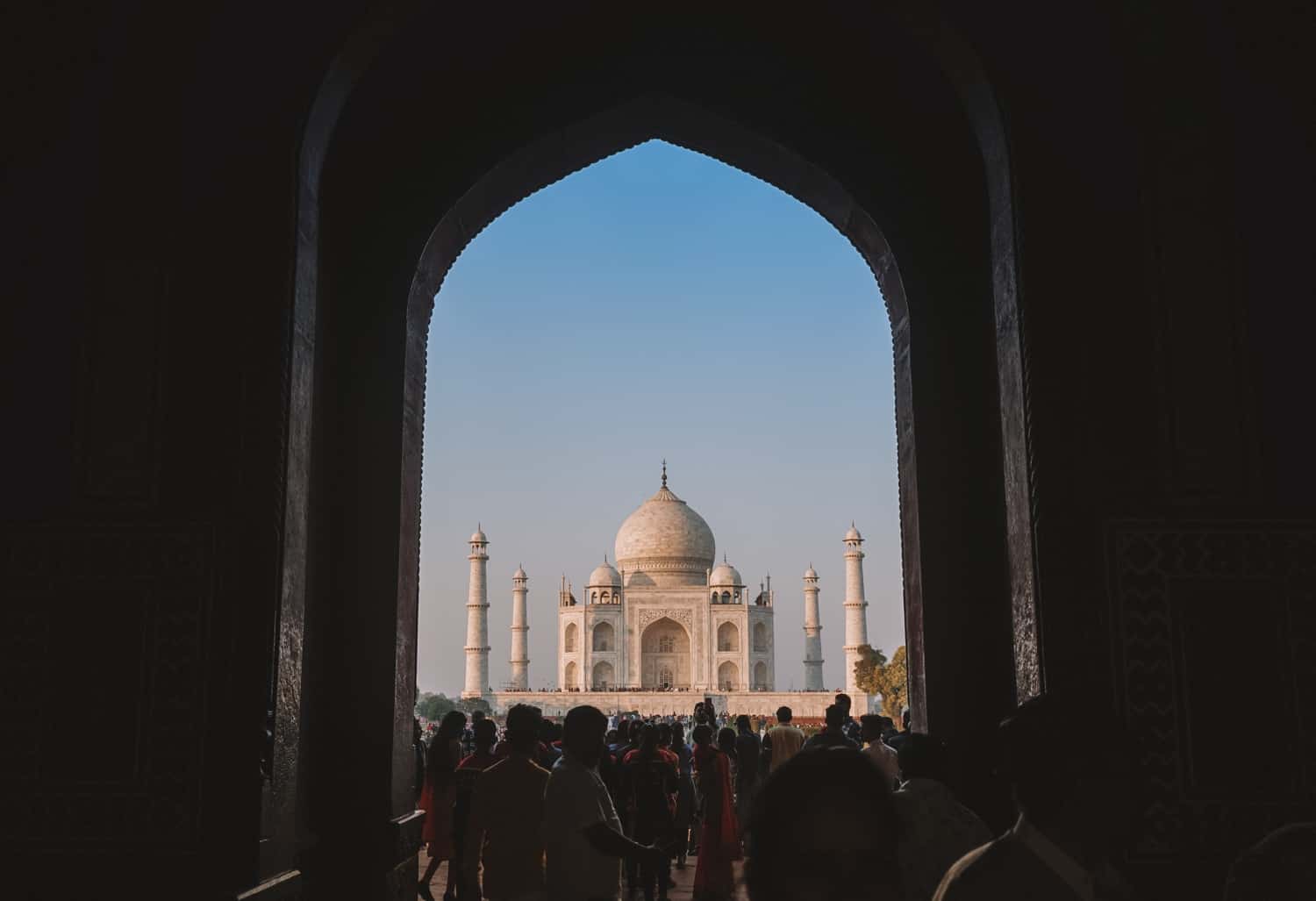
Nothing prepares you for seeing something you’ve seen a thousand times over in magazines and on screens. To see it with your own eyes feels unreal. It’s almost as though your brain just assumes you’ve entered a TV screen and are walking around inside. That feels more plausible, in a way, than actually being there in person.
It was pretty bizarre.
I kept blinking, as though there was a mirage in front of me, as though I was dreaming, unable to accept the fact that I was here.
I grinned as I took that iconic photo at the gate’s entrance, at the archway, with everybody crowding to see the Taj for the very first time.
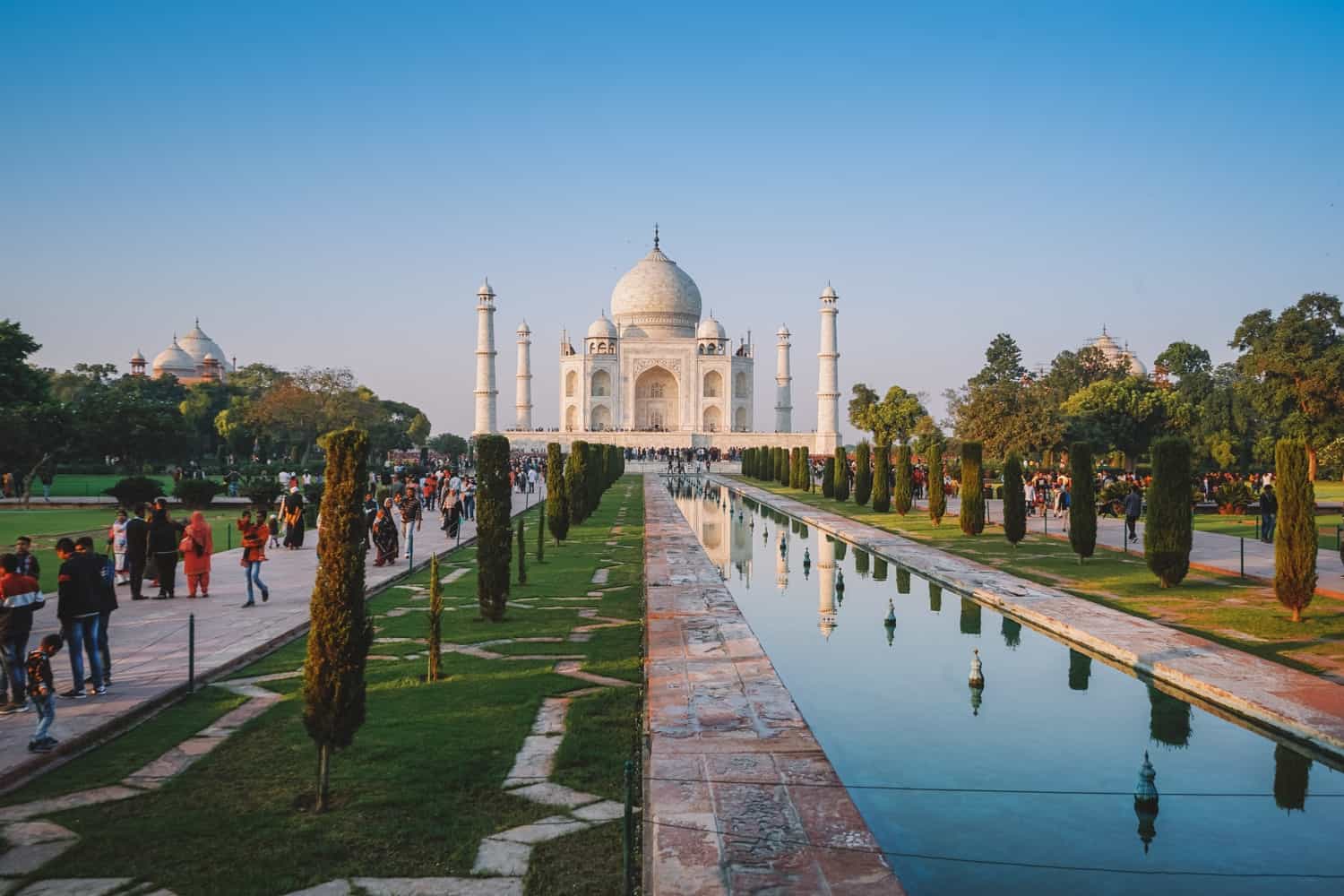
At first, I was overcome with energy and began buzzing my way around the complex, taking photos of everything: the fountains, the pools, the benches, the lawn.
I wanted to capture it all: every angle; every detail; zoomed in and zoomed out. I was desperate to find a unique angle to capture something that has been photographed from every possible perspective over the past hundred years.
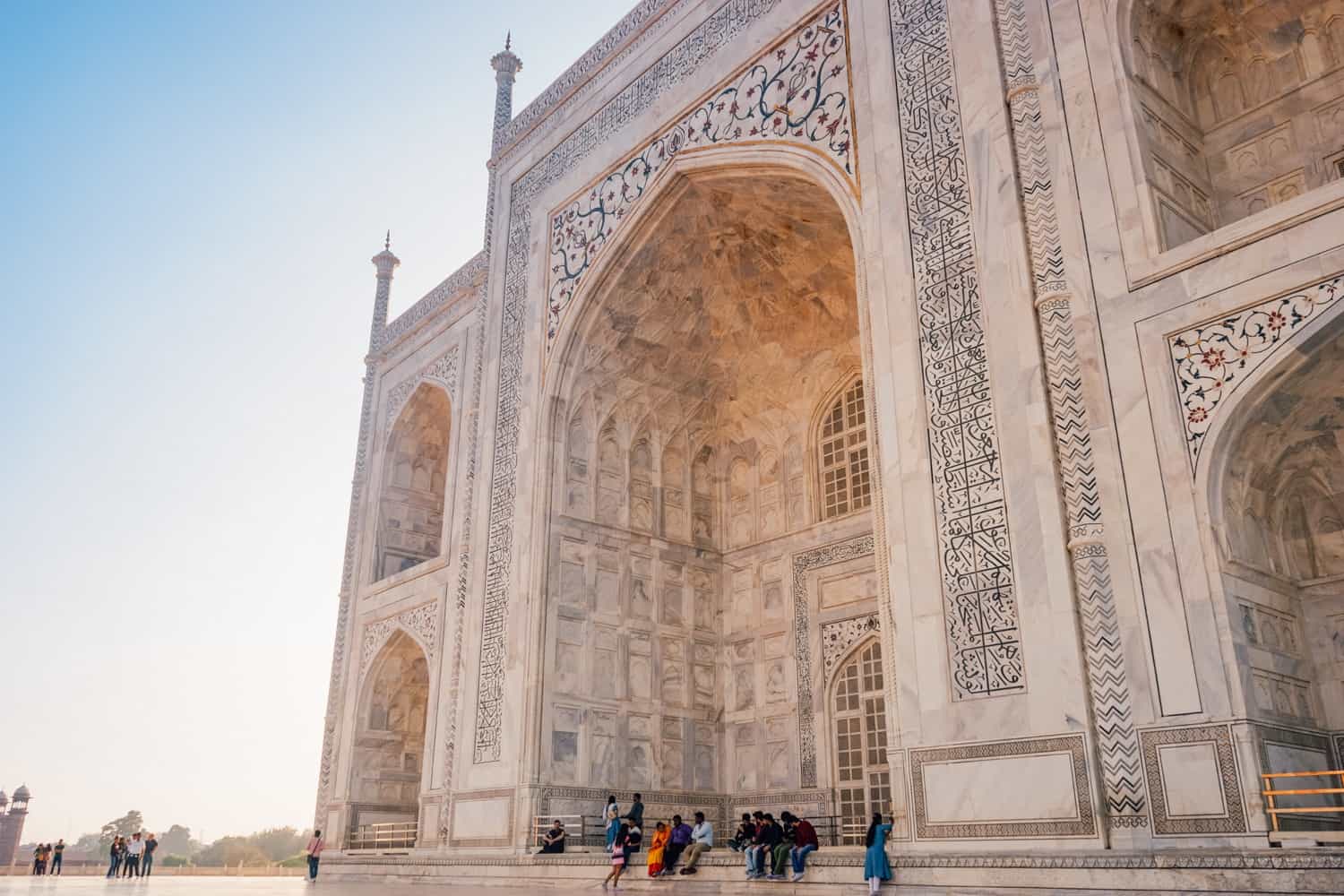
Despite looking a bit like a mosque, the Taj Mahal isn’t a religious structure.
It’s a mausoleum, built in the 1600s by the Mughal emperor Shah Jahan to house the tomb of his favourite wife, Mumtaz Mahal. It took 20 years to complete, with more than 20,000 workers, and 1,000 elephants, coming together to build the complex.
You can head inside the mausoleum to see the tomb of Mumtaz Mahal, as well as Shah Jahan, as he was later buried there, too.
First, though, you’ll need to put on your shoe covers. The marble floors have begun to wear down after many millions of footsteps have been taken across these floors, so you’ll need to shield your shoes in order to protect the ground from further deterioration.
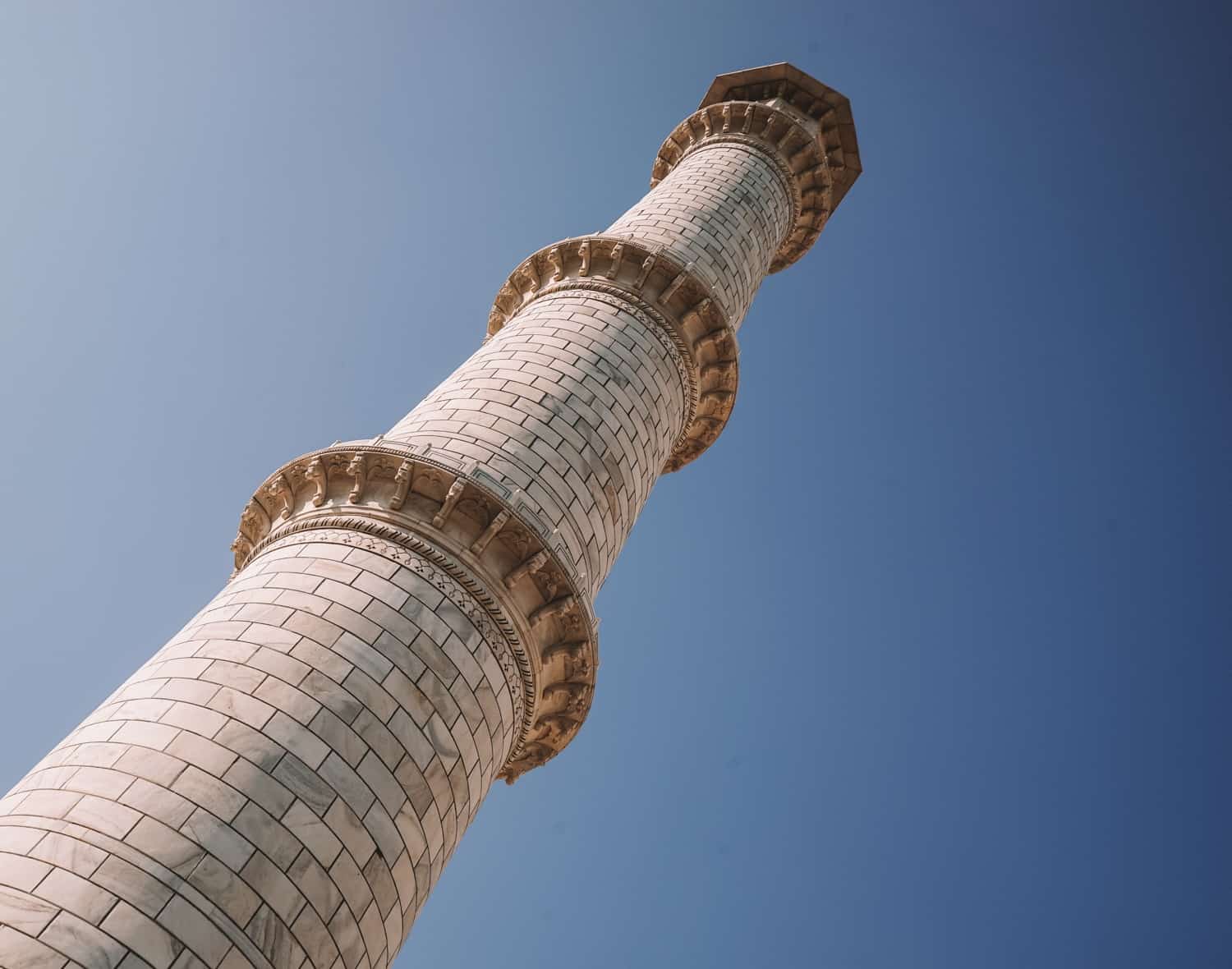
You aren’t allowed to take photos inside the mausoleum, but that was okay. I didn’t need to.
It was kind of chaotic once you entered, as there were security guards everywhere, yelling at you to walk faster; you’re not allowed to stop moving once you’re inside.
And so, the tombs were fine . But I was glad when I got to escape back outside again.
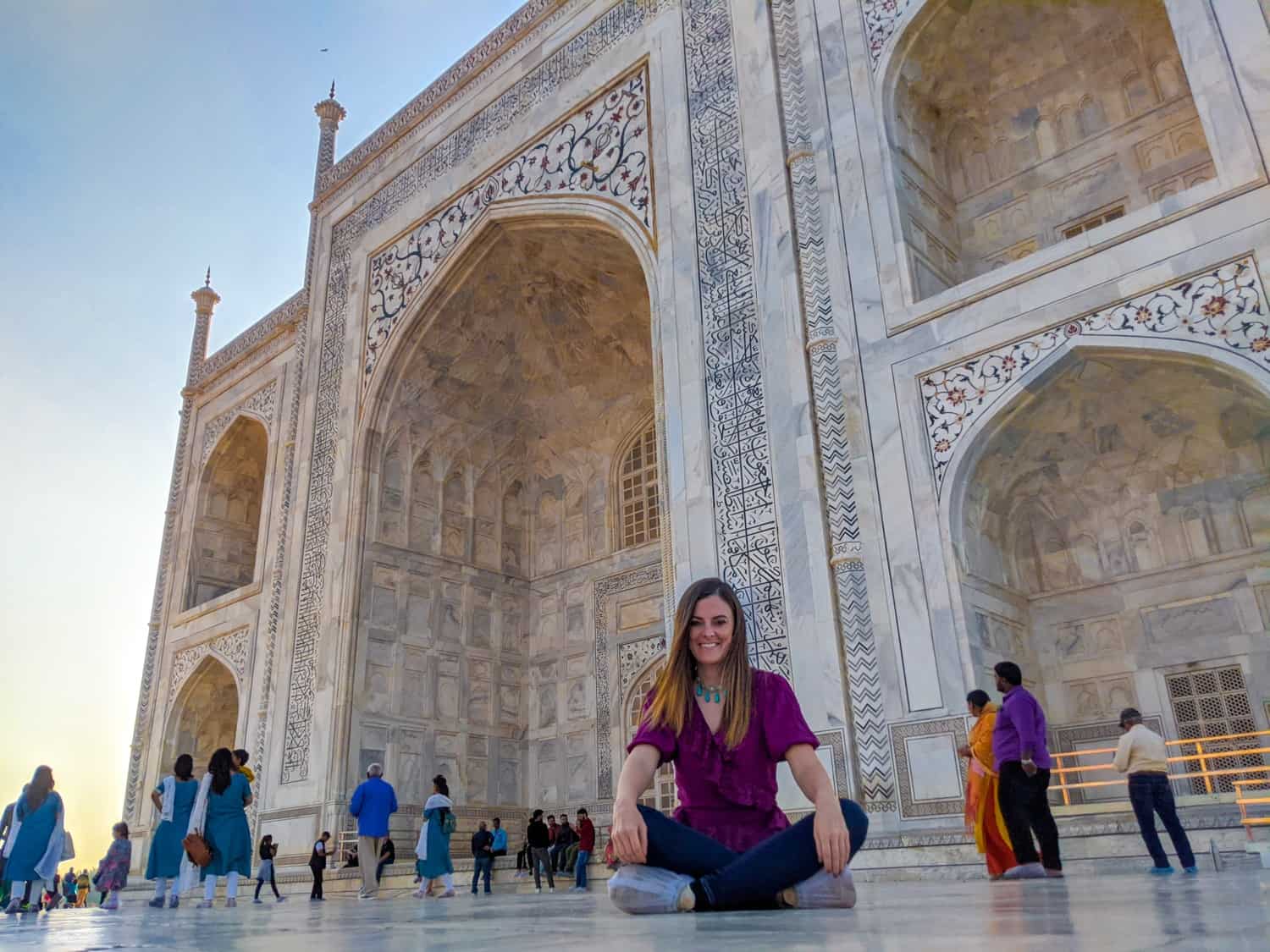
I was so happy to be here.
When I travel, I always try to find the time to put my camera down. It can be all too tempting to live out the most magical moments of your life behind a lens, attempting to capture it all to ensure you don’t forget. It’s especially the case when you’re a travel blogger and want to record everything as much for your readers as for yourself.
But it’s important to forget about the photos every now and then to just focus on the moment.
I found a quiet area of the complex — basically where that photo above was taken — and sat down. From my spot, I could pause and people-watch, observing the schoolchildren and tour groups, watching the expressions on everybody’s faces as they got up-close to the Taj for the very first time. Watching the sun move across the sky and alter the colours on the building. Watching the birds soar overhead.
I sat there for half an hour with Dave, silently, absorbing as much as possible, thinking about how lucky I was to be here right now.
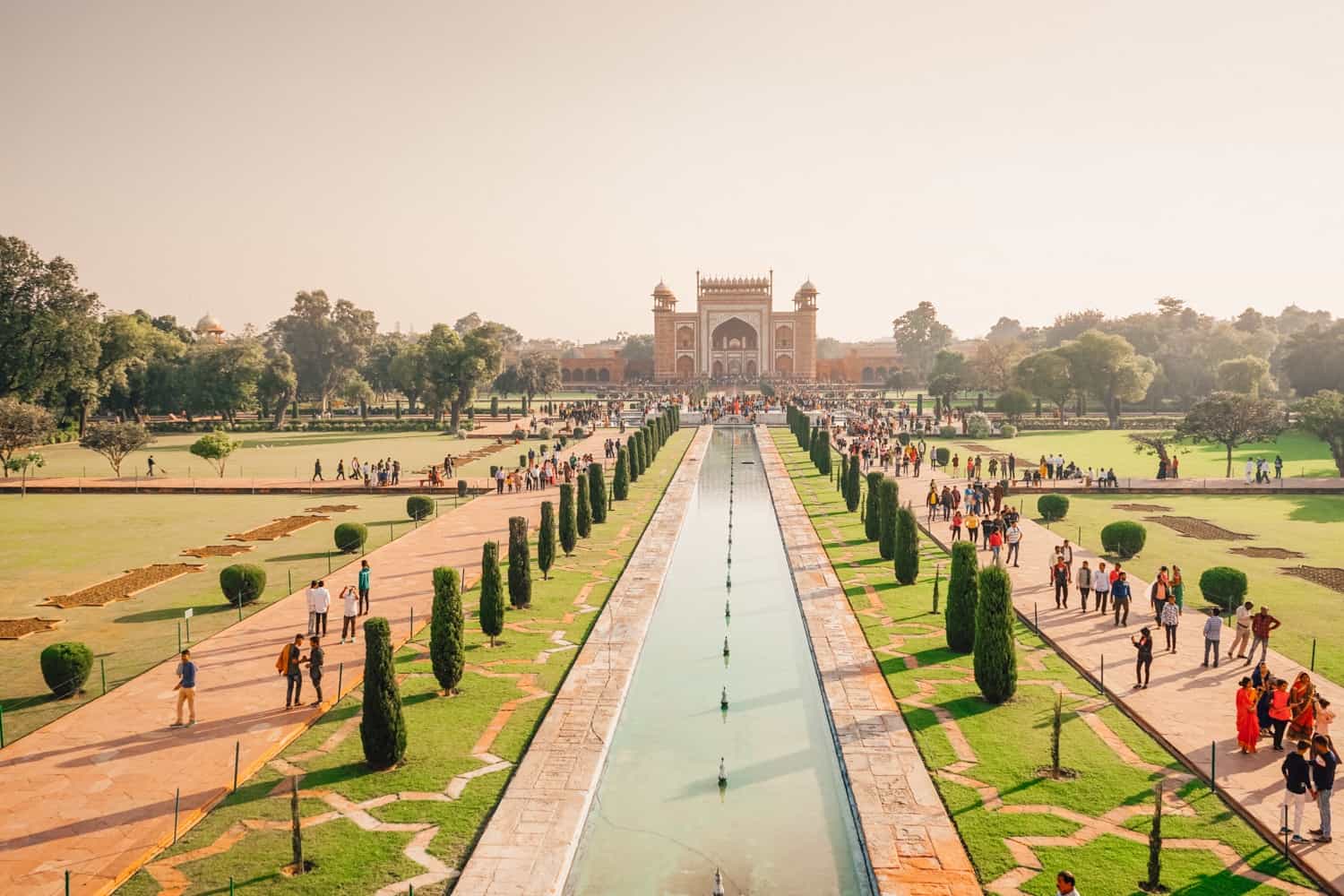
I turned to Dave once I felt ready to move on.
“Are you glad I dragged you here?”
He didn’t have to think about his answer before nodding. “Yep.”
“Isn’t it amazing?”
“It’s incredible. Unbelievable. It’s so impressive.”
And it was.
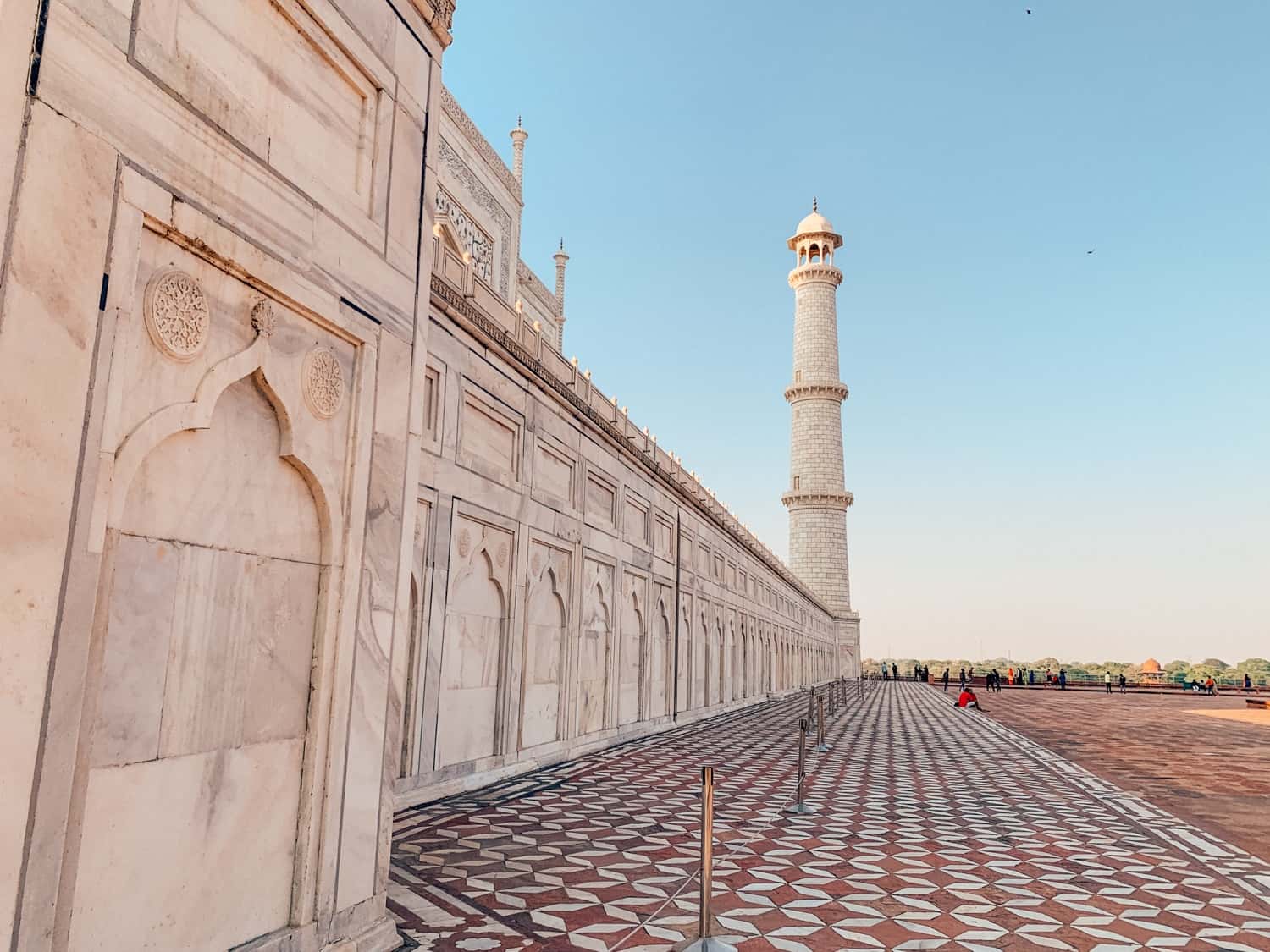
Altogether, I spent two hours at the Taj Mahal.
I thought I’d stay until sunset, but in the end, I didn’t feel the need to. I’d taken all the photos I’d dreamed of; I’d captured the complex from every possible angle in every variation of light.
In fact, I didn’t even feel the need to return the following morning at sunrise. I’d had the most perfect blue skies and the most wondrous light while I’d been at the Taj, and I wasn’t sure that sunrise could top that.
And I also didn’t want to set my alarm for 4:30 in the morning.
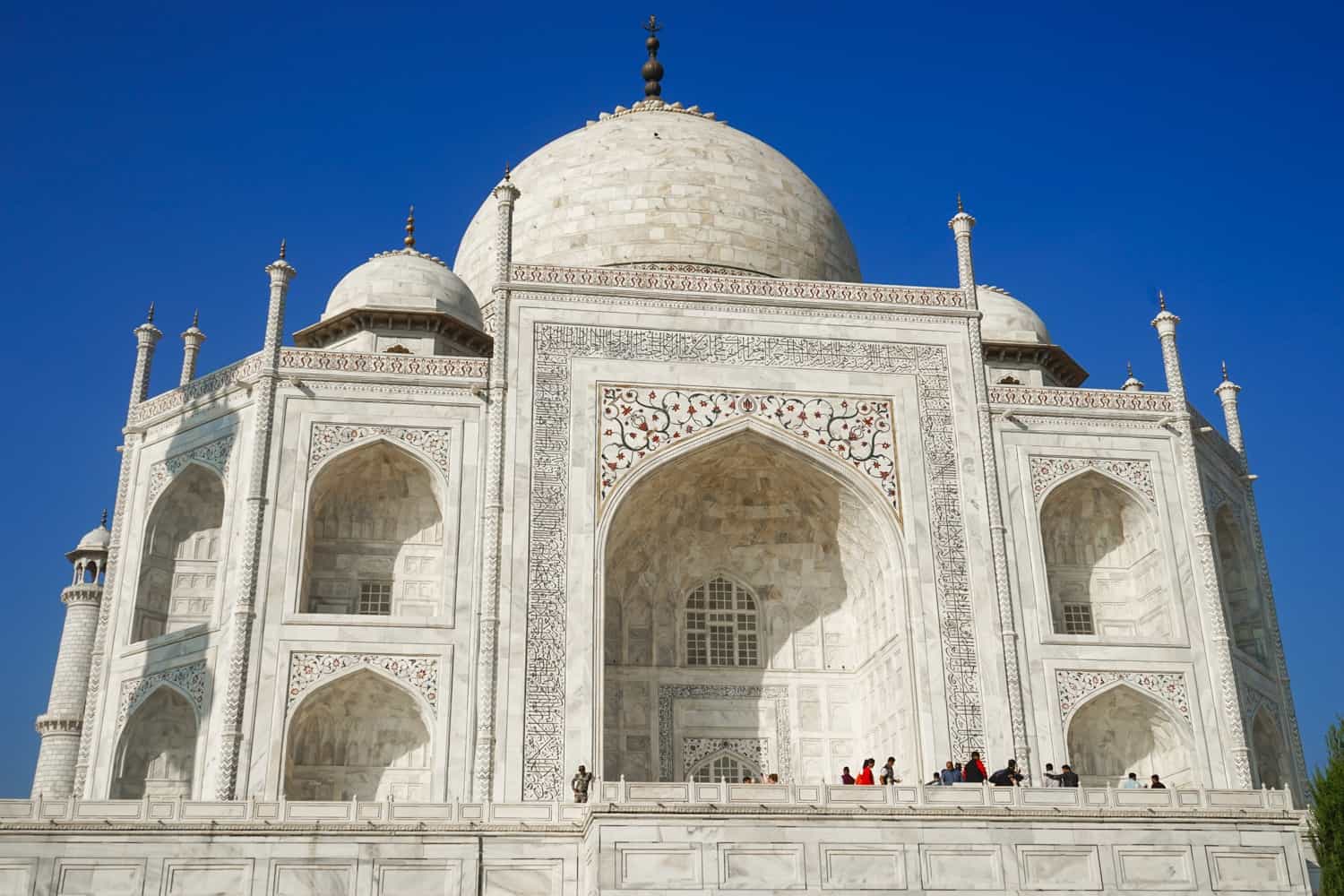
We made one final circuit around the Taj Mahal, took our final dozen selfies with the locals, and I marvelled at how every angle brought a different look to the mausoleum.
The two photos above showcase it perfectly: from one side of the complex, the Taj glistens bright white, and from the other, it’s bathed in a golden glow. It almost looked like a different building as I walked my final circuit.
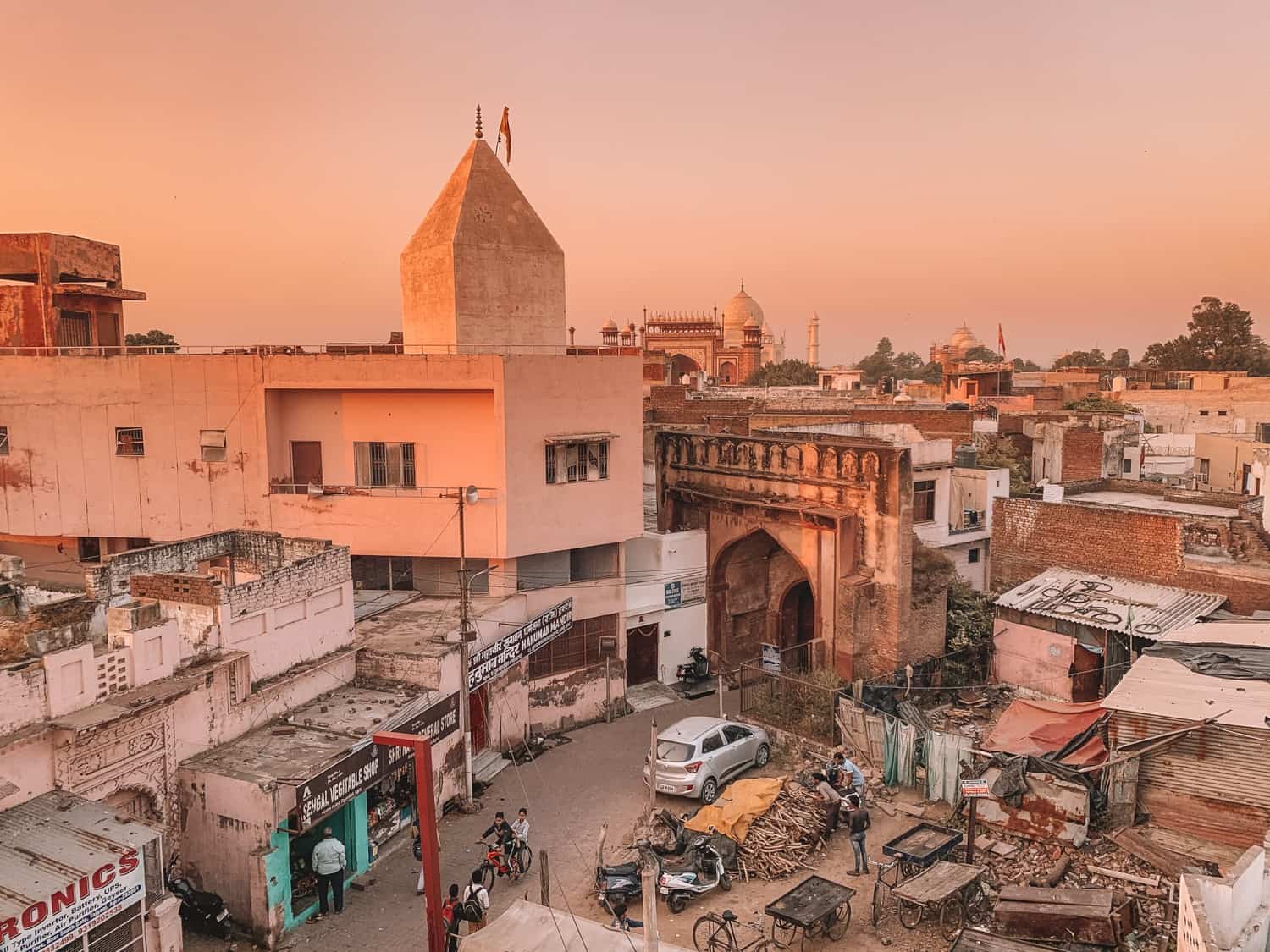
And then, sunset.
Agra is full of rooftop restaurants for obvious reasons: who wouldn’t want to eat a meal overlooking the entire reason why they came to the city?
As you can imagine, the area close to the Taj is pretty touristy and overpriced. The further away you get, the less touristy the restaurants are, but you also don’t want to get too far away, because you still want to have an excellent view.
We stumbled into a random restaurant and while the food wasn’t anything mind-blowing, the view more than made up for it.
It was the perfect end to the perfect day.
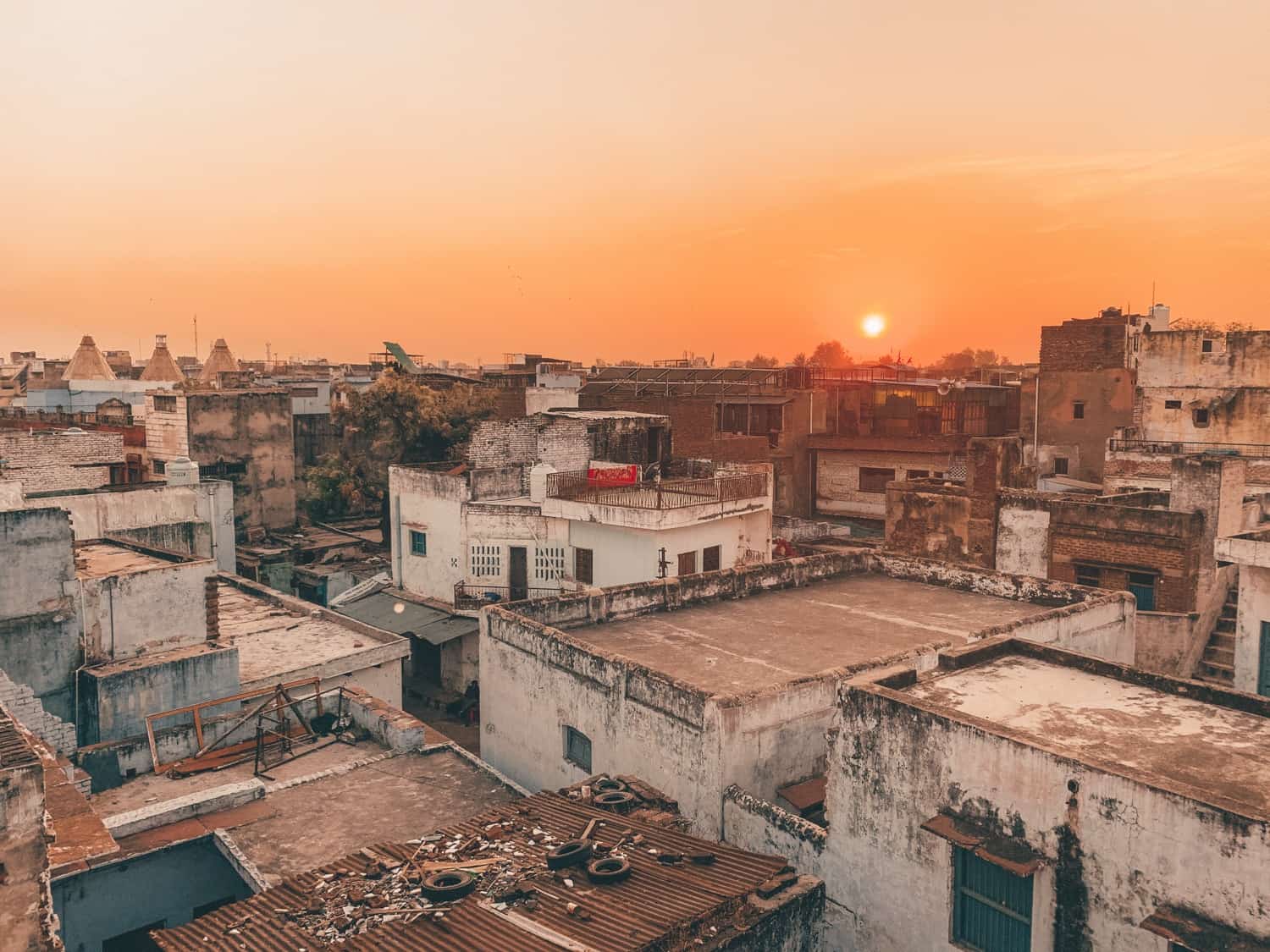
Overall, my entire experience in Agra was amazing . I’d had high expectations for the Taj Mahal, and I was surprised to find them exceeded. The Taj is magnificent and seeing it ranks up there as one of the coolest travel experiences of my life.
I’d even go back.
If, on a future trip to India, I find myself taking a route that will see me passing near Agra, I’d most likely make the effort to spend another day in town.
Maybe next time, I could go at sunrise.
You can visit the Taj during the full moon, too, which sounds particularly epic.
And so, if you’re heading to India and pondering whether it’s worth seeing the Taj Mahal or not, I would obviously say it so is.
It’s one of the most famous buildings in the world for a reason.
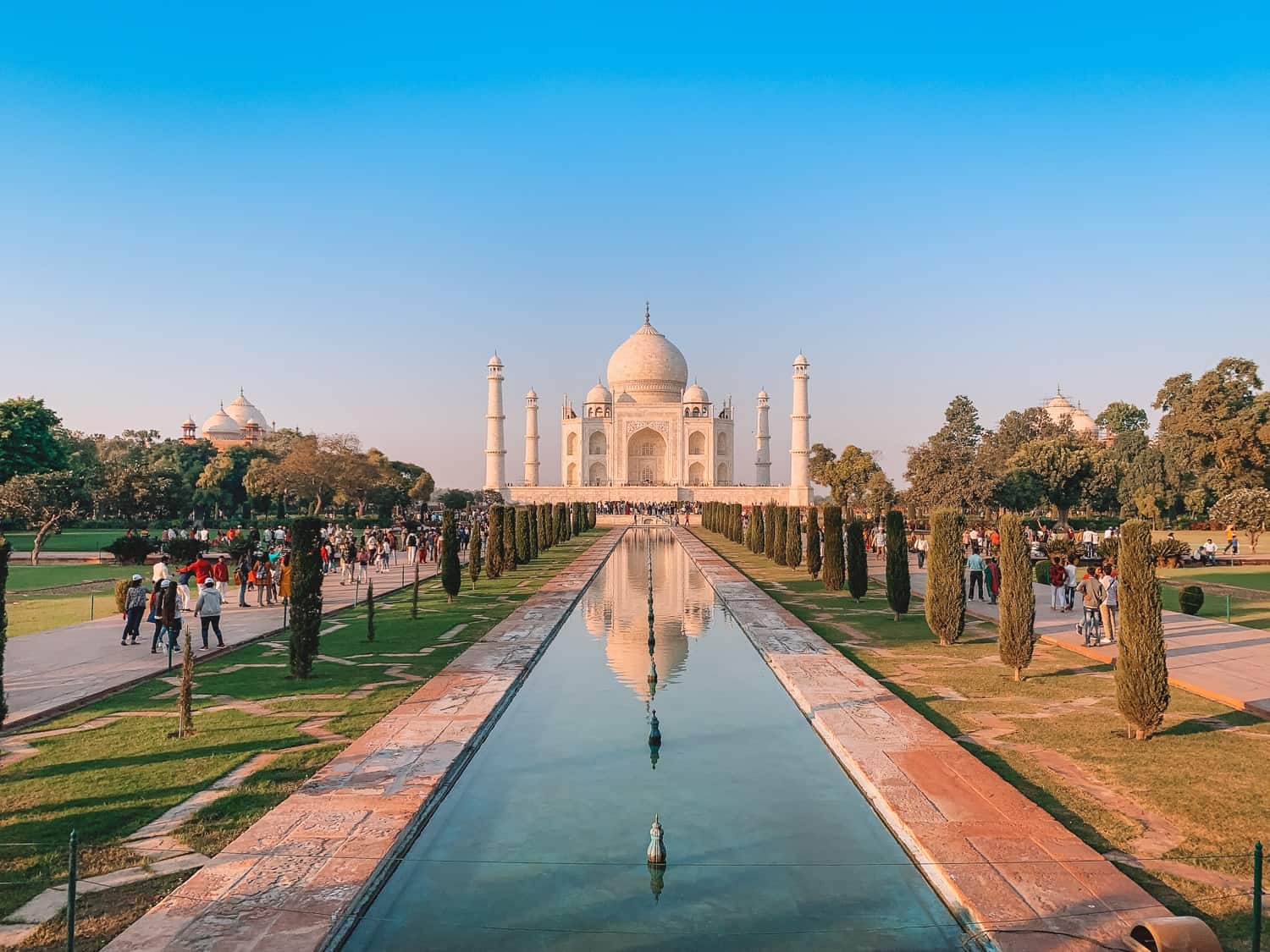
You’ve heard all about my experience; now it’s time for me to share exactly how you can make the most of your time at the Taj!
How much does it cost to visit the Taj Mahal?
It costs ₹1300/$17 for foreigners to visit and ₹ 250/$3 for Indians. For that price, you’ll gain entrance to everything, as well as a bottle of water, a map of Agra, and the mandatory shoe covers.
Children under the age of 15 do not have to pay to enter.
If you’re from SAARC or BIMSTEC countries, you’ll pay slightly less than other foreigners: just ₹ 740/$10 . These countries are as follows: Bangladesh, Bhutan, Maldives, Myanmar, Nepal, Pakistan, Sri Lanka, and Thailand.
Don’t even question if visiting is worth the money: I promise you it is! You won’t regret spending your cash on an experience as magical as this one.
Now, one thing to keep in mind is that the ticket prices mentioned above include a ₹ 200 entrance fee to the mausoleum. I found the mausoleum to be the least impressive aspect of the Taj Mahal, so if you are trying to keep your travel expenses down, you can opt to skip that part of it (I don’t recommend doing so, though!).
What time does the Taj Mahal open?
First of all, the Taj is closed on Fridays: Take note! The Taj Mahal is closed every Friday, so make sure you don’t plan your trip to Agra to coincide with this. There’s a mosque on the grounds of the Taj Mahal, so they close the complex every Friday for people who want to attend the religious services that are held there.
On every other day, the Taj Mahal opens at 6 a.m. and closes at 7 p.m — these times roughly coincide with sunrise and sunset. It’s also open at night for five nights around every full moon, from 8:30 pm until 12:30 a.m. — I really want to do this next time!
You can buy tickets at the Taj from 5:30 a.m. up until 6:30 p.m.
You can also buy your ticket the day before. If you’re planning on visiting for sunrise and don’t want to have to wait in line with everybody else to buy your ticket, you can grab one in advance the day before.
Which is the best entrance for visiting the Taj Mahal?
There are three different entrances: The East Gate, the South Gate, and the West Gate. There are advantages and disadvantages to all three, but I think the best is the East Gate. Here’s a quick rundown:
- The East Gate is most popular with foreign tourists, as it tends to have shorter queues at every time except sunrise. It’s close to a lot of the hotels in the city, so is likely to be within walking distance of where you’re staying. If you’ve grabbed a ticket the day before, you’ll be able to skip the lines.
- The West Gate is most popular with Indian tourists, and has long, long lines throughout the day. At sunrise, though, it’s less crowded than the East Gate, so could be a good option for beating the hordes of people.
- The South Gate is the least popular gate, as it’s next to a chaotic market that’s full of pushy touts, and tends to attract the backpackers, as it’s right next to a ton of hostels. Keep in mind that it doesn’t open until 8 a.m., so this isn’t one to go for if you want to get there for sunrise.
There’s a whole bunch of things you can’t bring in with you: Security is tight at the Taj Mahal, so check your bags the night before to make sure you won’t end up taking anything in that isn’t allowed. You can’t bring in drones, tripods, food and drinks, headphones, as well as electronic equipment and chargers (excluding phones and cameras). During the night viewings, you aren’t allowed to bring phones in with you.
You’ll probably spend two hours in the complex: That’s how long I spent there and I had a solid half an hour where I just sat and stared up at the structure.
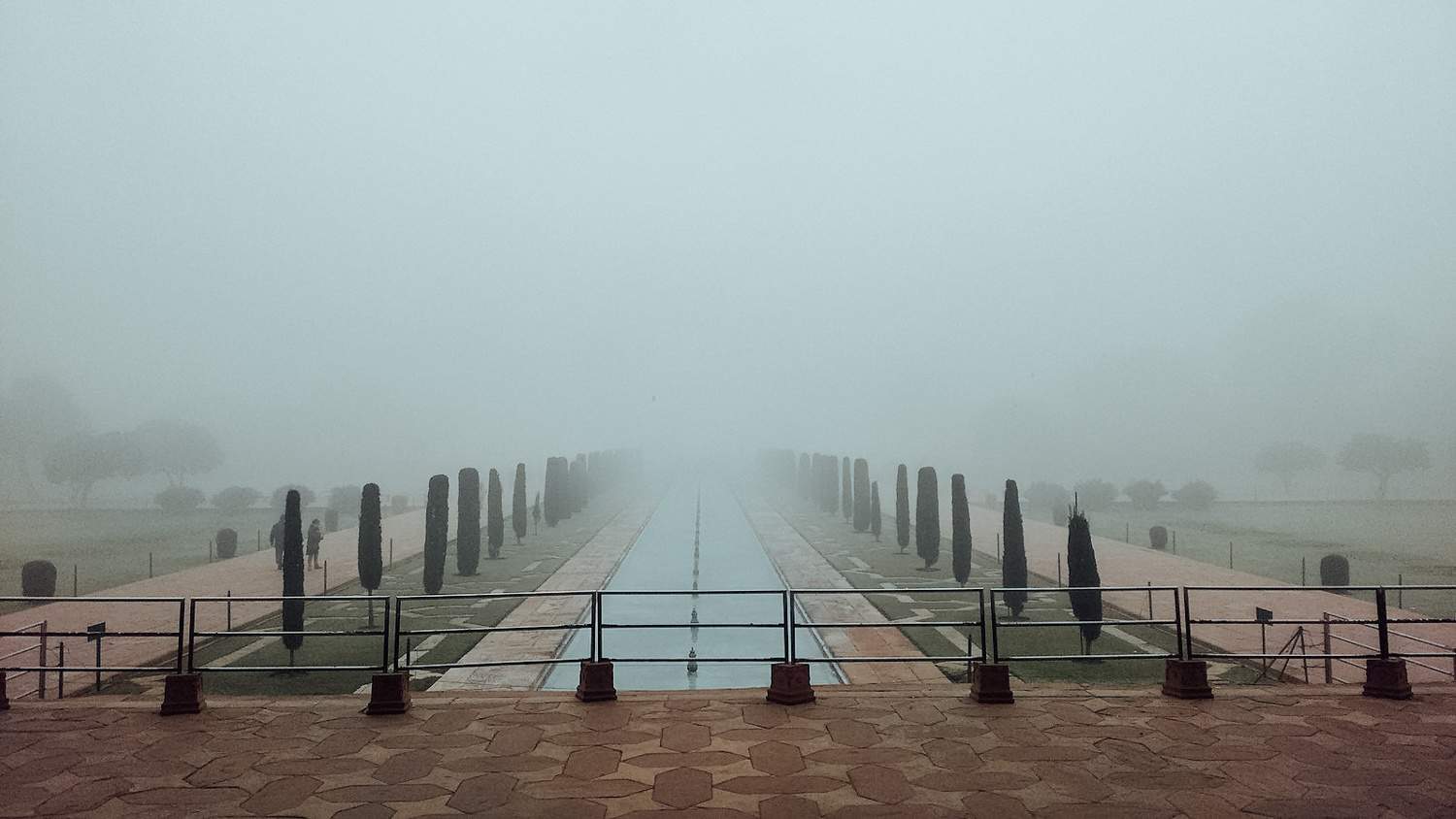
What’s the best time of year for visiting the Taj Mahal?
The best time of year to visit is over winter.
For the majority of my India posts , you’re going to notice that I recommend visiting in winter, but for the Taj Mahal, I think early-or-late-winter would be the best time to visit.
At this time of year, you’re going to avoid the dense fog that rolls in every morning, there won’t be as much smog and pollution in the air, and the temperatures will still be manageable. I’d aim for October or March. While I loved visiting in December, sunrise would have been a bit crap, as air visibility was low in the early mornings.
I’d also recommend avoiding visiting over the weekends and during public holidays, as it’s a lot busier then.
Where to stay in Agra: I stayed in a private room in a gorgeous homestay in Agra for $28 a night. It was within walking distance to the Taj Mahal and the lovely family who owns it had so much helpful advice for making the most of our short stay in the city. The rooms were bright, clean, and airy, and the grounds were full of lush plants. The owners also helped us arrange a driver from Agra to Jaipur via Fatehpur Sikri and Abhaneri to ensure we wouldn’t get ripped off. I definitely recommend staying here while you’re in town.
How to Get to Agra: Most people are going to be hitting up the Taj Mahal while they’re traversing the Golden Triangle, so will typically be coming from either Delhi or Jaipur.
Taking the train from New Delhi to Agra is incredibly easy if you book in advance with 12Go Asia . Tickets for trains are released four months in advance, and it’s a simple process to buy them online. I took the Gatimaan Express — the fastest train in India — that left from Hazrat Nizamuddin station in New Delhi at 8:10 a.m. and arrived at Agra Cantt by 09:55 a.m. Tickets for A/C chair car carriages were just under $16 each and included a breakfast and bottle of water.
Alternatively, the best train from Jaipur to Agra is the speedy Shatabdi Express, which leaves Jaipur at 7:05 a.m. and arrives in Agra at 10:35 a.m.
Now I want to hear from you guys! If you haven’t visited the Taj Mahal, is it on your list? And if you have been before, how did your experience compare to mine?
Related Articles on India 💰 The Cost of Travel in India: A Detailed Budget Breakdown 🇮🇳 12 Reasons Why I Absolutely Loved Rajasthan 💗 Three Perfect Days in Delhi: I Love This City So Much 🙅🏼♀️ How Not to Spend a Day in Jaipur 💛 The Ultimate Guide to India’s Golden Triangle 🐪 Pushkar Travel Guide: 11 Things to Do in Pushkar 🤍 Yes, Udaipur is as Great as Everyone Says 🎶 I Went to a Pink Floyd-Themed Cafe in India
Lauren Juliff
Lauren Juliff is a published author and travel expert who founded Never Ending Footsteps in 2011. She has spent over 12 years travelling the world, sharing in-depth advice from more than 100 countries across six continents. Lauren's travel advice has been featured in publications like the BBC, Wall Street Journal, USA Today, and Cosmopolitan, and her work is read by 200,000 readers each month. Her travel memoir can be found in bookstores across the planet.
Related Posts

The Cost of Travel in South Korea: My 2024 Budget Breakdown

How to Spend Three Perfect Days in Delhi: An In-Depth Itinerary

Pushkar Travel Guide: 11 Things to Do in Pushkar

The Cost of Travel in Cambodia: A Detailed Budget Breakdown

How to Spend Two Weeks in Japan: An Itinerary for First-Time Visitors

The Ultimate Guide to the Trang Islands of Thailand
30 comments.
Sounds amazing! I haven’t been yet but I would love to go one day. Your photos are beautiful!
Thank you so much, Alison! I hope you make it there one day, as it’s so worth seeing in person :-)
I haven’t been to the Taj Mahal but there’s no way I’d miss it whenever I eventually get to India (what on earth was Dave thinking?!) I didn’t know about the morning fog in winter but now I think this is when I’d quite like to see it. I love wandering round places in fog and seeing bits slowly appearing as the mist starts to lift.
It definitely would give you a more unique perspective of the Taj to see it in all of the fog. As long as it lifted after a while, that is!
I’m so pleased Dave changed his mind. I pretty much drag my boyfriend everywhere, he’s happy to stay at home and not go away at all! The Taj Mahal, is just beautiful I can’t wait to see it in real life one day!
Yeah, Dave is a bit like that. He’s never super enthusiastic about any of the trips I convince him to come on, but then nearly always claims they’re some of the best experiences he’s had by the end of it! I couldn’t get my head around him even considering that the Taj Mahal would be something to skip out on!
This is just unreal! I’m glad you decided to go. I appreciate the information about the gates and the trains. Is that smog (pollution) or fog?
A mix of both. There’s obviously pollution, because India, caused by nearby farmers burning off their crops, the huge number of vehicles in cities, the dust emanating from construction sites, locals building fires to keep warm… But also, because the Golden Triangle resides in a land-locked valley, fog tends to settle over the cities during cooler months and can result in a dense haze, especially in Agra.
We arrived in Agra on a Saturday afternoon and had a guide booked for Sunday. But we decided to walk over to the Taj anyway and then decided to go in to see it at sunset. The next morning, we decided not to tell our guide we’d already been! In late January, we got some really cool fog rolling in as the sun rose, which made for some eerie photos. It felt way more crowded in the morning, though, and I think I enjoyed myself more when we went in the afternoon (but that also may have been because I found our guide crazy annoying and seeing your pics from Agra Fort, he totally shortchanged us on viewpoints there!).
Oh, that’s interesting about you finding it more crowded in the morning! Everybody always says it’s least crowded at sunrise and gets busier throughout the day, but I didn’t think it seemed all that choatic in the afternoon. We didn’t even have to queue to get in!
Bummer about the Agra Fort viewpoints and annoying guide, though!
Love the blog and your adventures inspire me to travel more and I have even gone to London alone. Your pictures are amazing. Please stay safe so you can continue to wow and inspire.
The Taj Mahal is definitely on my list. I haven’t been to India, but I’m hoping to make it there sometime in the next few years. I totally understand your point of view about how seeing it in person is so different from seeing it on a screen. I marvel about it all the time when I am traveling.
Thanks for sharing!
I did the Taj for sunrise in summer and while lovely I do think your blue skies were amazing, I wish I had gone back later in the day. I will say it was not crowded for the first 20 min or so and I did get some pictures with only 2-4 other people in the background which was cool. One place I found in Agra that was interesting and a good stop to give back & for a chai for next time: https://www.sheroeshangout.com/
You’ve almost convinced me!! I’ve never been too bothered about visiting India but I’ve enjoyed following your trip there, I’m so glad you loved it after all that time! And your photos here are incredible!
Ah, thank you! I’m totally obsessed with India now. I want to go back so badly!
Great photos, Lauren! And you look like a movie star.
So happy to hear about the shoe covers, both for the protection of the building and because when I visited as a kid I had to take off my shoes, was walking around in my socks and stepped on some bird poop. Still a great experience visiting.
This looks absolutely incredible. And thank you for the guide at the end of the post — it’s useful to have all of that information. I hope to visit myself one day!
Thank you for sharing! I love the photos!
This was such a helpful post, Lauren! I would love to see the Taj Mahal, so it’s good to hear that you enjoyed your time there and felt that it was worth the visit. I’ll be using this guide when I finally travel to India.
All of these photos are stunning. The architecture of this historical tomb and the fort are simply divine. Amazed!
Thanks so much! It was easy to take good photos when the subject was so beautiful :-)
Lauren, a great review of your trip to the Taj! It brought back many memories. I was in Delhi for business and had one non-meeting day during the week, so I hired a car/driver who took me to Agra and back. I was mesmerized. I spent over five hours taking it all in. The sky was brilliant blue, the only day of the week I was in country that was not hazy/polluted. The sun reflecting off the white marble was so brilliant, I kept trying to put my sunglasses on, even though I was already wearing them! My favorite part, after walking around it twice, was sitting in a quiet spot and people watching. It felt surreal to be alongside this iconic structure I had seen my entire life.
Taj Mahal is the most stunning monument of the world. Did you know it one of the most expensive projects of the 16th century? Your photos are beautiful.
I hope that the local visitors at Taj didn’t freak you out for photos with them though I can see one has got the chance.
I have been to Taj thrice from Delhi (Nizamuddin railway station) and if I get to visit there more, I will surely. And wonderful that you dragged Dave along, else he would have missed such a beauty.
“It’s almost as though your brain just assumes you’ve entered a TV screen and are walking around inside. That feels more plausible, in a way, than actually being there in person.”
You summed up my experience of seeing Taj for the first time perfectly. I’d always imagined it to be a “medium-sized” structure, and needless to say, was blown away by the sheer size of it once past the gate.
Thanks. It was a beautiful write-up and the photos are incredible too.
I am from India and I am yet to visit the Taj Mahal. Loved the photo taken at the archway – The Taj shining to its glory. Thanks for the guide though!
I visited the Taj Mahal about 3 years back with wife which I had visited it over 40 years before on a school trip and was mesmerized by the experience. The only thing I would like to add is that I also hired a local guide to take me around the Taj and it just makes the whole experience so much better. My guide had charged me less about 300 Indian rupees which would about $4 US. The added bonus was that he took our pictures also throughout the tour and those pictures were so much better than what I would be able to take. Throughout my trip in India, I would always hire a local guide that would explain to me everything (even though a lot of the information is available online) and I would highly recommend it to anyone visiting historical locations.
Lovely post. but I hate Agra. if it weren’t for the Taj I guess nobody wants to go to Agra.
By the way, there are apparently government prepaid rickshaws available for hire. but its 250 to and back from agra cantt. which, if you are only going to see the taj, is fair.
I had 10 hours in Agra because my train leaves at 6pm. So I hired the rickshaw for the day, at 600 INR, expecting to see Taj, Agra Fort, Baby taj, some food, at least. The advantage of having a rickshaw for the day is I left my backpack with water in there. I dont have to go hire lockers etc.
But turns out, the 600 day rate only covers taj and agra fort, and then you’ll be brought to many shopping places. Not even Baby Taj. Its definitely not worth the 600.
My advise would be, try to take sharing rickshaws. single trips. Agra fort is 2km away from the Taj, its walkable if you want. The other spots are a lot further away.
But yeah, dont do the shopping trips. and dont do the lunch. Butter chicken with briyani cost me 580. How can you not hate Agra?
Make sure to be clear of your itinerary with the driver if you’re going for the 600-8hrs-a-day.
Thanks for this post, AND your Qatar rave which has us seriously considering stopping there on our way to Vietnam / Cambodia / Laos / Thailand next January.
The TM was UHmazing, and everything you wrote is true. What I didn’t know was that it’s a PERFECT ensemble – the gardens, the gates, the flanking palaces…and nothing at all behind the Miracle that it is. Also – those walls are FLAT. It’s all about the inlay. We’re so used to cornices and balconies and lintels and so on….just wow.
Last but not least – doesn’t look like you made it to the ‘Baby Taj’ but it’s 10/10 highly recommended. Our tour went there first, and then to the garden across the river. Perfection. Thanks again for you posts!
Leave a reply Cancel reply
Your email address will not be published. Required fields are marked *
National Geographic content straight to your inbox—sign up for our popular newsletters here
- WORLD HERITAGE
This Colossal Tomb Is an Enduring Monument to Love
According to legend, Shah Jahan's favorite wife bound him with a deathbed promise to build her the most beautiful mausoleum ever known.
The Taj Mahal is widely considered one of the most beautiful buildings ever created. The exquisite marble structure in Agra, India, is a mausoleum, an enduring monument to the love of a husband for his favorite wife. It's also an eternal testament to the artistic and scientific accomplishments of a wealthy empire.
Shah Jahan, “the King of the World,” took control of the Mughal Empire throne in 1628 very much in love with the queen he dubbed Mumtaz Mahal or “Chosen One of the Palace.” The poets at Agra’s Mughal court said her beauty was such that the moon hid its face in shame before her.
The Mughals were at the peak of their power and wealth during Shah Jahan’s reign, and India’s rich lode of precious gems yielded him much wealth and power. But he was powerless to stop Mumtaz Mahal’s death during childbirth in 1631. Legend has it that she bound him with a deathbed promise to build her the most beautiful tomb ever known.
World Heritage Site Pictures: Taj Mahal

Promise or no, Shah Jahan poured his passion and wealth into the creation of just such a monument. It is said that 20,000 stone carvers, masons, and artists from across India and as far as Turkey and Iraq were employed under a team of architects to build the Taj Mahal in the lush gardens on the banks of Agra’s Jamuna River. They completed the epic task between 1631 and 1648.
While the arch-and-dome profile of clean white marble has become iconic, other beauties lie in the Taj Mahal’s painstaking details: inlaid semiprecious stones and carvings and Koranic verse in calligraphy create an enchanting interior space where Shah Jahan came to visit his wife’s remains before he was eventually interred at her side.
The Taj Mahal’s familiar marble domes are framed by four minarets from which Muslims are called to prayer. Each is designed with a slight outward lean, presumably to protect the main mausoleum in case one of them should collapse.
Two red sandstone buildings also flank the main mausoleum on either side. One, to the west, is a mosque. The other is a former guesthouse.
These buildings are set within lush gardens, complete with an enormous reflecting pool that regularly does what no human has ever been able to accomplish—duplicate the beauty of the Taj Mahal.
Shah Jahan himself gazed upon that beautiful image until the end of his days—but as a prisoner, not a ruler. His son Aurangzeb seized the Mughal throne and imprisoned his father in Agra’s Red Fort (itself a World Heritage site and popular tourist attraction). Whether as consolation or torture, Shah Jahan commanded a view of the Taj Mahal from his window.
How to Get There
Agra is a major city in the Indian state of Uttar Pradesh and well accustomed to visitors—some three million people visit the Taj Mahal each year. The city is accessible by bus, train, and (limited) air service and has a wide range of tourist amenities. Access to the Taj Mahal complex is on foot.
When to Visit
The Taj Mahal is a year-round attraction and often busy, though new ticketing systems have thinned crowds at peak times. Visitors in search of more solitude might try coming early or late in the day. One time NOT to visit is on Friday, when the Taj Mahal is closed.
- Nat Geo Expeditions
How to Visit
The mausoleum’s interior is a striking (if smallish) space that begs some leisurely exploration. But a good part of any visit to the Taj Mahal will be spent looking at the building from the outside. The mausoleum’s clean white marble shifts in color and tone to match the mood of the world outside—a transformation so enchanting that it’s worth lingering to gaze at the building in different conditions, such as the rosy glow of dawn or the magical light of a full moon.
FOURTH OF JULY SPECIAL
Get National Geographic magazine for $10 off
Related Topics
- WORLD HERITAGE SITES
- ARCHITECTURE
You May Also Like

Salman Rushdie on the enduring beauty of the Taj Mahal

Searching for traces of the ancient Chola dynasty

Think ‘Bridgerton’ or ‘Saltburn’ are scandalous? Here’s the sordid history behind these English country homes

How to plan a road trip in the Bavarian Alps

How to plan a design-focused cycling tour of Malmö, Sweden's third-largest city
- Environment
History & Culture
- History & Culture
- Mind, Body, Wonder
- Interactive Graphic
- Paid Content
- Terms of Use
- Privacy Policy
- Your US State Privacy Rights
- Children's Online Privacy Policy
- Interest-Based Ads
- About Nielsen Measurement
- Do Not Sell or Share My Personal Information
- Nat Geo Home
- Attend a Live Event
- Book a Trip
- Inspire Your Kids
- Shop Nat Geo
- Visit the D.C. Museum
- Learn About Our Impact
- Support Our Mission
- Advertise With Us
- Customer Service
- Renew Subscription
- Manage Your Subscription
- Work at Nat Geo
- Sign Up for Our Newsletters
- Contribute to Protect the Planet
Copyright © 1996-2015 National Geographic Society Copyright © 2015-2024 National Geographic Partners, LLC. All rights reserved

Are you Looking for a Tour Guide in Agra?
Get in touch by Email or Call on the address given below to Find a Government approved tour guide in Taj Mahal, Agra.
64, Taj Road, Agra - 282001
191, Mall Road, Agra - 282001
Guides may help you in exploring Agra & around in a better way . Guides will also tell you about excursions, attraction, things to see , activities to enjoy , best itineraries as per your timings & much more.
But please ensure that you are hiring a government approved guide. You can ask guide to show his / her identity card if not satisfied then you may contact to the govt tourist offices.
Know the Agra
Discover taj, official contacts.
+91 0562 2226431 10:00 AM to 5:00PM
+91 562 2421204 06:30 AM to 09:30PM
UP Police Helpline
History Fangirl
The Ultimate History Travel Blog Since 2015
Planning a Trip to the Taj Mahal: 13 Essential Taj Mahal Travel Tips for First-Timers!

Last Updated on: 15th January 2023, 09:41 pm
Are you planning a trip to India and need a guide to spending one day at the Taj Mahal? Use these Taj Mahal tips to plan your visit to one of the most famous buildings in the world!
This travel guide is going to help you quite a lot with basic concerns that first-timers have when coming to India and are planning a trip to the Taj Mahal, which can feel a bit overwhelming at first!
Can’t read now? Pin for later!

Good to Know: This guide to the Taj Mahal for first-timers comes to us from a Local Contributor from the area who wishes to remain anonymous but hopes you have a wonderful time in their country!
My Favorite Travel Booking Sites for 2024
These are my favorite companies that I use on my own travels.
Protect Your Trip via Safety Wing
Find the best city tours, day tours, bus tours, & skip-the-line tickets on GetYourGuide and Viato r .
Find the best deals on hotels & vacation rentals on Booking.com .
For English-speaking private airport transfers, book through Welcome Pickups.
For road trips and independent travel, rent a car through Discover Cars .
Find information and cruise reviews on Cruise Critic.
For packing and travel essentials order via Amazon .
Book an affordable family or romantic photography session on your trip through Flytographer (Use the code HISTORYFANGIRL for 10% off your first photoshoot).
For travel guidebooks to have with you during your trip, I always pick one or two from Rick Steves and Lonely Planet.
Essential Taj Mahal Tips for First-Timers
Make sure you come to India prepared to visit the Taj Mahal, a place that should be on everyone’s India Bucket List!
How to Get to the Taj Mahal

It has a beautiful history and a majestic sight. And it is even easier to get to than you might think!
You may start your journey through Air India Express Booking and land directly to the capital of New Delhi! This way you will have enough time to rest and start your exploration excitedly.
Most Taj Mahal visitors start their trip to New Delhi.
New Delhi is well served by European and American international airlines and is a global metropolis with many sights and lodging choices.
The Taj Mahal is most commonly visited as a day trip from Delhi.
Agra is well connected by rail. The main railway station is Agra Cantt.
High-speed Shatabdi Express services operate from Delhi, Varanasi, and cities in Rajasthan.
The Taj Mahal – A Historical Background

Here is a brief historical background of the Taj Mahal and how it was built.
The Taj Mahal is a symbol of love and is considered to be called like this after the Mughal emperor Shah Jahan commanded to build the mausoleum in the loving memory of his wife Mumtaz Mahal.
When his wife Mumtaz Mahal died all of a sudden during the birth of her 14th child.
The marble and stones that were used in the building were semi-precious and some rare ones as well.
It was built after 20 years of her death and like, you can say it took 20 years for this building to be ready.
And then afterward it became one of the seven wonders of the world.
Beware that Agra is Expensive Compared to Other Parts of India

Here is one of the first tips for your travel guide that doesn’t buy anything from Agra.
The shops here are mostly tourist traps and they sell quite expensive things compared to places nearby like New Dehli.
If you are in Agra just try to wander around and explore the place and visit the Taj Mahal because there are not many other places to visit in Agra besides it.
There are also some restaurants and food stands near the Taj Mahal but they are expensive and don’t have the best atmosphere.
I personally find them highly unpleasant because of the constant harassment by touts.
So try to go after taking your meals at the hotel where you are staying.
Wear Good Shoes Because You have to Visit The Taj Mahal On Foot

There are not any car or cab services around the Taj Mahal that can take you up close to the Taj Mahal.
It is really not allowed and moreover, there is no space because of the crowd. So you have to take the route on foot.
However, this walk is amazing. There’s nothing like arriving at the Taj Mahal!
You should wear some easy and light wear shoes which can allow you to walk for longer if needed.
I recommend wearing casual footwear/shoes so you won’t be tired at the end of your long day.
You can also stroll around the area and take pictures but stay aware of your surroundings.
There’s about a 10-minute walk from the main car parking area if you are coming in the cab or your own vehicle at the Western Gate to the Taj Mahal.
You can take a rickshaw or tuk-tuks, but try to negotiate for the sake of your wallet, otherwise, you will get monstrously ripped off.
How Much Does it Cost to Visit the Taj Mahal: Entrance Fees

Yes, there is going to be an entrance cost for visiting the Taj Mahal and it will be different for locals than foreign tourists.
For foreigners, the tickets cost INR 1050 with an additional NR 200 to see the main mausoleum. This equals about $17 for the ticket that includes the mausoleum.
For Indians, the cost is INR 45 with an additional INR 200 to see the main mausoleum.
All children, foreign and local, below the age of fifteen are free.
Like many other countries where tourism is high, they do charge quite a lot on the most visited sites, and this way they earn money for the maintenance of the site and support their economy.
Buy a Skip-the-Line Ticket for the Taj Mahal
How to Get into the Taj Mahal

The Southern Gate, the Eastern Gate, and the Western gate are the principal entrance gates of the Taj Mahal. Separate lines for foreign travelers and local travelers are available at each entrance.
East Gate : tickets are available for one hour before dawn until 45 minutes before sunset.
The West Gate : this is the primary entrance of the Taj Mahal, facing the city of Agra.
It is also frequently the busiest during the day, however, it is a wonderful option if you’re intending to visit at sunrise.
You can get tickets here starting one hour before dawn.
The South Gate: This gate is located near the main market, which means it can be crowded because of the customers or sellers.
One drawback to the South Gate is that it opens at 8 o’clock in the morning so if you have planned to visit the Taj Mahal at sunrise, you won’t be able to do that from this gate.
Visiting the Taj Mahal on a Budget

If you are visiting the Taj Mahal on a budget, there are a few ways to save some money.
You can even enjoy street food within a suitable budget and at many affordable and cheap rates.
You may save more money if you are a well-versed India traveler. Going solo, traveling slow, and visiting on your own are ways to save some money.
On the other hand, a planned tour can make your day feel much easier to plan, so its up to you whether to save money here or to splurge on a guided Taj Mahal tour.
It might not be as expensive as you think!
See all private and group Taj Mahal tours.
What Is The Best Time To Visit The Taj Mahal?

This might be the best question because the crowd at the Taj Mahal can be overwhelming sometimes and for foreign visitors, it is not easy to predict the best and suitable times to visit.
I recommend getting up a little bit early in the morning and reaching there around 6 am. Like sunrise at Angkor Wat, the Taj Mahal is just special in the early morning.
Sometimes the crowd is huge too but you can try your luck and if you want you can hire a tour guide because they have their own tactics to avoid the long waiting line for entry and you can get the access easily and early.
Another trick is to buy a Skip-the-Line Ticket for the Taj Mahal ahead of time so that you won’t get stuck in the crowd trying to get in.
Though the sun rising view is majestic in the Taj Mahal tomb, many people reach there early just for the view. So if you are staying in Agra you can try this too.
Each day, the Taj Mahal is open from 30 minutes before dawn up to 30 minutes prior to sunset.
Be careful! As I already said, a Skip-the-Line Ticket is worth it. If you stay in Agra, the driver can wait for you at your hotel and organize a cab or Tuk Tuk to reach the place.
What to Bring with You to the Taj Mahal – Just Necessities!

If you are visiting the Taj Mahal for the first time then this tip is for you.
Do not bring the food because no food is allowed inside the Taj Mahal.
Make sure to bring your phone, camera, sunscreen, wallet, ID, and other basic necessities. However, don’t pack a lot that you won’t need. Note that photos are not allowed inside the Taj Mahal itself.
Try to be aware of these tips when entering the Taj Mahal. You don’t want to end up stuck at security instead of viewing the magnificent sunrise!
The Best Taj Mahal Photo Spots

You might be wondering about the perfect picture at the Taj Mahal as the whole structure is in white marbled color and you are not allowed to capture the inside of the tomb.
So what could be the best place to capture travel memories?
The best pose can be the landscape of the building and you can choose to wear some dark and bright loud colors so this way your selfie with the white sparkly background can be perfect to go with.
You can also get creative and look for ways to get more special pictures together.
Good to Know: If you will be in Jaipur or Mumbai on your trip, you can book a local photo session through Flytographer (Use the code HISTORYFANGIRL for 25% off your first photoshoot).
How Long Should You Spend At The Taj Mahal?

The new time limit for the visit of the Taj Mahal by the UNESCO World Heritage Committee is established as a precaution to prevent overpopulation and damage.
The extra fee of the initial ticket price will be payable for those staying longer than 3 hours. The number of visitors is likewise limited to 40 thousand daily.
If you plan to stay in Agra for a few days then you can visit the Taj Mahal multiple times for a brief time.
This way you can visit it at different times of the day like evening view, morning view or maybe rainy view.
Plus if you are not planning to stay in Agra then it’s also suitable to spend around 2 to 3 hours in the Taj Mahal, which is quite enough for one person to explore the whole place.
What To Wear When Visiting The Taj Mahal?

Here I would recommend wearing some traditional dresses as the locals wear. If you want to wear a traditional Indian Sari and can do it respectfully, then this is one option.
Obviously, you can wear any other thing if you want to but wearing a traditional sort of dress can actually save you from getting into the tourist traps and you may avoid unnecessary attention too.
You can wear colorful loud and bright colors which can be contrasted in front of the Taj Mahal.
Besides the color and all stuff, dressing depends on the season as well.
If you are visiting India in summer then obviously you need to wear light clothing because sometimes the temperature gets high (unexpectedly high).
So it’s always better to get a glimpse at the temperature before leaving for the day.
Winter is the same – unpredictable. Sometimes it is very cold and chilly outside or sometimes maybe not too much cold so you can decide what to wear that day.
Pack layers just in case the weather changes.
Safety Travel Tips for Taj Mahal

There is no smoking or alcohol use at the Taj Mahal.
Try to be aware of guides and tourists around the site, though the travel guides are somewhat very helpful. However, there are also some fake guides too.
Make sure to behave in a way where you don’t stick out. Keep your money safely tucked away.
I carry the Pacsafe Citysafe backpack, which is especially great for tourist destinations. It has many anti-theft features designed to deter pickpockets and RFID technology to keep your credit card digits safe.
5 Things You Need to Pack for India

The Lonely Planet India guidebook. It can be kind of a pain to find the major guidebooks once you land, or you’ll find them overpriced. I always like to pick mine up ahead of time.
An Unlocked Cell Phone so that you can use a local sim card while here to help navigate public transportation and when you’re on the road.
Backup Charging Bank for your cell phone since you’ll be using it as a camera, GPS system, and general travel genie.
A Camera since India is beautiful! I use a mix of my Sony ZV-1 and my iPhone 12 Pro smartphone these days.
A Waterproof Passport Holder so that if something happens when you are near the water, your passport and important IDs don’t get wet.
I’ve seen people denied boarding on flights due to wet passports, and you can technically not be allowed to go over the border.
A Great Day Bag so you can carry what you need with you (like your camera, snacks, water, sunscreen, cash, etc).
My current favorite is the Pacsafe Citysafe , which is especially great for India because it has many anti-theft features designed to deter pickpockets.
It also transitions to a night bag more easily and won’t embarrass you if you go to dinner directly after sightseeing all day.
More India Travel Resources

Here are more resources to help you plan your trip to India.
India Country Guides
To get excited before your trip, check out this guide to the Best Bollywood Travel Movies.
To help you decide what to buy in India, check out this Indian souvenirs guide.
For your Instagram and travel inspiration, check out these beautiful quotes about India and funny puns and jokes about India .
Mumbai Guides
Headed to Mumbai? Enjoy these funny puns and jokes about Mumbai.
Agra & Taj Mahal Guides
Visiting the Taj Mahal? Check out these Taj Mahal travel tips, beautiful Taj Mahal quotes, and the best puns and jokes about the Taj Mahal.
India is Included in These Round-Ups
The Most Beautiful Castles in the World
Cheap Travel Destinations for Students
The Most Beautiful Mosques in the World
Before Your Trip – Don’t Forget About Travel Insurance!
Whenever I go on a trip, I always make sure to get travel insurance!
This is especially true for trips where I’m visiting big cities or spending time in the great outdoors!
The company Safety Wing is the travel insurance company I always look to first, and I happily recommend them!
I always make sure to get travel insurance whenever I’m going to be over one hundred miles from home, in large cities where tourists can be the target of pickpockets, and anytime I’ll be doing outdoor activities.
It makes my life easier knowing if something should happen, I’ll be able to take care of it!
Get a travel insurance quote for your trip here.
Pin this Guide to Planning a Trip to the Taj Mahal for Your Travels in India!

In this Article:
Leave a Comment Cancel reply

Plan the Perfect Taj Mahal Visit in 7 Steps
The Taj Mahal is India’s most iconic, historic attraction. The distinctive, pure white and symmetrical pillars that surround the ornate, domed mausoleum are instantly recognizable across the world.
This Muslim tomb, built by a king to remember his lost wife, is a building that has long captured the imagination of travelers and romantics who make the journey to Agra for a firsthand Taj Mahal visit.
With its enduring popularity though, the Taj Mahal can at times seem like a daunting and crowded place to visit, with long queues to match the lengthy pillars.
It’s a sight though that just has to be seen. The Taj Mahal truly is famous for very good reasons. To help you to make the most of your Taj Mahal visit, here’s our practical guide for traveling to India’s most famous attraction.
Don’t leave home without: Lonely Planet India (Travel Guide)

How to Travel to the Taj Mahal
Table of Contents
The Taj Mahal is located in the city of Agra, a major city that’s found in the north of India in the large province of Uttar Pradesh.
Agra was once the capital of the Islamic dominated Mughal Empire and was once the most important city in northern India.
Times changed, but Agra remains world-famous for the Taj Mahal and as such has become an important stop on the tourist trail, with excellent transport links connecting the city to the rest of the country.
Read reviews and check prices with our Hotel Search Engine , that gives you the best hotel deals found on the web. Our search engine pulls results from all of the major booking places, including Expedia, Hotels, Booking and more. All the options, all the deals, all in one place and just for you.
Agra is one of the major stops on the famous Golden Triangle route, which takes tourists from Delhi to Agra and then onto Jaipur, for a fast-paced look at the diversity of this historic region of India.
From Delhi, it’s a distance of 150 miles to Agra. There are plenty of trains every day, with the fast express route taking as little as two hours. By taking the express train you could even make a Taj Mahal visit in a day from Delhi if you were particularly short on time.
Buses are more frequent than trains, but you can expect the road journey to be slower than the express train option, with a travel time of at least four hours.
Search for Flights: Priceline or Skyscanner offers great deals to India.

A Brief History of the Taj Mahal
The Taj Mahal is one of the most historic sights to see anywhere in India, and it helps to know at least a small part of the intriguing story that led to its construction, in order to appreciate the majesty of the Taj Mahal even more.
In the 16th century, the Mughal Empire swept across India from the plains of Central Asia, asserting their dominance over the subcontinent and bringing Islam with them.
Agra was made the capital of this vast empire and during the reign of Shah Jahan who ruled from 1628 to 1658, much of the city’s now iconic architecture was designed and commissioned, including the Taj Mahal.
Shah Jahan’s wife, Princess Mumtaz Mahal, died unexpectedly during childbirth in 1631, leaving her husband and emperor distraught. To help to overcome his grief, he decided to build the grandest building in Agra to commemorate her memory. This became the Taj Mahal.
Leaving out no expense, the Taj Mahal was built from pure marble, using the best materials and architects from across the Mughal Empire and due to its lavish and opulent design, it took twenty years before it was completed.
The Shah’s wife was laid to rest inside the huge, marble-clad tomb, and when the Shah himself also passed away in 1666, his family laid him to rest next to his beloved wife, and today the couple still lie next to each other.
Related Article: 21 India Photos That Will Blow Your Mind
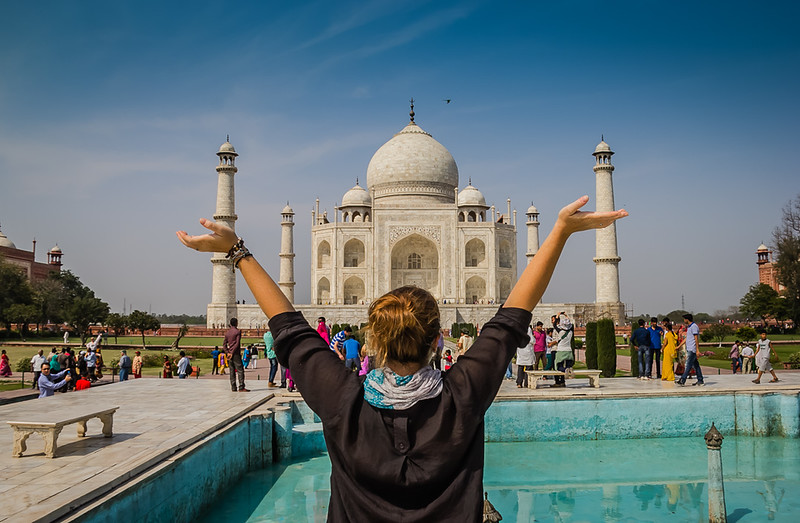
Best Time to Visit the Taj Mahal
The best time to make your Taj Mahal visit is in the dry, winter season that runs from November to March when the weather is pleasant and there’s little chance of rainfall.
The rest of the year, you can expect to experience wet weather, particularly during the heavy monsoon season which is usually expected between June and September which also when things are at their hottest and most humid.
The dry, winter months are the most crowded and with millions of visitors descending upon Agra every year, it can be worth waiting until the end of the dry season to make your Taj Mahal visit or even braving the wet, humid weather of summer if you are looking to escape the crowds.
The best time of the day to visit the Taj Mahal is early in the morning when the light is best for photography and the crowds are at their thinnest.
With this in mind, it’s certainly worth spending the night in Agra rather than day-tripping from Delhi. The Taj Mahal is open from sunrise to sunset every day (usually from 6:00 AM until 6:30 PM).
Just remember, it’s closed on Fridays when only Muslims are allowed in for prayer.
G Adventures offers 36 multi-day trips through India: Find your dream trip

What To See Inside the Taj Mahal
The Taj Mahal is a large mausoleum with several unique sections to explore within the compound, alongside several different entrance and exit ways too.
There are three gates, located at the east, west and south sides of the Taj Mahal. The western gate is the most popular and the most crowded, but if you get here early this is the place to enter as it leads to the most iconic view of the Taj Mahal.
As you enter, you see the glittering domes across the waters of the reflective pond. The east gate is also popular at sunrise for having the best light for photographers, while the southern gate tends to be the quietest throughout the day.
First, enjoy the beautiful green gardens that are landscaped around the Taj Mahal. This is where you can enjoy the reflecting pool before walking towards the mausoleum itself.
On either side of the grand, domed mausoleum are two contrasting red, brick mosques. Along the edge of the river that the Taj Mahal faces, red brick walls line the banks.
The marble floor almost shimmers in the sun, and it’s here by the mosques that you can admire the tall minarets and the dome.
To get inside the mausoleum itself, you will need to queue. It’s worth the wait to experience the beauty of the inner dome and to see the intricate, handcrafted designs and inscriptions surrounding the tomb of the Shah and his beloved wife.
There’s no photography allowed inside the dome itself, and remember to dress modestly, as this is very much a revered place.
Don’t leave home without: Lonely Planet India Planning Map

Tickets and Costs
Foreigners will pay a significantly higher price than locals when purchasing tickets, however, foreigners are also allowed to make their Taj Mahal visit via a much smaller queue.
Locals will pay just 50 Indian Rupees for a ticket, less than one US Dollar, but are forced to line up for hours. Foreigners will pay 1100 Indian Rupees for their ticket, around 15 US Dollars, which by western standards is still hardly an extortionate cost to experience one of the world’s most iconic sights.
Ticket prices for foreigners include not only the shorter, priority entrance queue but also a small bottle of water, a map of Agra and overshoes to cover your feet with if entering the tomb itself.
On the way in, you can expect heavy security, so pack light for the trip to avoid unnecessary waiting times. It’s not allowed to take in tripods , including selfie sticks, as well as food and even chewing gum.
It’s best to simply carry only your camera and nothing else when visiting the Taj Mahal, to save on time and to stop anything being confiscated or held back for later collection when you depart.
Our top recommended tours of the Taj Mahal:
- Agra: Taj Mahal Skip-the-Line Entrance Ticket
- Delhi Agra and Taj Mahal Private Day Trip by Express Train with Lunch
- Private Tour: Agra and the Taj Mahal Day Trip from Delhi
- Viator Exclusive: Private Taj Mahal & Agra Fort Tour, Dine with a View

Paying a visit to the Taj Mahal is a special moment in your life but you must also remember to be respectful of not only the site but the local culture. Follow our dress code guidelines for the perfect visit.
- Men: It is advised to wear long pants and avoid wearing shorts. Do not wear tank tops or muscle shirts, no matter how hot it is. Instead, wear a t-shirt, short sleeves are okay, or a long-sleeved shirt.
- Women: Covering up is the name of the game in India, especially if you want to avoid unwanted attention. For your visit to the Taj Mahal, be sure to wear either long pants, long skirts or a long dress that covers you all the way past the ankles. Avoid wearing sleeveless or tight-fitting tops, instead, opt for a lightweight linen top. Short sleeve is okay. Headscarves are not required to visit the interior.
Do I Need a Guide to Visit the Taj Mahal?
A Taj Mahal visit is easily done independently, however, if you would like a guide to help you through and to explain the detailed history, it’s best to organize this through official channels, either with a reputable tour agency in advance or through the official Ministry of Tourism.
You will quickly find when you arrive in Agra, that there are a lot of touts and scammers trying to mislead visitors. You do not need a tour if you don’t need one, so do not listen to the potentially fake advice being handed out.
Simply follow the instructions in this guide and make your own way to the Taj Mahal if traveling independently.
More on India:
- How To Apply for the India E-Tourist Visa on Arrival
- 21 India Photos That Will Blow Your Mind
- How to Celebrate Holi in India like a Pro
- Everything You Need to Know About the Pushkar Camel Fair in India
- How Traveling the World Changed my Perspective of the USA
Did you like this story? Share it!
Travel planning resources, about lina stock.
Lina is an award-winning photographer and writer that has been exploring the world since 2001. She has traveled to 100 countries on all 7 continents. Member: SATW, NATJA, ATTA, ITWA
Leave a Comment Cancel reply

18 tips for visiting the Taj Mahal
Book your individual trip , stress-free with local travel experts
Select Month
- roughguides.com
- uttar-pradesh
- Travel guide
- Itineraries
- Local Experts
- Travel Advice
- Accommodation
Plan your tailor-made trip with a local expert
Book securely with money-back guarantee
Travel stress-free with local assistance and 24/7 support
Had an awesome experience. Must plan your travel with this company.
Described by Bengali poet Rabindranath Tagore as “a teardrop on the face of eternity”, the Taj Mahal is undoubtedly the zenith of Mughal architecture. Volumes have been written on its perfection, and its image adorns countless glossy brochures and guidebooks; nonetheless, reality never fails to overwhelm you as soon as you step through the gates. To get the most out of the ancient site, follow these tips.
1. Learn about Taj Mahal history
Though its layout follows a distinctly Islamic theme, representing Paradise, it is above all a monument to romantic love. Shah Jahan built the Taj to enshrine the body of his favourite wife, Arjumand Bann Begum, better known by her official palace title, Mumtaz Mahal (“Chosen One of the Palace”). She died shortly after giving birth to her fourteenth child in 1631.
The emperor was devastated by her death, and set out to create an unsurpassed monument to her memory – its name, “Taj Mahal”, is an informal version of Mumtaz Mahal.

Taj Mahal seen from Agra © Shutterstock
2. Choose the best time to visit Taj Majal
The best time to visit the Taj Mahal is during the winter months, from October to March. The weather during this period is pleasant with mild temperatures.
During winter, average temperatures range from around 8°C to 25°C (46°F to 77°F), providing a comfortable environment for sightseeing. The days are usually sunny and clear, allowing for excellent visibility of the Taj Mahal's stunning architecture.
Winter also coincides with various festivals and events in Agra like Taj Mahotsav, a ten-day cultural extravaganza that takes place in February and showcases traditional arts, crafts, music, and dance performances.
It's best to avoid visiting the Taj Mahal during the summer months (April to June) as temperatures can soar to extreme levels, often exceeding 40°C (104°F). The scorching heat and high humidity can make sightseeing uncomfortable.
During the monsoon season (July to September), Agra experiences heavy rainfall. While the city and the Taj Mahal can have a unique charm during this time, the downpours can disrupt outdoor activities, and the monument may be partially covered for preservation purposes.
Learn more about best time to visit India .

Yamuna river and Taj Mahal © Shutterstock
3. Get the sunset views of Taj Mahal...
The Taj is at its most alluring in the relative quiet of early morning, shrouded in mist and bathed with a soft red glow. Few words can do it justice. The towering minarets and magnificent dome evoke awe and reverence as the sun bounces off its walls. It is also advisable to arrive early in the morning - an hour before the sunrise open - to avoid crowds and long queues.
As its vast marble surfaces fall into shadow or reflect the sun, its colour changes from soft grey and yellow to pearly cream and dazzling white. This play of light is an important decorative device, symbolically implying the presence of Allah, who is never represented in physical form. To really appreciate it fully, you’d have to stick around from dawn until dusk.
Purchase your entrance tickets in advance to avoid any last-minute hassles. This will give you enough time to pass through the security checks and find a prime spot to witness the sunrise.
4. ...or see it by moonlight
It’s possible to see the Taj by moonlight on the night of the full moon itself and on the two days before and after.
Four hundred visitors are admitted per night (in batches of fifty between 8pm and midnight, but not on Fridays or during Ramadan).
Tickets (₹750 [₹510]) have to be purchased a day in advance from the ASI office, 22 The Mall. If a viewing is cancelled, you get a refund.
5. Check the opening hours
The Taj Mahal is open daily except on Fridays, when it is closed for prayers. The gates open at sunrise and close at sunset.
6. Buy the tickets at the south gate (or online)
Normal entrance to the Taj Mahal costs ₹1300 (₹250 Indians – ₹50 without access to the main mausoleum – and ₹740 SAARC nationals). Children below 15 years go for free.
Tickets are valid for one entrance and a maximum stay of three hours. It also gives tax-free entry to other sites if used on the same day, giving ₹50 off the admission fee at Agra Fort, and ₹10 off at Sikandra, Itimad-ud-Daulah and Fatehpur Sikri.
Ticket queues are longest at the west gate and shortest at the south gate. The east gate ticket office is 500m down the road, by the Shilpgram crafts village.
7. Understand the entry rules, security checkpoints and bag restrictions
You are not allowed to enter with food (and none is available inside). Foreigners are given a free bottle of water and a pair of shoe covers on entry.
To ensure the safety of visitors and the preservation of the monument, there are security checkpoints at the entrances. It is recommended to carry minimal belongings to expedite the security process. Expect to go through a metal detector and have your bags checked.
Large bags and backpacks are not allowed inside the Taj Mahal complex at all - it is best to carry a small bag or purse to hold essential items like your wallet, phone, camera, and water bottle. If you have larger bags or luggage, you may need to store them in the designated cloakroom facilities located near the entrance gates.
It's always a good idea to check the latest regulations beforehand to avoid any inconvenience.
8. Dress respectfully
Wear modest attire that covers your shoulders, chest, and legs. Both men and women should avoid wearing sleeveless tops, tank tops, or revealing clothing.
The Taj Mahal is considered a place of cultural and historical significance in India , and adhering to appropriate dress code guidelines shows respect for the site and its traditions.
You will need to wear your shoe covers to enter the Taj itself.
9. Learn how to get to the Taj Mahal
Taj Mahal is located in Uttar Pradesh , about 4 hours north of Delhi . This is the most populated state in India. That means there are a lot of options to get there.
Agra Airport, also known as Pandit Deen Dayal Upadhyay Airport, is the nearest airport to the Taj Mahal.
The nearest major international airport is the Indira Gandhi International Airport in Delhi.
Agra is well-connected by train to major cities in India. The main railway station is Agra Cantt Railway Station, which is served by numerous trains from different parts of the country.
Several trains, including superfast and express trains, operate between Agra and major cities like Delhi, Jaipur , Mumbai , and Kolkata .
Agra has a well-developed road network, and you can reach the city by bus from various nearby destinations.
The Idgah Bus Stand in Agra is the main bus terminal, and it operates both state-run and private buses.

Taj Mahal garden © Shutterstock
10. Hire a local guide for a more enriching experience
Hiring a local guide at the Taj Mahal enhances your experience, providing historical and cultural insights. They can bring the monument to life with in-depth information on its architecture, construction, and symbolism.
This can be especially helpful as you cannot take a guidebook inside the site.
Do note, though, that some guides may try to take you to see either the local stonemasons or carpet makers nearby following your visit. This is usually to buy something, so feel free to politely and firmly decline.
Check our list of India travel experts .

Aerial view of Taj Mahal complex © Shutterstock
11. Explore the whole Taj Mahal Complex
The Taj Mahal complex divides into few sections covered below.
Take in the Chowk-i-Jilo Khana
The south, east and west entrances all lead into the Chowk-i-Jilo Khana forecourt.
The main entrance into the complex, an arched gateway topped with delicate domes and adorned with Koranic verses and inlaid floral designs, stands at the northern edge of Chowk-i-Jilo Khana, directly aligned with the Taj, but shielding it from the view of those who wait outside.
Check the charbagh
Once through the gateway from the Chowk-i-Jilo Khana, you’ll see the Taj itself at the end of the huge charbagh (literally “four gardens”).
Dissected into four quadrants by waterways (usually dry), it evokes the Koranic description of Paradise, where rivers flow with water, milk, wine and honey.
Introduced by Babur from Central Asia, charbaghs remained fashionable throughout the Mughal era.
Unlike other Mughal mausoleums such as Akbar’s and Humayun’s, the Taj isn’t at the centre of the charbagh, but at the northern end, presumably to exploit its riverside setting.
At the far end of the charbagh, steps lead up to the high-square marble platform on which the mausoleum itself sits, each corner marked by a tall, tapering minaret.
To the west of the tomb is a domed red-sandstone mosque and to the east a replica jawab, put there to complete the architectural symmetry of the complex – it cannot be used as a mosque as it faces away from Mecca.
The Taj is essentially square in shape, with pointed arches cut into its sides and topped with a huge central dome that rises for over 55m, its height accentuated by a crowning brass spire almost 17m high.
On approach, the tomb looms ever larger and grander, but not until you are close do you appreciate both its sheer size and the extraordinarily fine detail of relief carving, highlighted by floral patterns of precious stones.
Arabic verses praising the glory of Paradise fringe the archways, proportioned exactly so that each letter appears to be the same size when viewed from the ground.
Take in the museum
The Taj’s museum, in the enclosure’s western wall, features exquisite miniature paintings, two marble pillars believed to have come from the fort and portraits of Mughal rulers including Shah Jahan and Mumtaz Mahal.
Also of interest are its architectural drawings of the Taj and examples of pietra dura stone inlay work.

Admiring the Taj Mahal from Mehtab Bagh park in Agra © Shutterstock
12. Examine the Taj Mahal's exterior
The south face of the tomb is the main entrance to the interior: a high octagonal chamber whose weirdly echoing interior is flushed with pale light.
A marble screen, decorated with precious stones and cut so finely that it seems almost translucent, protects the cenotaph of Mumtaz Mahal in the centre.
It is perfectly aligned with the doorway and the distant gateway into the Chowk-i-Jilo Khana, and that of Shah Jahan crammed in next to it – the only object which breaks the perfect symmetry of the entire complex.
The inlay work on the marble tombs is the finest in Agra, and no pains were spared in perfecting it – some of the petals and leaves are made of up to sixty separate stone fragments.
Ninety-nine names of Allah adorn the top of Mumtaz’s tomb, and set into Shah Jahan’s is a pen box, the hallmark of a male ruler.
These cenotaphs, in accordance with Mughal tradition, are only representations of the real coffins, which lie in the same positions in a crypt below.
13. Understand the architectural marvels and symbolism
The Taj Mahal is a remarkable example of Mughal architecture, showcasing a fusion of Persian, Islamic, and Indian styles. It is renowned for its perfect blend of various architectural elements, such as domes, arches, minarets, and intricate ornamentation.
The entire complex, including the gardens, reflecting pool, and main mausoleum, is symmetrically aligned along a central axis, creating a visually stunning sight. One of the most striking features of the Taj Mahal is its central dome, a large white marble structure with a pinnacle called the Kalash at its top.
This dome represents the celestial dome and symbolizes a heavenly abode. The four minarets standing at the corners of the Taj Mahal serve not only as decorative elements but also fulfill a functional purpose by providing support and stability to the main structure, particularly during earthquakes.
Additionally, they contribute to the monument's elegance and verticality. The Taj Mahal is adorned with intricate calligraphy and ornamentation, with Quranic verses beautifully inscribed on entrance arches and throughout the complex.
Floral motifs, geometric patterns, and delicate inlay work using semi-precious stones further enhance the marble surfaces, adding intricate details to the overall magnificence of the monument.s.

Unique architectural details of Taj Mahal © Shutterstock
14. Visit the mausoleum
Entry to the actual mausoleum of the Taj Mahal is limited to a specific number of visitors at a time to ensure preservation and safety.
Visitors are typically allowed to enter in small groups, and a separate ticket or pass may be required in addition to the general admission ticket.
Before entering the mausoleum, you will be required to remove your footwear as a mark of respect.
Shoe covers may be provided to protect the marble floors and maintain cleanliness.
It's advisable to wear socks or carry a pair of clean socks with you for comfort.
Inside the mausoleum, there is a central chamber that houses the tombs of Emperor Shah Jahan and his beloved wife Mumtaz Mahal.
However, the actual graves are located at a lower level and are not accessible to the public. Visitors can view the replicas of the tombs from a distance.
15. Avoid the crowds
Majority of the people visit the Taj Mahal on weekends, so try and visit during the week.
Choosing to visit during the off-peak season, which is generally from April to September, can also mean reduced crowds.
Try and book your tickets online ahead of your visit and arrive at the south gate, which has the shortest queues.
Also consider exploring other areas of the Taj Mahal complex, such as the gardens and surrounding structures, before entering the main mausoleum.

Taj Mahal overcrowded © Shutterstock
16. Check how to capture the best photos and angles
Consider visiting during the golden hours, which are shortly after sunrise or before sunset when the soft, warm light enhances the Taj Mahal's beauty. Avoid midday when the harsh sunlight can create strong shadows.
Be aware that the Taj Mahal attracts a large number of visitors, and it may take time to find the right moments and angles for your photographs. Be patient, wait for crowds to disperse, and be respectful of others' experiences while capturing your shots.
Best view points
The Taj Mahal is renowned for its symmetrical design and this mirrored effect can create powerful and visually appealing images.
It is rich in intricate details and craftsmanship and the Diana Bench – located on the southern side – is a popular spot for photographers. This is where Princess Diana famously had her photo taken but it’s a great spot for getting in the entire dome.
The raised platforms along the reflecting pool also offer excellent viewpoints.
Sunrise views of the Taj Mahal
For sunrise photos, find out the exact time of sunrise on the day of your visit and plan to arrive at least an hour before that. This will allow you to secure a good spot and witness the gradual transformation of light.
The Eastern Gate entrance is the recommended entry point for sunrise visits as it opens early specifically for this purpose. This gate provides direct access to the main mausoleum area and ensures a shorter walk to the prime viewing spots.
17. Explore nearby attractions: Agra Fort, Mehtab Bagh, and other noteworthy sites
Located just a short distance from the Taj Mahal is Agra Fort.
The high red-sandstone ramparts of this fabulous fort dominates a bend in the Yamuna River 2km northwest of the Taj Mahal.
Akbar laid the foundations of this majestic citadel, built between 1565 and 1573 in the form of a half-moon, on the remains of earlier Rajput fortifications.
The structure developed as the seat and stronghold of the Mughal Empire for successive generations: Akbar commissioned the walls and gates, his grandson, Shah Jahan, had most of the principal buildings erected, and Aurangzeb, the last great emperor, was responsible for the ramparts.
The curved sandstone bastions reach a height of over 20m and stretch for around two and a half kilometres, punctuated by a sequence of massive gates (although only the Amar Singh Pol is currently open to visitors).

Agra Fort, India © Shutterstock

Mehtab Bagh (the moonlight garden)
Situated across the Yamuna River from the Taj Mahal, Mehtab Bagh is a beautiful garden complex known as the Moonlight Garden.
It is an excellent spot for photographers, especially during sunset as the Taj Mahal glows in the evening light.
Itmad-ud-Daulah's Tomb
Also nearby is Itmad-ud-Daulah's Tomb, often referred to as the Baby Taj.
Built in the 17th century, This splendid mausoleum showcases exquisite marble inlay work and it is considered a precursor to the Taj Mahal.
The tomb is set in beautiful gardens and provides a serene and less crowded experience compared to the Taj Mahal.
18. Check out the best places to stay around Tah Mahal
From flea-ridden ratholes to royal suites with Taj Mahal views, Agra has no shortage of places to stay . Here’s where to sleep.
One of the best areas is Taj Ganj, located right next to the Taj Mahal itself. It is the closest area where you can stay , and it provides a range of hotels, guesthouses, and budget accommodations.
Fatehabad Road
A short distance away from the Taj Mahal, Fatehabad Road is renowned for its upscale hotels and luxury resorts, many offering Taj Mahal views from their rooms or rooftop restaurants.
Sadar Bazaar
Located approximately 3 km from the Taj Mahal, Sadar Bazaar offers a range of budget accommodations, including hostels.
Find out the best ways to get to India .
Tips for visiting Taj Mahal - summary
Allocate enough time in your itinerary to fully explore the Taj Mahal.
Your ticket allows you to be onsite for up to three hours but there is much to see and appreciate.
Engaging a knowledgeable local guide can greatly enhance your understanding and appreciation of the Taj Mahal.
They can provide valuable insights and highlight important architectural and historical details that you might otherwise miss.
Consider visiting the Taj Mahal during sunrise or sunset for the best angles.
These times of the day offer breathtaking lighting conditions and a serene ambiance, adding a magical touch to your experience.
Related articles from the blog
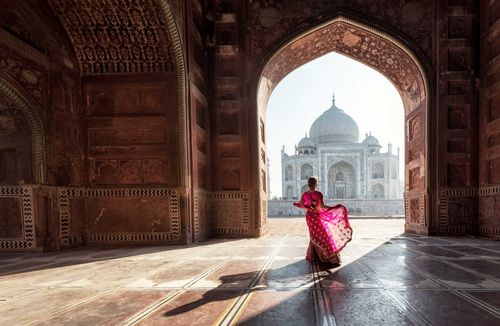
Travel ideas for India, created by local experts

A Trek Through Ladakh's Markha Valley
Trek through the Markha Valley, taking in the jaw-dropping Himalayan landscape, camp in traditional mountain villages, and discover hilltop monasteries. This unique journey combines the culture of the Buddhist faith with the natural beauty of the mountains and the hustle and bustle of Delhi.

Rajasthan: The Land of Kings
Experience the Land of Kings in luxury.This trip around Rajasthan takes you to Jaipur's palaces, sacred pilgrimage sites and deep into the desert hills. Breathe in the excitement of Delhi and visit the Taj Mahal. Then come nightfall, lay your head to rest in former royal palaces and magical forts.
_listing_1448379939234.jpeg)
The Holy City of Varanasi
The flat, sunburnt plains of the Ganges River are India's breadbasket: a densely populated area, it is home to many of the country's greatest sights. See Delhi and all its treasures, then fly to Varanasi, the most sacred stretch of the Ganges and one of India's most intense and atmospheric places.

Indian Wildlife Safari
Meet Bengals, birds, monkeys, leopards and more on an amazing wildlife extravaganza visiting India's famous national parks. Experience the countryside by rail, soak up some culture at the Taj Mahal and Rantahnbore Fort and finish with some shopping and sightseeing in the bustling capital, Dehli.
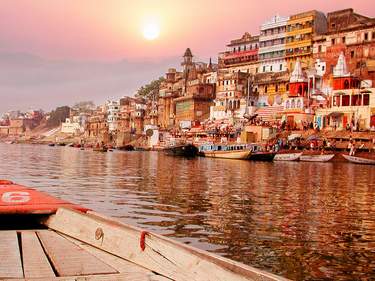
India: from the Ganges to the Golden Triangle
From Dehli's bustling dusty streets to 'the pink city' of Jaipur and Agra's Taj Mahal, this trip ensures you experience all of India's Golden Triangle highlights. You'll visit sacred Varanasi on the banks of the Ganges and Khajuraho's famous temples too.

Magical Kerala
The intense greens of the Kerala backwaters, overhung by innumerable coconut palms, encapsulate tropical India like nowehere else. Enjoy a lazy cruise on a converted rice barge; visit fragrant spice plantations, explore Cochi and spot local wildlife.
The Rough Guides to India and related travel guides
In-depth, easy-to-use travel guides filled with expert advice.

Find even more inspiration here

written by Andy Turner
updated 22.06.2023
Ready to travel and discover India?
Get support from our local experts for stress-free planning & worry-free travels.
- Where to stay
- Travel advice

13 Things To Know Before Visiting The Taj Mahal
W hen it comes to truly great monuments, it doesn't get much more iconic than the ivory-white marble, and satisfying symmetry, of the Taj Mahal. Perched on the banks of the river Yamuna in Agra, India, countless tourists flock to its gates each year, for an all-important glimpse of what is often heralded as the most beautiful building in the world. Some 20,000 of the most skilled craftsmen from India and Central Asia worked on this ornate masterpiece, featuring thousands of sparkling semi-precious stones, among other delicate materials.
You've probably spotted it in pictures any number of times, but experiencing the allure of the Taj Mahal in person is nothing short of otherworldly. It's a must-see UNESCO World Heritage Site , which it became in 1983, and was even declared the winner of the New7Wonders of the World initiative in 2007. But before you visit in the flesh, it's a good idea to get familiar with everything there is to know about the famous "monument of love". From how much tickets cost and where to snap the best picture, to the ideal time of day to arrive, here's how to make the most of your once-in-a-lifetime trip.
Read more: 28 Bucket List Destinations That Everyone Needs To Experience At Least Once
It's Pretty Convenient To Visit
Standing tall and proud in the bustling city of Agra, the Taj Mahal is about four hours north of the country's capital, Delhi. Agra is the most populated state in India, which means there are multiple different options for getting here. The fastest route to the Taj Mahal would be to fly. If you're already in India, your best bet is to arrive at Pandit Deen Dayal Upadhyay Airport, in Agra — just over 4 miles from the city center. But if you're coming from outside of the country, the nearest major airport is the Indira Gandhi International Airport in Delhi.
From here, Agra is easy enough to reach by train. You'll want to arrive at Agra Cantt Railway Station, with several superfast, express trains running to and from all the major cities, including Mumbai, Kolkata, and Delhi. If you'd prefer to take the bus, Agra also has a well-developed road network, which you can access from various nearby hubs, including Delhi, Jaipur, and Varanasi. Just make sure you come into the Idgah Bus Stand in Agra — the main bus terminal.
Whichever transport method you choose, you'll need to take a taxi or an auto-rickshaw to reach the Taj Mahal from Agra's center. Be sure to haggle with the driver to avoid paying hefty tourist prices, especially since they won't be able to drop you right outside the Taj Mahal. Vehicles aren't allowed within 500 meters (1640 feet) of the monument because of pollution concerns.
You Can't Visit On Fridays
From sunrise to sunset, on almost every day of the week, you're free to soak up the Taj Mahal in all its splendor — except on Fridays, when it's closed to allow practicing Muslims to worship. You might want to pass up on a weekend visit, too, just to avoid the huge swathes of crowds at every turn.
Settle on an early-morning strategy , or go for a "last thing at night" visit — the Taj opens 30 minutes before sunrise and closes 30 minutes before sunset. Sunrise is truly magical, thanks to a warm glow descending over its pristine white marble. And with fewer people around, you'll likely have the space and time to fully appreciate all of the monument's intricacies, without distraction. Before sunset is just as rewarding, as the changing colors of the sky create an exquisite backdrop.
There isn't exactly a best time to visit India — each season comes with its pros and cons — but think about your priorities. If you prefer cooler temperatures, visit in the winter, between October and March. Just remember that you'll have to contend with thousands of other tourists with the same idea. Plus, it can get foggy, which may obscure your view. April to May will be hot and humid, but there will be fewer tourists around. That leaves June to September — monsoon season. You may get caught in a downpour, but even fewer visitors are prepared to brave it during this time, and accommodation prices are much cheaper.
It Took Around 20 Years To Build
Visiting a historic monument is never quite the same if you don't know the full story, so don't plan this trip of a lifetime without doing your homework first. You'll find that understanding the history gives you a much deeper respect for the Taj Mahal, and allows you to really take in all that this immense structure has to offer.
To give you a little background, the iconic monument we all know and love was commissioned by the fifth Mughal Emperor, Shah Jahan, as a memorial for his third wife, Mumtaz Mahal -- she died during childbirth in 1631. The building process was started almost immediately after her tragic death and took around 20 years to complete. As well as incredible white marble from the Indian state of Rajasthan, materials for the Taj Mahal were sought from all over the world, including turquoise from Tibet, white sapphire from Sri Lanka, and jade imported from China. Around 1,000 elephants were also thought to be involved in the construction process, transporting these special materials across borders, and helping to lay them in place.
When the Taj Mahal was finally finished in 1653, there were rumors that the thousands of laborers who helped create it had their thumbs chopped off, so that no such monument could ever be built again! Whether this holds true or not, the Emperor was also buried here after he died in 1666, alongside his beloved wife.
You Need To Wear Shoe Covers
A visit to the Taj Mahal can feel a little overwhelming and be a lot to take in. So much so that it may be easy to forget it's also a mausoleum — the final resting place of the Emperor and his true love. It's really important to be respectful of the rules around the monument, including covering your shoes when you go into the burial chamber.
While most temples in India require you to take off your shoes completely, the Taj Mahal simply asks tourists to use shoe covers, which are given to you in a fetching light blue shade, at the ticket booth when you arrive. These are used to prevent dust particles from being tracked into the mausoleum and to keep its marble-clad surfaces as shiny and clean as possible. On your way out of the Taj Mahal, be sure to put these disposable shoe covers, and any rubbish that you have, in the trash cans provided. Sadly, the world-famous monument has suffered from plagues of litter in recent years.
Tickets Cost More For International Tourists
Don't be surprised to see that domestic tourists pay much less for the privilege of gawking at the Taj Mahal. Indian citizens are charged 50 rupees (approximately $0.70), while foreign visitors must pay 1,100 rupees ($15.50). You'll need to part with even more money if you want to go inside the mausoleum itself — there's an additional 200 rupee fee ($2.50), but it's worth it. Plus, the foreign tourists' ticket comes with shoe covers, a water bottle, a map, as well as a bus or golf cart service, which takes you to the nearest gate. A real lifesaver in Agra's blistering heat. Bear in mind that your ticket is valid for one visit only, but gives you three blissful hours to explore the Taj Mahal.
If you plan to buy your ticket on-site, there are separate counters for domestic and foreign tourists, so be sure to line up accordingly. Both of these booths are likely to be busy with long, snaking queues, which is why it's sensible to arrive as early in the day as you can. In fact, your best bet is to line up at the South Gate and avoid the very busy East Gate at all costs. Or, simply buy your tickets online beforehand.
You Should Know And Respect The Rules
As a UNESCO World Heritage Site, every visitor must follow certain rules and regulations inside the Taj Mahal, which have been put in place to protect its magnificence. For example, at no point should you touch the marble, or any other material inside the complex, because it could lead to erosion. As it is, each surface needs special, round-the-clock care to ensure its beauty is preserved for future generations.
Littering and smoking are also not allowed within the Taj Mahal, so make sure you do your bit to dispose of empty water bottles, and other trash, in the bins outside. If your entrance ticket allows you into the mausoleum, remember not to take any photos here and to be as quiet and respectful as you can. This houses the tomb of Emperor Shah Jahan and his wife -- for whom thousands of Muslims make the journey each year to pay their respects.
Dress Appropriately
You won't find an enforced dress code for the Taj Mahal, but it's always important to be a respectful tourist when visiting India . So, treat the monument like you would any other temple or mosque on your travels. This means keeping your shoulders and everything above your knees covered, as a sign of respect. Sure, you'll notice some foreigners wearing shorts and tank tops, but don't be swept up in this. It's often seen as disrespectful and will only invite unwanted stares.
The best thing to do is play it safe with longer, flowing trousers to keep you covered and cool, as well as kaftans or shawls to hide your shoulders. For guys, wear an overshirt on your top half and a pair of shorts that ideally go down to your knees, or play it safe with full-length pants. If you're feeling exotic, it's possible to rent traditional Indian clothes for your visit, such as a saree or a kurta pajamabut, but expect to pay extra for the privilege.
Leave These Things At Home
A dress code might not be enforced, per se, but the Taj Mahal has some pretty strict rules about what can be brought into the monument. To save yourself the hassle, avoid carrying a backpack (or anything larger than a small bag), any type of food or drink (even if it's sealed), tobacco products, drones, books, mobile phone chargers, GoPros, headphones, batteries, and tripods. And don't bother trying to sneak any one of these items in, either. The guards at security points really dig through your bag and follow a pretty elaborate frisk procedure for each person.
If you really must have one of these items on you for the day, there are lockers available at the East and West Gates that you can store them in. Having said that, it's much easier just to leave forbidden items at home, so be selective when packing your bag. Bring only your camera and your phone with you, but keep the latter on silent mode in the mausoleum.
Get A Guide
For some of the world's most iconic monuments, it could be seen as a waste of money to hire a tour guide. But not the Taj Mahal. Having an expert at your fingertips will really bring the structure to life for you, with stories, and interesting facts you might not hear otherwise. Not to mention be your own personal photographer, and of course, help you with all the best angles for these pictures. There really isn't much information within the complex itself, so it's a bit of a no-brainer. But where do you find the best guide, and how much should it cost?
If you're staying in a hotel nearby, reception staff usually have good contacts with extremely knowledgeable locals. In most cases, they'll be able to offer you a good deal. Or, you could book directly on a local tour guide website, ensuring your hard-earned money goes to a good home. Expect to pay around 2,000 rupees ($25) for a tour guide per day, but if you just want someone to show you around the monument for three hours, you're looking at somewhere near the 1,500 rupee mark ($18). These prices increase dramatically for the pushy kind of guide who lingers outside the Taj Mahal waiting for tourists. So, it goes without saying — book in advance for less stress on the day itself. If you do decide to go with a guide when you arrive, ask them for an approved identity card before you begin.
Where To Take The Best Pictures
The signature shot of the Taj Mahal (the one doing the rounds on social media) is on the approach from the South Gate. You know the one — with a reflection of its world-famous domes in the turquoise fountain, and the majestic white marble of the mausoleum providing the most perfect of backdrops. But it's nearly impossible to get a clear photo here, without other tourists straying into view. So, take your chance and snap away as soon as you arrive — it'll only get busier later on.
If you can't quite get that quintessential shot at this stage, don't be disheartened. There are plenty of other opportunities. What's more, the Taj Mahal is perfectly symmetrical, providing nearly identical views from multiple vantage points. With this in mind, explore the complex as you go and get creative, looking for new angles. One of the most underrated of these is from the mosque on the west side of the mausoleum. It provides the real money shot, and with far fewer people to contend with, too. Who could say no to red-sandstone scalloped archways, providing the most perfect frame for the undisputed star of the show — the mausoleum? Time it for the break of day at sunrise or just before nightfall at sunset, and you're onto a real winner.
Visit The Other Sites, Too
Sure, the main draw of the Taj Mahal is the ivory-white marble of its mausoleum, but there's an entire complex to explore aside from this, so don't miss out. Start with Chowk-i-Jilo Khana forecourt, which houses the main entrance. It's a stunningly beautiful, arched gateway, topped with delicate domes and adorned with floral designs. Next, make your way to the Charbagh, which means four gardens. Prepare yourself for breathtaking views as you walk through Chowk-i-Jilo Khana gateway and into this tranquil space, split into four quadrants by waterways. These gardens are reminiscent of the Koranic description of Paradise — rivers flowing with water, milk, wine, and honey — and a classic sign of the Mughal era.
As you keep moving, you'll come across the aforementioned red-sandstone mosque on the west side, and a perfect replica of it on the east side. This completes the architectural symmetry of the complex and provides a few alternative vantage points for photos. Lastly, if you have time, take in the museum, which is open between 10:30 a.m. and 5 p.m. It's brimming with exquisite miniature paintings, two marble pillars believed to have come from nearby Agra Fort, and portraits of Mughal rulers. This includes those of Emperor Shah Jahan and Mumtaz Mahal, lying in the mausoleum just a few steps away.
Expect Photo Requests
If you've explored other parts of India, you'll be well-equipped to deal with it by now. But if the Taj Mahal is your first stop in this truly magnificent country, prepare for a multitude of photo requests. This is especially true if you're tall, have pale skin, and fair hair — characteristics that tend to draw a lot of attention. From whole family photos to couples pictures, locals and Indian tourists will likely be very excited to see you in their country, and may even queue up for their chance to take a snap with you.
Unsurprisingly, this can become quite tiring, not to mention take you away from the experience at hand. But 9 times out of 10, these requests come with no malice, so don't be afraid. In fact, it's seen as a gesture of friendship. If this sounds a little strange to you, it may help to understand that many Indians don't have much exposure to fair-skinned foreigners, or may never have traveled outside India before. Having said this, it's perfectly fine to politely refuse, if you're not comfortable. Otherwise, get stuck in and enjoy meeting plenty of friendly and enthusiastic locals.
Where To Stay In Agra
It's common for tourists to visit Agra on a day trip from Delhi. But just because it's possible, doesn't mean it's the best use of time. For one thing, it makes visiting the Taj Mahal for sunrise or sunset a tall order — and you don't want to miss that. So, if time allows, try to stay at least one night in Agra to make the most of this very special monument. From budget guesthouses to royal suites with unbeatable views of the Taj, it may be comforting to know that Agra has no shortage of places to lay your head with options to suit every budget.
Taj Ganj is one of the best spots in the city, perched right next to the Taj Mahal itself. In fact, it's the closest area that you can stay to the structure, offering a range of hotels, guesthouses, and hostels. It's also a popular spot for restaurants, with a rich dining hub serving North Indian and Mughlai cuisine. The area is also dotted with craft shops selling carved Taj Mahal replicas, marble inlay work, and semi-precious stones. If you're looking for something fancier, journey just a short distance away to Fatehabad Road. This area is renowned for its upscale hotels and plush, luxury resorts, many of which offer breathtaking views of the monument from deluxe suite rooms and rooftop restaurant terraces.
Read the original article on Explore .
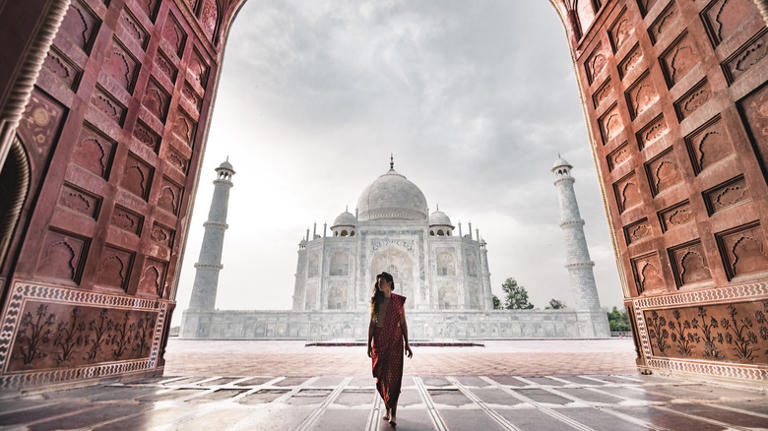

How to Visit the Taj Mahal
Twenty thousand artisans labored for decades at an estimated expense of almost one billion dollars in today’s money to create what is considered by many to be the most beautiful building in the world. Built as a tomb for the favorite wife of the Mughal Emperor Shah Jahan, construction was completed in 1653. UNESCO put its stamp of approval on the building a mere 330 years later, declaring it a World Heritage Site in 1983.
Such is the popularity and fame of the Taj Mahal that it is hard to imagine the building actually living up to the hype. But it does. Visiting the Taj Mahal is like seeing the Eiffel Tower, the Hagia Sofia, the Sydney Opera House, and Barcelona Cathedral all rolled into one. Words and pictures can’t do it justice. It is something you simply have to do for yourself.
The Taj Mahal is located in Uttar Pradesh, a state in northern India, in the city of Agra – a busy, crowded, tourist town a little over 200 kilometers from New Delhi and Jaipur respectively. Together these three cities make up the so-called “Golden Triangle”, a common introduction to India’s highlights. Here we’ll cut through the overwhelm and show you exactly how to get to the Taj Mahal and make the most of your visit.
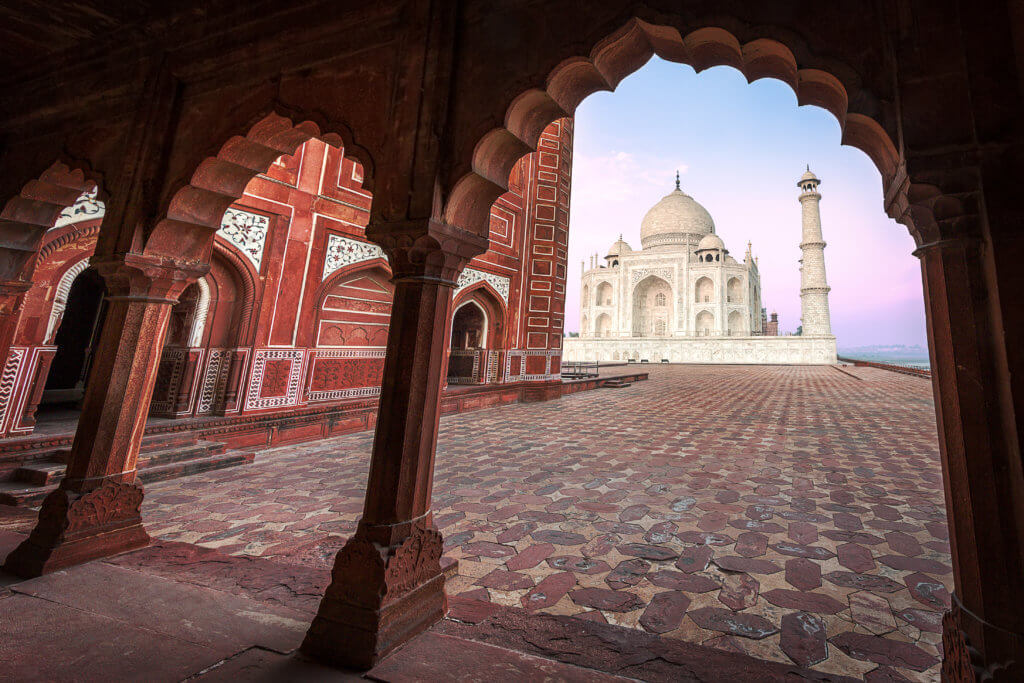
Agra and Taj Mahal: A Brief Overview
The Taj Mahal is by far the most famous attraction in Agra, if not in India itself. However, since you have made it all the way to Agra and will most likely be staying there, you may want to check out some of the other well-known sights in this ancient former capital.
The Taj Mahal Itself: The white marble mausoleum is by far the most famous aspect of the Taj Mahal complex, and is the part that you will have seen in a million photos. You will enter the garden, passing through the famous gate, and once inside, you will be able to view the gorgeous reflecting pool which perfectly frames the white marble tomb before standing in the impeccably maintained gardens. For a small extra fee (more details below) you can choose to enter the mausoleum itself.
Agra Fort: A short Tuktuk ride from the Taj and clocking in at a cheaper 650 Rupees (aprx $7.50USD) for a foreign visitor, this is where the emperors of the Mughal Empire lived until the capital was shifted to Delhi in 1638. The 38-hectare site is imposing and, unlike the Taj Mahal, you can get a sense of its vastness from the outside.
Fatehpur Sikri. A mini-world of red sandstone, this small town perfectly captures the exotic mysticism of the Mughal Empire and is a UNESCO World Heritage Site in its own right.
Itimad-ud-daula's Tomb . Sometimes known as the baby Taj, if you want another hit of beautiful marble architecture without the tourist frenzy of the better-known mausoleum, then this is not to be missed.
Akbar's Tomb. Mughal Emperors didn’t just build gorgeous tombs for their favorite wives – they made sure to look after their own posterity as well. The red sandstone provides a nice contrast to the white marble Taj.

How to Visit the Taj Mahal
Where is the taj mahal located.
The Taj Mahal is located within the city of Agra which forms part of the “Golden Triangle” with Delhi and Jaipur, each leg of the triangle being a little over 200 kilometers. We’ll look below at some options for how to get to Agra in more detail. For this section, we’ll assume you’re already there!
Buying your ticket
- Taj Mahal 2020 Ticket Prices: Like many tourist attractions in India, prices are radically different for Indian Citizens and foreigners. For foreign visitors, a ticket costs 1100 Rupees (aprx $15USD). You can choose to pay another 200 rupees ($2.80USD) to enter the mausoleum itself.
- Getting Your Ticket Online : To skip the queue, consider getting your ticket online in advance from a site like GetYourGuide , which usually costs a couple of dollars more than the standard price and can include an optional transfer from your hotel. Note that because of the way tickets work, you may need to contact your guide and arrange a time for them to let you into the complex, so make sure you read any instructions you are sent after booking carefully. They will always work around your preferred timing. You can also book through the official website, www.tajmahal.gov.in , which is a complex 11-step process requiring your passport and will require you to print out the ticket at the end of the process.
- Getting Your Ticket Onsite : Queues can be long but it is certainly possible to buy your ticket at the Taj Mahal itself, there is a major ticketing area near the Western Gate. Note that there are separate queues for Indians and Foreigners, and you may be asked to show your passport. Bring cash because there is no guarantee that credit cards will be accepted. While queuing, you will constantly be approached by people offering information, trying to sell expensive tours, or claiming that a certain booth is closed (even if it is clearly open). Ignore them.
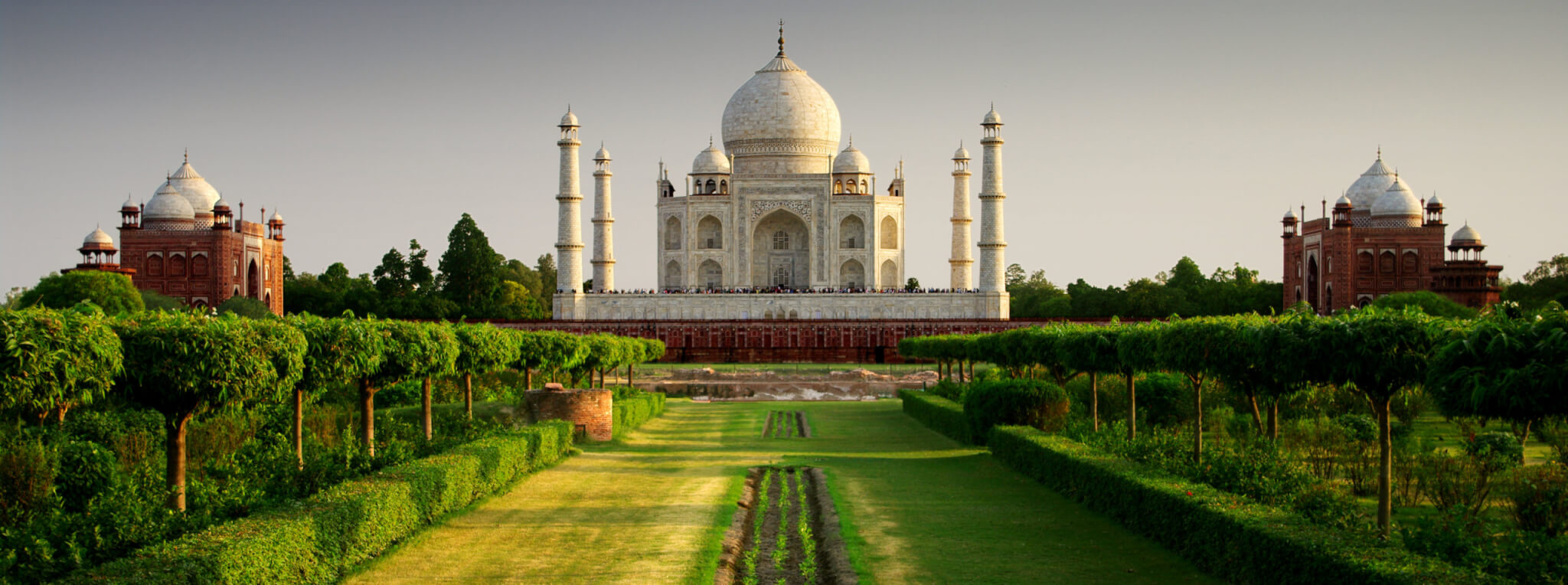
DIY or Guided Tour?
If you’re visiting under your own steam you will have more freedom, may save money if you’re a savvy India-traveler, and will be able to do so at your own pace. An organized trip , on the other hand, will save you the hassle and take care of much of the administration for you.
Planning a DIY Visit: The Taj Mahal is open from 30 minutes before sunrise until 30 minutes before sunset every day except Friday when it is closed – watch out for this! As mentioned, it's worth getting a skip-the-line ticket . If you’re staying in Agra, your hotel should be able to arrange a taxi or Tuktuk to the site for you, and the driver can wait for you there. There’s about a 10-minute walk from the main car park at the Western Gate to the site itself. You can take a rickshaw or tuk-tuks, but negotiate hard if you choose to do so, otherwise you will get monstrously ripped off. What to Bring: There are restaurants and food stands near the site but these are expensive, and the atmosphere is unpleasant because of the constant harassment by touts. Instead, go with a full stomach or bring some snacks. You should bring your passport – you may not be asked for this, but it’s best to have it. Take cash as credit card payment is never a sure thing. Do not bring a large day bag – security at the site is intense and you will not be able to take it in.
Visiting with a Tour: Tours from GetYourGuide can help to skip the line, and take care of the transport and hassle for you. GetYourGuide has many highly-rated options for tours from Agra including Skip the Line entrance, starting from around $21 USD. Pay close attention to the instructions, as the ticketing system can be complex and you may need to e-mail or WhatsApp the booking operator and inform them of the time-slot in which you plan to visit. There are options if you’re already in Agra as well as a large number of tours leaving from Delhi , including day-trips if you want to return to Delhi for the evening. We will break down some options below.
Getting to the Taj Mahal
Most visitors to the Taj Mahal will begin their journey in New Delhi. New Delhi is well served by international flights from Europe and America and is a major global city with plenty of sights and accommodation options. If you are planning your time in India around a visit to the Taj Mahal, checking flights on Skyscanner from your hometown to New Delhi will most likely be the best bet. Once you’re in New Delhi, you can go directly from there to Agra with the options below, or first visit Jaipur.
Visiting The Taj Mahal from Jaipur or New Delhi Under Your Own Steam
- Train : There are several trains a day from Delhi and Jaipur to Agra that take just over 2 hours respectively. Prices vary but they tend to be pretty cheap – around $20USD for a reasonable class with air conditioning. Booking trains in India is a complicated endeavor and should be seen as a part of the travel experience! One way is to go to the origin train station (with your passport), find the foreign ticket booking room or kiosk, and get a last-minute ticket under the tourist allowance. You can also book online through websites like Cleartrip, but this can be frustrating and is only recommended if you are doing this several weeks in advance. The Man in Seat 61 has a comprehensive guide specifically on this.
- Flight : Agra Airport is almost exclusively served with flights from Jaipur, which can be as cheap as $25USD and takes 55 minutes.
- Uber : Long-distance Uber travel in India is well established, safe and surprisingly cheap. The price will vary but it is not unrealistic for you to expect an Uber from New Delhi to Agra, or even directly to the Taj itself for less than $40USD. Uber seems to be subsidizing the New Delhi-Agra route, as the Jaipur-Agra route, while roughly the same length, seems to be more experience, at around $60USD (as of one traveler’s experience in December 2019).
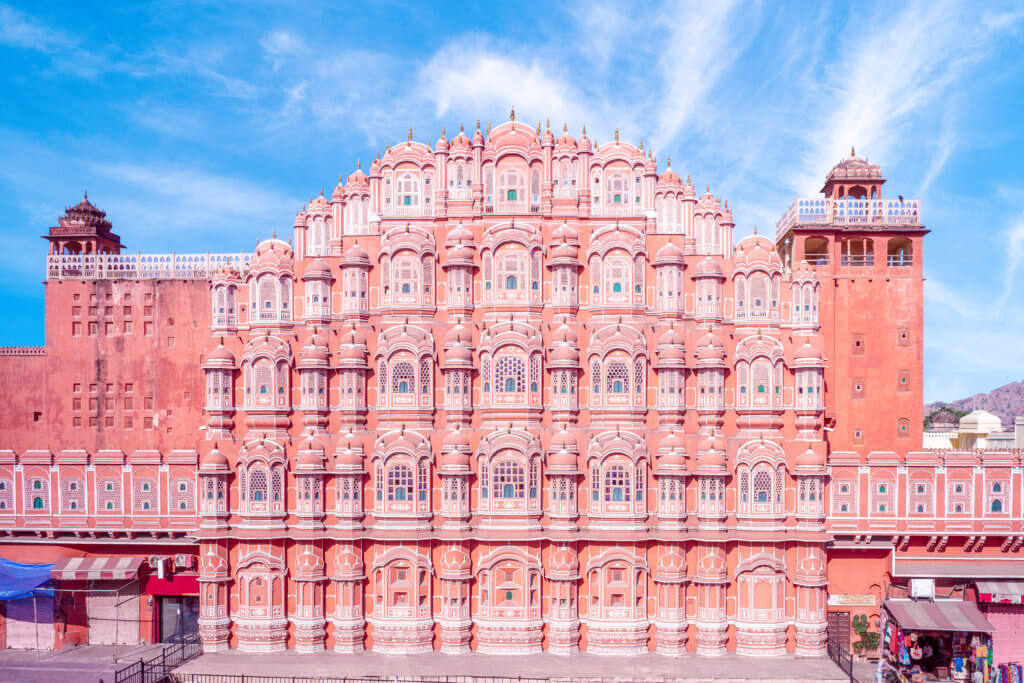
Visiting With a Tour from Delhi/Jaipur You can also book a tour from New Delhi , including transfer to Agra and often one or two other sites in Agra, such as the Agra Fort, starting from around $50USD including air conditioned car and English speaking driver. Not all tours will include Skip the Line entrance, so double-check this as you may need to purchase it as a separate item or factor in time to get your ticket in person. If you prefer to travel from New Delhi by train, GetYourGuide has an option for a tour including train tickets, saving you at least half a day of effort. Tours from Jaipur seem to be limited to city transfer from around $60USD, approximately the same rate as an Uber.
Where to stay
Unless you’re doing a day-trip from Delhi or Jaipur, most travelers will stay in Agra. Agra is a packed, loud and extraordinarily busy city. Being a well-known tourist hub, beggars and touts are plentiful. These are more an annoyance than a danger but can be shocking for a first-time visitor. Keep your valuables in a secure money-built, and try and look purposeful when you’re walking on the street (even if you are lost!).
There are plenty of major brand hotels including Radisson that are popular if you want to splash-out, as well as a number of budget hotels and hostels available on Booking.com , with prices starting from around $10/USD a night for a private room. Airbnb is also an increasingly popular option in India, but pay closer than usual attention to reviews as stories of tourists being ripped off are not uncommon. A good approach is to find your chosen option on Booking.com , and then double-check reviews on at least one other site such as Tripadvisor to make sure the place seems legitimate.
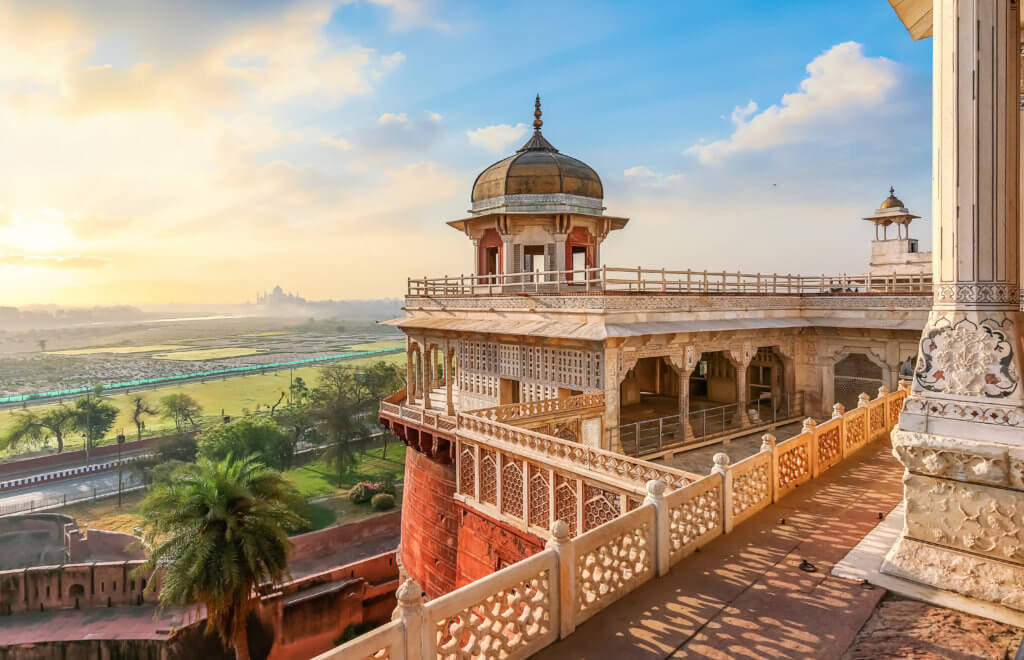
The Thrifty Gist
- Worth It: There are few major tourist attractions in the world which truly and fully live up to the hype. This is one of them.
- Location info The Taj Mahal is located in the large city of Agra in the state of Uttar Pradesh, forming the “Golden Triangle” with Delhi and Jaipur each about 200 kilometers apart
- Other Sites: Agra is the historical capital of the Mughal Empire and as such contains a number of other tombs and historical sites – the second most famous attraction is arguably Agra Fort
- Tickets : Can be bought at the site for aprx $15USD – bring cash and your passport. You can also get your ticket in advance on GetYourGuide to skip the line.
- Getting There: A train from New Dehli or Jaipur takes just over 2 hours and will cost you in the ballpark of $20 USD. You can also take an Uber from either city or go with a private tour organized on GetYourGuide or Viator. You can also fly from Jaipur.
- Accommodation : If you’re staying near the Taj, then you’ll be staying in Agra. The city has numerous options catering to all budgets, just be careful to check multiple review sites to make sure you are getting what you pay for.
The Taj Mahal stands as a testament to human artistry and love, captivating visitors with its breathtaking beauty and timeless elegance. Its status as a UNESCO World Heritage Site only adds to its allure, making it a must-see destination for anyone seeking to witness one of the world’s most magnificent architectural wonders firsthand.
Leave a Reply Cancel reply
Your email address will not be published. Required fields are marked *
15 Crucial Tips for Visiting the Taj Mahal in 2024 (+ Photography)

Being one of the seven wonders of the world, the Taj Mahal is, without a doubt, one of the most famous landmark s in India ! For most of us, visiting this mausoleum is a once-in-a-lifetime experience, so it’s important to plan your visit well. That’s exactly where these 15 tips for visiting the Taj Mahal will come in handy!
The majestic Taj Mahal was built at the demand of Shah Jahan in memory of his wife, Mumtaz Mahal. She passed away in 1631 after giving birth to their 14th child. It took 16 years to build the mausoleum and the legend says that the hands of the workers who built the Taj Mahal were cut off so that they could never build something like it again.
I was actually hesitant to visit the Taj Mahal when I was in India. Even though it does look astonishing, I was scared that I would end up being disappointed because it’s so touristy. This wonder of the world is part of India’s famous Golden Triangle Route, after all. It actually wasn’t too busy, though!
Although there were quite some crowds when I was there, the early morning was surprisingly quiet. On top of that, the Taj Mahal’s grounds are so big that it was possible to find quiet places, even after the bigger crowds arrived.
But without further ado, here are my best tips for visiting the beautiful Taj Mahal! I hope these will help you make the most out of your visit to this stunning wonder of the world.
>> Read: What is India Famous For? 28 Interesting Facts
15 useful tips for visiting the Taj Mahal
In this section, you will find important things to consider when planning your visit to the Taj Mahal. These will help you plan your visit so that you can enjoy your trip to the fullest. You will also find some useful photography tips later in this post.
But without further ado, here are my 15 best tips for visiting the beautiful Taj Mahal.
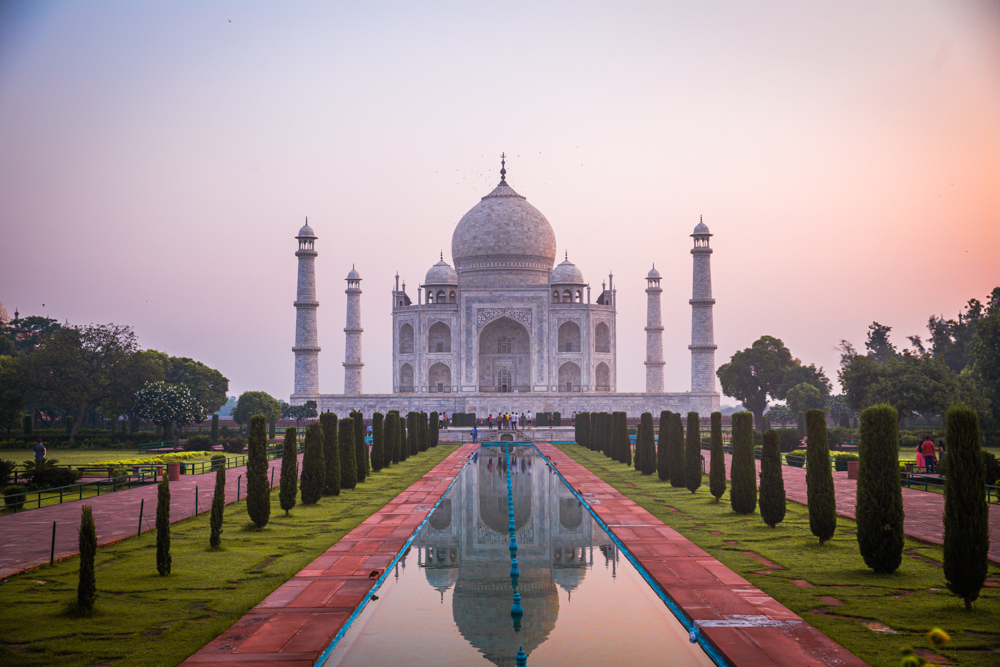
1. Don’t visit the Taj Mahal on a Friday
Simply put: this wonder of the world is closed on Fridays . So make sure to keep this in mind when you’re planning your trip to India and the Taj Mahal.
Prior to my visit, I read that the best day to visit the Taj Mahal is on a Monday because that’s when it’s the least crowded. I don’t know if this is true but I visited it on a Monday morning and, surprisingly, it wasn’t crowded at all for the first 2 hours (5:30 am to 7:30 am)!
This could also still be due to a certain virus, however, as I visited the Taj Mahal in July 2022 and the big majority of tourists were Indians.

2. Buy a ticket in advance
You really don’t want to get up even earlier to be the first in line at the ticket office when it’s so easy to buy a ticket online in advance. This will definitely save you some valuable time, as people already start lining up at the ticket office before the Taj Mahal opens.
There are two types of tickets . One to visit the Taj Mahal in the morning and one to visit it in the afternoon. I would recommend visiting the Taj Mahal for sunrise, as (on a beautiful day) the light is truly spectacular then.
It’s good to know that a ticket costs 1100 INR for foreigners , 540 INR for citizens of SAARC and BIMSTEC countries and 50 INR for Indian citizens . There’s also an additional fee of 200 INR if you want to enter the mausoleum . The price for the mausoleum is the same for all nationalities.
3. Arrive before sunrise
When it comes to visiting the Taj Mahal, arriving before sunrise is one of the best tips I can give!
The Taj Mahal opens 30 minutes before sunrise, so it’s good to be there early. The timings are different according to the season but I arrived around 5:15 am in July and I wasn’t the first to be there!
The earlier you come, the greater your chances are of seeing the Taj Mahal without too many crowds. Do expect it to be quite crowded when you enter, though. This is because many people make a photo stop right behind the entrance gate.
In my experience, the spot at the entrance was the most crowded place. When you walk a bit further, there should be fewer crowds. On top of that, you will have a better view of the Taj Mahal.
I left the Taj Mahal around 8:30 or 9 am and it was getting pretty crowded (and super hot) around that time. This is another reason why you will have a more pleasant experience if you go as early as possible.

4. Dress appropriately
There’s no specific Taj Mahal dress code but as a general rule, both men and women are expected to cover their shoulders and knees . India is a conservative country and it’s important to be respectful of the local culture.
The Taj Mahal or India in general are not the right places for hot pants and spaghetti tops. This is more accepted in cities like Bombay , however, but this is not the norm in Agra and most of the country.
You will already stand out and get a lot of attention as a foreigner (this includes posing in numerous selfies). So it’s important to dress appropriately.
It’s also good to know that you can wear shoes at the Taj Mahal. However, you will get shoe covers to visit the interior of the mausoleum.
>> Read next: – What to Wear in India: 5 Tips + Outfit Ideas – What to Pack for India as a Woman

5. Know what you can’t bring
One of my most important tips for visiting the Taj Mahal is to know what you cannot bring.
The rules at the Taj Mahal are quite strict. This is one of the seven wonders of the world, after all. So, before your visit, it’s important to know what you can and cannot bring inside.
I don’t think they will keep your stuff safe for you, and the Taj Mahal is one of these places to visit once in a lifetime so it would be a pity not to be let in.
The list of prohibited items includes some predictable things like arms, ammunition and knives but also more surprising ones like food , cigarettes and tobacco , headphones , tripods , mobile chargers , etc.
You can check out the full list on the official website of the Taj Mahal .
6. Beware of the “guides “
The Taj Mahal is infamous for its fake guides roaming around the entrance of the complex. Don’t be fooled, as these “guides” also have fake identity cards saying they are recognized government guides.
These fake guides’ English is limited, though, and they’re notorious for offering incorrect information. On top of that, they won’t state a price beforehand, which can lead to unwelcome surprises after the tour.
As the Taj Mahal’s history is interesting, you may want to get a government guide. If so, make sure to arrange it through a registered tour company or your hotel before your visit.

7. Explore the other buildings
There are two other buildings on the grounds of the Taj Mahal. You will find the mosque on the West side and the guest house ( Mehmaan Khana ) on the East side. Both of these buildings are constructed of red sandstone.
It’s interesting to note that the mosque was built because, according to Muslim law, every mausoleum should be accompanied by a mosque. The guest house, on the other hand, was built to accommodate the guests visiting the tomb of Mumtaz Mahal.
There’s a huge square in front of both of these buildings, and the view of the Taj Mahal is spectacular from here . On top of that, it’s not so crowded here, so it’s the perfect place to snap some pictures!
>> Read: 19 Reasons to Visit India this Year
8. Visit the museum too
There’s a photo gallery and museum on the left side of the entrance of the Taj Mahal. Make sure to visit it if you’re a history buff or if you would like to learn more about the Taj Mahal and the Mughal era.
The museum opens at 10 am and you can visit it using your entry ticket for the Taj Mahal. You will find three galleries here. One that’s dedicated to calligraphic art and household items that were used during the Mughal era, another one that’s full of paintings of Shah Jahan and Mumtaz Mahal and a third one that includes manuscripts, drawings and documents related to the Taj Mahal and Mughal era .

9. Don’t stay in Agra for longer than a day
Unless you have enough time and want to stay, of course! I stayed in Agra for a couple of days because I work online, and it’s my least favourite city in India so far.
Apart from the Taj Mahal, the Red Fort , the baby Taj Mahal (Itmad-ud-Daula) and Metabh Bagh , there’s not so much to see or do here.
On top of that, vendors in Agra are pushier than anywhere else in India (which says a lot and is pretty exhausting).
Taj Mahal photography tips
Whether you’re an avid photographer or not, the Taj Mahal is a place where you can take some wonderful Indian shots. The tips in this post will help you take great pictures of this beautiful wonder of the world.
Here are my best photography tips for when you’re visiting the Taj Mahal.

10. Take advantage of the golden hour
Start taking pictures as soon as you enter the Taj Mahal, as it’s only going to get more crowded and the so-called golden hour is when the light is at its best.
Like most people, after entering, I took plenty of shots of the front of the Taj Mahal. When you walk a little further, however, you will even have a better view with fewer crowds.
Although the golden hour is the most spectacular time of the day, the Taj Mahal looks beautiful at any moment, so it’s definitely worth heading back to certain places to take pictures in a different light.

11. Take shots of the details too
Don’t forget to take pictures up close too as the Taj Mahal is full of beautiful details!
When you look a little closer, you will see that the Taj Mahal is decorated with Mughal art. You will find floral motives as well as abstract forms all over the mausoleum.
But the Taj Mahal is not the only place in the complex with beautiful details. Make sure to keep your eyes open as you walk around, as the entire place boasts plenty of jaw-dropping details.

12. Get creative
With its perfect symmetry, the Taj Mahal is a great place to play with reflections , take shots from different angles , move around and get creative.
There are plenty of water ponds that make for good photo opportunities for reflections. On top of that, the photography “guides” (see #13 in this list) also make the floor wet to create beautiful reflections in some places.

13. Get a photography “guide”
By “photography guide”, I don’t mean one of the photographers that are roaming around the Taj Mahal. I mean one of the caretakers that offer to show you the best photo spots.
This is not advice I would usually give, but when it comes to the Taj Mahal, the light is truly the most beautiful during the golden hour, so you really want to take advantage of that.
The photography “guides” know exactly where the best spots are to take pictures, and they will bring you there in no time. If you’re travelling in India alone , they can take some snaps of you as well as tripods are not allowed .
I hired one of these “guides” to show me the best photo spots, took some pictures and then went back there by myself but by then, the light wasn’t as spectacular anymore.
According to an Indian friend, giving your guide 20 INR is enough. I gave mine 40 INR, however, and he was satisfied.

14. Know that you can’t take pictures inside the Taj Mahal
You won’t want to take any either, to be honest. The exterior of the Taj Mahal is spectacular, but the room with cenotaphs (empty graves) of Shah Jahan and Mumtaz Mahal, which is inside the mausoleum, is quite sober.
It’s interesting to note that while Mumtaz Mahal’s cenotaph was placed in the middle of the room, Shah Jahan’s cenotaph was placed off-centre. This is the only thing that is not symmetrical in the entire Taj Mahal complex! Because of this, it’s widely believed that Shah Jahan’s cenotaph wasn’t part of the original Taj Mahal plan, which was completely symmetrical.
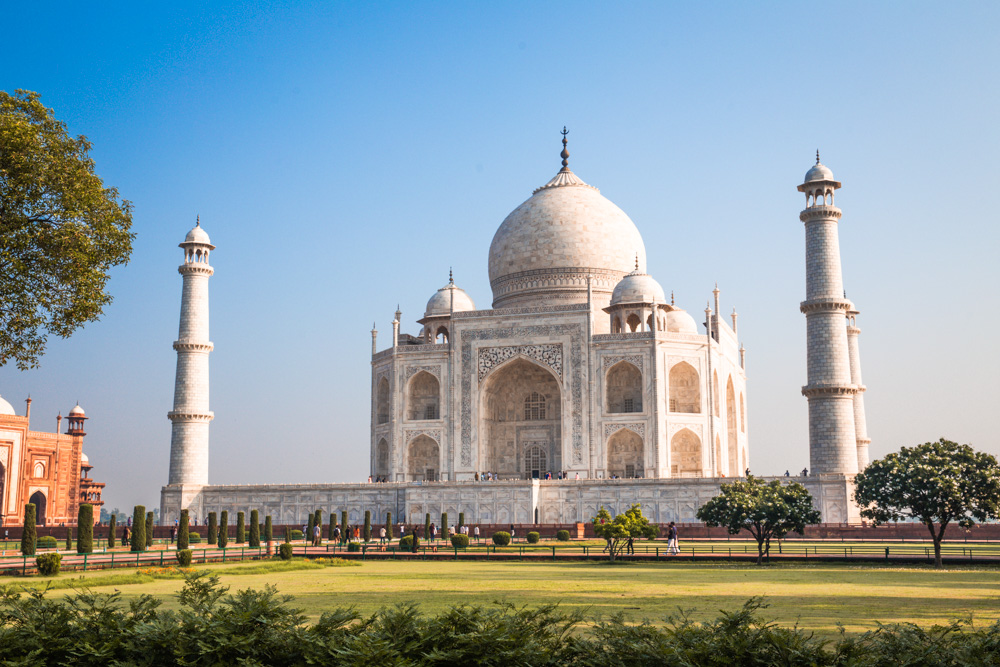
15. Be patient
When it comes to taking pictures (and with many other things in life), patience really pays off.
Even if you come early, you won’t be the only person visiting the Taj Mahal and you will have to stand in line to take pictures in certain places.
You can’t tell when you see the picture below, but when I asked someone to take it, I wasn’t the only one who wanted their picture taken in that spot and I had to wait for my turn.
The same goes if you want pictures without too many people standing in them: patience really does pay off! So take your time and be prepared to wait to take the perfect shot.

Tips for visiting the Taj Mahal: FAQs
How much time do you need at the taj mahal.
It all depends on you, but I would allow at least 2 hours to visit the Taj Mahal complex. I took a lot of pictures and stayed for about 3,5 hours. Note that the place starts getting quite crowded around 8 or 9 am, so come as early as possible if you want to avoid crowds.
What should I wear to visit the Taj Mahal?
Although there’s no specific Taj Mahal dress code, both men and women are expected to cover their shoulders and knees. India is a conservative country and it’s important to respect the local culture.
How much does it cost to visit the Taj Mahal?
A visit to the Taj Mahal costs 1300 INR for foreigners, 740 INR for citizens of SAARC and BIMSTEC countries and 250 INR for Indians. This includes 200 INR to enter the mausoleum (which is optional).
Best time to visit the Taj Mahal
The best time to visit the Taj Mahal is during Winter, between October and March . This is when the weather is at its best in this part of India. Do note that this is also the time of the year when you will encounter the most crowds, as this is the high season.
If you’re visiting the Taj Mahal during the Summer (April to June), it will be boiling hot with temperatures reaching over 45°C.
I visited the Taj Mahal in July, which is during the monsoon season (July to September). Although it was still very, very hot and humid, it didn’t rain during the three days I stayed in Agra.
When it comes to the time of the day, make sure to arrive before sunrise . Watching the sunrise at the Taj Mahal is a wonderful experience and this is also the least crowded time of the day.
I don’t know if this is true, but I read that Mondays are the best day to avoid crowds. It may have been luck and it’s impossible to know how crowded the place will be when you’re there, but when I visited the Taj Mahal early in the morning on a Monday in July, it was surprisingly quiet.
This is what it looked like around 8:30 am, though:

Visiting the Taj Mahal during full moon nights
If you’re visiting the Taj Mahal around the full moon, you can opt to visit it at night for a unique experience.
Night viewing of the Taj Mahal is possible five times a month. This is during the two nights before the full moon, during the full moon and during the two nights after the full moon.
Tickets for night viewing are available one day before and it works with 30-minute batches of groups of a maximum of 50 people.

How to get to the Taj Mahal
The Taj Mahal is located in Agra, in the North of India. This city is about 230 km (142 mi) from New Delhi , the country’s capital. The nearest airport is the Indira Gandhi International Airport of Delhi.
From Delhi, you can reach Agra by:
- Train : This is how I went to Agra, it’s a 4 to 5-hour journey by train from New Delhi. Make sure to book your train tickets in advance , though, as seats tend to fill up quickly in this part of India.
- Private car: If you’re willing to spend more money, you can also get from New Delhi to Agra by taking a private car.
- Renting a car: Another way to reach Agra is by renting a car and driving there yourself. Make sure that you’re confident enough to drive in India, though, if this is the option you’re going for.
- Taking a tour: There are tours from Delhi that go to the Taj Mahal too, this is probably the easiest way to get there.
I recommend booking a hotel that’s within walking distance of the Taj Mahal. This way, you won’t need to hire a rickshaw to get there.
If you’re not staying within walking distance of the Taj Mahal, I highly recommend using the Ola app to book a rickshaw. It works just like Uber and this way, you will get a fair price immediately and won’t need to haggle, as rickshaw drivers tend to ask 10 times the local price to foreigners.
>> Read: South India VS North India: 9 Differences
Tips for visiting the Taj Mahal: Final thoughts
I was hesitant to visit the Taj Mahal when I was in India, as I was afraid that it would be too touristy and that I’d end up being disappointed.
However, my visit to this place ended up being a wonderful experience! The Taj Mahal is a truly beautiful and photogenic place that is definitely worth visiting during a trip to India.
I hope these tips for visiting the Taj Mahal will help you plan your visit to this spectacular wonder of the world.
Are you visiting the Taj Mahal as a part of the Golden Triangle (which includes Delhi, Agra and Jaipur)? Check out my itinerary for the Golden Triangle of India next!
Have you visited the Taj Mahal already? How was your experience? Let me know in the comments!
Read more about India:
- The Ultimate India Travel Bucket List: 34 Ideas
- Souvenirs from India That Don’t Suck
- The Cost of Travel in India
- How to AVOID Getting Sick in India

India travel planning guide
🛫 Find the cheapest flights to India on Skyscanner . 🏨 Find the best accommodation via Booking or Agoda . 🛺 Download the Ola app to order a rickshaw. 🚃 Use 12GoAsia to book trains and buses in India. 💰 Get travel insurance via Visitors Coverage , one of the best-reviewed travel insurance companies. 👘 Check out my complete India packing list for females . 📋 Don’t forget to check if you need a visa to visit India.
Pin it for later: Did you enjoy these tips for visiting the Taj Mahal? Save it on Pinterest and follow me on Instagram and Facebook for more travel inspiration.

Laura Meyers
Laura Meyers is the founder of Laure Wanders. She was born in Belgium and has travelled to over 40 countries, many of them solo. She currently spends most of her time between Belgium and South Asia and loves helping other travellers plan their adventures abroad.
You may also like
What is india famous for 33 interesting facts, 7 places to visit in jaisalmer in 2..., the ultimate india travel bucket list: 35 ideas, 16 beautiful palaces in asia that you can..., dharohar folk dance, udaipur: what to expect (2024), 30 best museums to visit in europe (2024), 14 amazing things to do in auroville, india..., jaipur itinerary: 2 perfect days in the pink..., groping in india: how common is it (2024), is rajasthan safe a solo female traveller’s perspective....
Such a good tips! I wish I had read this before actually visiting Taj Mahal… It was so crowded that it was impossible to enjoy haha. Thanks for sharing great tips!
Hi Elisa! Thank you for reading, I’m glad they’re helpful! 🙂 Ahh too bad it was so crowded during your visit, I guess I was very lucky!
Leave a Comment Cancel Reply
Save my name, email, and website in this browser for the next time I comment.

- Thailand Lantern Festival
- Indonesia(Bali)
- South Korea
- China (HK, Taiwan)
- Itinerary Ideas
- Asia Highlights Travel Reviews
- Thailand Travel Reviews
- Vietnam Travel Reviews
- Cambodia Travel Reviews
- Japan Travel Reviews
- Myanmar Travel Reviews
- China Travel Reviews

Best Times to Visit the Taj Mahal? Expert Tips in 2024
There are three seasons in Agra, home to the Taj Mahal: the hot season (April to June), the rainy season (July to September), and the (mild) dry season (October to March).
October to March is the best time period to visit the Taj Mahal weather-wise, when temperatures average from 15 to 27°C (59–81°F). It perfectly avoids the rains and summer heat, and allows you to fully immerse yourself in a dreamy visit.
March, October, and November are ideal for photography, with cool weather, clear skies, and fewer crowds (in contrast to December to February's colder, foggier, and busier months).
If you seek a time with the fewest tourist numbers , visit the Taj Mahal from April to September (in the low season), and avoid weekends and public holidays .
During the day, sunrise is undoubtedly the best time for the most favorable lighting, low crowding, and avoidance of extreme heat.
Quick Facts on Visiting the Taj Mahal
- Tips for Different Seasons
- Best Times to to Avoid Crowds
- Best Times of Day to Visit the Taj Mahal
- The Taj Mahal on Full Moon Nights
- The Taj Mahal opens from sunrise (around 6 a.m.) to sunset (around 6:30 p.m.) every day except Fridays . The opening hours may change seasonally, so double check with us before going.
- You're suggested to stay at least 3 hours to take plenty of awesome photos and admire its beauty leisurely.
- There are three gates in the Taj Mahal: the Western Gate, Eastern Gate, and Southern Gate. Entry is not allowed at the Southern Gate .
- From the parking lot of the Taj Mahal, you would get to a gateway by a battery-powered golf cart .
- Children below the age of 15 years enjoy free entry to the Taj Mahal.
Discover real reviews of Highlights Travel Family 's best-rated service across trusted platforms.
Tips for Visiting the Taj Mahal in Different Seasons
Visiting taj mahal in the hot season (april to june).
If you can put up with the extreme heat around 40°C (106°F), the rewards will include appreciating the Taj at lowest visitor numbers and prices.
1. Visiting at sunrise:
You can choose a heritage hotel near the Taj for more convenient visit and visit the Taj Mahal at sunrise to avoid the daytime heat.
2. What to Pack:
Bring sunglasses, sun cream, and a hat to protect you from the strong sunlight. Fast-drying T-shirts are more comfortable for the hot days.
Visiting the Taj Mahal in the Rainy Season (July to September)
Daily top temperatures drop to around 34°C (93°F) thanks to the monsoon rains. The Taj Mahal receives its heaviest rainfall in July and August and the monsoon rains end in September .
Visiting in rainy season, you're likely to have the Taj yourself. When it rains during your visit, you might see the magical Taj Mahal with rain and sun at the same time, or you could choose to spend more time inside the Taj .
1. Check the weather forecast:
The rainfall rarely lasts for more than 2 or 3 days at a time. You can check the forecast for the predicted rainfall timings one day before, so that you can plan to avoid the rainfall as much as possible.
2. Have a flexible itinerary:
If you're willing to brave the high rainfall months , you should have a flexible itinerary to make the most of gaps between cloudbursts for outdoor activities.
3. What to Pack:
Pack sun protection and waterproofs, as there may be no way to get around visiting the Taj when it is raining if it rains solidly for the 3 days of your visit.
Visiting the Taj Mahal in the Dry Season (October to March)
The most pleasant weather usually brings the biggest crowds.
1. Make reservations at least 3 months in advance:
If you're planning to visit during this period, booking at least 3 months before is necessary to guarantee rooms, tickets and guides will be available. Contact us to enjoy worry-free booking: You enjoy 100% refund of any payments made to China Highlights prior to 3 weeks before departure ( detail⇒ ). Check India tours for inspiration >>>
2. Visiting at Sunrise:
During your visit, you're suggested to visit the Taj at sunrise before most tourists flood in.
When foggy days come in December and January, you'd better visit after 10 a.m. for better photos.
3. What to pack:
A dress or a t-shirt with shorts are good options to wear during the day. In the evenings, jackets, coats, and sweaters are needed, particularly in India's winter (Dec.–Feb.).
If you want any further weather info, check its monthly weather . The Taj Mahal is the top highlight in Agra. For more extensions, you can see sample itineraries of Agra tour in our itinerary ideas for 9 days , 10 days , 11 days , 12 days , and 2 weeks , or contact us to tailor-make one just for you!
Best Times to Visit the Taj Mahal to Avoid Crowds
1. Visit in Low Season
During the low travel season (April to September), you're expected to meet the smallest crowds and benefit from big promotions (30–50% off) from hotels and airlines. The only drawback is the unpleasant heat from April to June and the high rainfall from July to September.
2. Visit on Weekdays and Avoid Holidays
Apart from visiting in the low travel season, avoiding public holidays and weekends is useful to beat the crowds. Diwali, Holi, Eid, and Christmas always make the Taj Mahal busier than usual. Check out the exact dates of India Holidays in 2024/2025 .
3. Visit in the Early Morning
If traveling in high season , you're suggested to visit the Taj at sunrise (around 5:30 a.m.) for less crowding.
Also, pre-book your tickets to avoid waiting around. An experienced guide would help you get your tickets quickly, enter the marvelous Taj smoothly, and suggest the best spots to visit with less crowding . We can help with this. Contact us.
Best Times of Day to Visit the Taj Mahal: Sunrise, Sunset
Shutterbugs are always big on sunrises and sunsets . Skies are full of colors during these periods. They benefit from the soft light and vibrant sky changes. At the Taj Mahal, sunrise is better than sunset, as there are less visitors .
At sunrise, you could appreciate the dramatic color changes on the marbles of the Taj and get incredible photos. The earlier you get your tickets, the more likely you are to have the Taj Mahal to yourself, especially during the off season (April to June).
Sunset is another good time to see the picturesque Taj, but you would have to endure the crowds close to the Taj. If you don't want to miss sunrise and sunset with the Taj, we suggest you head to the Mehtab Bagh for a distant sunset view in relative peace upon your arrival, and then have an up-close view of the Taj the next early morning.
The Taj Mahal on Full Moon Nights: Not Advised
The Taj Mahal is typically open for 5 nights a month during the full moon phase. However, a moonlight visit is not suitable for a photography tour, because video cameras are not allowed inside the monument during this time.
As per most reviews, a night visit is not as enjoyable or worth the money. Paying 1.5 times the daytime price, you just get 30 minutes to see the shadowy Taj from the gateway (quite a long distance away).
If you would like a night view (that is just as good), booking a hotel with Taj Mahal views or going to the Mehtab Bagh is much better value. For more details, see The Taj Mahal at Night: Full Moon Night Visits, Places for Night Views
Read more on How to Plan a Trip to India or tell us your interests , and we'd be glad to find the perfect timings and activities for you. India Private Tour Packages for inspiration >>>
Why Asia Highlights (10,000+ reviews & 98.8% 5-star rating)
- Save Your Time:
- Less research, more enjoyment!
- Real-time 1V1 expert planning
- Maximize Your Flexibility:
- Personal local guide and ride
- Explore at your own pace
- Celebrate Your Journeys:
- Specially-crafted family adventures
- Celebrate milestones with style!
- 7-Day India Golden Triangle Tour
- 9-Day India Tiger Safari and Golden Triangle Tour
- 14-Day India, Nepal, and Bhutan Tour
- 11-Day India and Nepal Tour
- India Itineraries 2024: from 5 Days to 1 Month
- 2 Weeks in India 2024/2025: Top 4 Itineraries
- How to Plan Your First Trip to India 2024/2025
- Plan an Awesome Trip to India, Bhutan and Nepal (6 Tips)
- Weather in India in January 2025 & Best Places for First Visits
- Weather in India in February 2025 & Best Places for First Visits
- Weather in India in March 2024 & Best Places for First Visits
- Weather in India in April 2025 & Tips for First Visits
- Weather in India in May 2024 & Travel Tips for First-Timers
- Weather in India in June 2024: Temperatures & Places to Visit
- Weather in India in July 2024: Temperatures & Places to Visit
- Weather in India in August 2024: Temperatures & Places to Visit
- September Weather in India & Tips (Places+Crowds) 2024
- October Weather in India & Tips (Places+Crowds) 2024
- Weather in India in November 2024 & Tips for First Visits
- Weather in India in December 2024 & Tips for First Visits
Get Inspired with Some Popular Itineraries
At Asia Highlights, we create your kind of journey — your dates, your destinations, at your pace. You can have any trip tailor made for your travel.
More Travel Ideas and Inspiration
Sign up to our newsletter.
Be the first to receive exciting updates, exclusive promotions, and valuable travel tips from our team of experts.
Why Asia Highlights
Where can we take you today.
- Middle East
- African Safari
- Travel Agents
- Loyalty Program
- Privacy Policy
Address: Building 6, Chuangyi Business Park, 70 Qilidian Road, Guilin, Guangxi, 541004, China

Taj Mahal in India – My Experience and How to Visit
By: Author Swedish Nomad
Posted on Last updated: December 8, 2019
Categories India
Home / Asia / India / Taj Mahal in India – My Experience and How to Visit

Want to visit Taj Mahal in India? It’s one of the new seven wonders of the world and sees more than 8 million visitors per year. I have been there, and it’s truly an amazing building that everyone should visit at least once.
In this article, you can read all about opening hours, tickets, how to get to Taj Mahal and other interesting information before your visit.
Taj Mahal is actually not a palace, but a tomb which was built by the order of Moghul Emperor Shah Jahan. There’s a fascinating love story behind the impressive monument, which was built to honor his third and favorite wife Mumtaz Mahal.
She was a Muslim-Persian princess that died after giving birth to their 14th child. It deeply upset Shah Jahan, who promised that he would build a spectacular grave monument.
I think it’s safe that he definitely fulfilled his promise to Mumtaz Mahal.
Book a private tour with skip the line tickets

Photo: Shutterstock
Tickets and opening hours
Below are the latest entrance fees, prices are listed in Indian Rupees.
There are separate lines for foreigners and Indian citizens.
Ticket sales offices
- West Entrance : Tickets can be bought here from sunrise to sunset.
- East Entrance : Tickets can be bought at Shilpgram (sunrise to sunset)
- South Entrance : Tickets can only be purchased from 08:00 to 17:00
Where to buy Taj Mahal tickets online
There’s one official seller of Taj Mahal tickets online. Their website is asimustsee.nic.in and E-tickets are available for Indians as well as foreign tourists. However, these tickets won’t allow you to skip the line, which means that unless you arrive before opening, you’ll have to queue for 30-120 minutes.
I recommend that you book a so-called skip the line ticket. They are a bit more expensive, but not much, and the time you save is well worth the extra cost. When booking this, you’ll also get a private guided tour included at no extra cost.
You can book your skip the line ticket here
Taj Mahal opening hours
Daytime : From sunrise to sunset. All days year-round, except on Fridays. Nighttime : 20:30 to 00:30 (When it’s full moon + 2 days before and after)
On Fridays, Taj Mahal is only open to faithful Muslims.
Where is Taj Mahal located?
Taj Mahal is located in the city of Agra in northern India, in the state of Uttar Pradesh, about 230 kilometers from the capital Delhi. It’s situated on the Yamuna riverbank, which served as a moat.

How to get to Taj Mahal
From new delhi to agra and taj mahal.
The best way to get to Agra from New Delhi is by taking the train. The fastest train takes 2 hours and 10 minutes, but there are also slower trains with more frequent departures. The high-speed train is called 12001/Habibganj – New Delhi Shatabdi Express.
There are also direct flights between Delhi and Agra, but taking the train is more convenient. You can also book a sunrise tour to Taj Mahal from Delhi where a skip-the-line ticket is included.
Then you don’t have to worry about transportation and you’ll also get a day trip to Agra where the entrance to the Red fort is included as well.
You can book the tour from Delhi here
From Jaipur to Taj Mahal
Jaipur is part of the Golden Triangle in India, and it’s relatively easy to get from Jaipur to Agra. There are several trains with daily departures and the journey takes about 3.5 hours with the fastest train.
From Mumbai to Taj Mahal
The fastest way of getting to Taj Mahal from Mumbai is by taking a flight to Delhi and from there an express train or minibus to Agra. Another option is to take the train, which takes about 17.5 hours.
The fastest train from Mumbai is called Lokmanyatilak Terminus H Nizamuddin Ac Express.

From Goa to Taj Mahal
If you travel to Goa and want to visit Taj Mahal as well, it’s best to take a flight to New Delhi, and from there take the express train or minibus to Agra. Flights are usually inexpensive, but you can also take a train from Goa to Agra, such as the Goa Express.
The train ride from Goa is very long though and can take anywhere from 30 to 35 hours without delays. The flight takes only 2 hours and 45 minutes.
How to get to Taj Mahal if you’re already in Agra
If you’re already in Agra or will arrive shortly, it’s recommended to take an Auto-rickshaw or bicycle-rickshaw to Taj Mahal from your hotel or the train station. Always use official rickshaws to avoid getting overpriced.
You should also mention which entrance you want to go to. Another option is to book a private guided tour where transport is included as well as the entrance to Taj Mahal. Then you’ll also be able to skip the line when you arrive.
You can book a private tour with ticket included here

Photo: Vincent Desjardins
Things to know before you visit Taj Mahal
The following objects are forbidden to bring inside:
- Cigarettes, lighters, and matches
- Sharp objects
- Tripod for cameras
If you visit the ticket office, you’ll also see a big sign of forbidden items. There’s also a locker where you can leave any items that aren’t allowed to bring inside. I actually did this mistake myself and had to turn around in the entrance and leave my tripod.
The security control is rigid and includes both a metal detector test and visitation.
- Photography is strictly forbidden in the main building
- Visitors must remain 100% quiet when walking through the mausoleum
- It’s strictly forbidden to eat within the complex
More information about Taj Mahal
It took 22 years to complete this extravagant tomb. The workforce consisted of more than 20 000 workers of various trades, such as bricklayers, stonecutters, artists, painters, caligraphy experts and other artisans.
Additionally, some 1000 Indian elephants were used to transport the heavy marble and gemstones. It’s estimated that the cost of building Taj Mahal is somewhere around 32 million Indian Rupees.
The meaning of the name can be translated to the “Crown building” or “Crown Palace” and Taj means crown and Mahal means building in Sanskrit. Both Mumtaz and Shah Jahan are buried in the inner chamber, and Mumtaz crypt is placed exactly in the middle.
Shah Jahan’s resting place is to the left of Mumtaz, and originally, Shah Jahan was supposed to get his own chamber, but his son didn’t want to spend money to build it, so he ended up in the same mausoleum as Mumtaz.
When walking around in the complex of Taj Mahal, it’s very clear that everything was planned into the finest details, and all buildings are symmetrical, except in one place. And that’s the grave of Shah Jahan since it wasn’t planned to be placed in Mumtaz’ mausoleum.
That’s one of many interesting facts about Taj Mahal that you’ll learn when visiting.

Other notable buildings in the complex
- Main entrance (Darwaza-i rauza)
- Jawab Masjid – The Mosque on the left side
- Jawab – Guesthouse on the east side

My personal experience and thoughts
To see it in picture is one thing, but to actually see the fantastic details with your own eyes is breathtaking. Taj Mahal is easily one of the most beautiful buildings I’ve ever seen, and there are few buildings that can even be justified to compare. It’s a true masterpiece that certainly deserves its title as one of the new 7 wonders of the world.
Of course, there are many visitors and it’s very crowded, but as long as you’re prepared to share the experience with others, and walk around calmly and appreciate all the details, it doesn’t really matter.
It’s easy to imagine what it was like when it was built, and you’ll get that grand feeling. If you’re traveling to India and have the possibility of visiting Taj Mahal, I warmly recommend to include it in your itinerary.
Furthermore, if you’ve seen the Disney movie Aladdin, you’ll definitely get a nostalgic feeling as well. Much of the movie is inspired from Agra, and the royal palace of Agrabba where the sultan and Jasmine are living is very-much alike Taj Mahal.

Book a guided tour of Taj Mahal
If you want to learn more about the buildings and their history, It’s highly recommended to book a private guided tour. There aren’t many signs available in the complex, so a guide is definitely worth it, at least if you’re interested in the history of Taj Mahal.
You can book a guided tour here
Do you have more questions before visiting Taj Mahal in India? Leave a comment below!
Deals of the Week Must-haves for 2025 Up to 50% OFF
Taj Mahal Tours & Trips
66 taj mahal tour packages with 869 reviews.
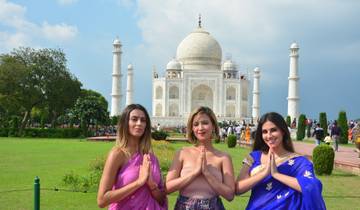
Taj Mahal Overnight Tour From Delhi By Car
"Everything was very easy and planned perfectly. Highly recommend." Jessica, traveled in April 2024
- Book With Flexibility View tour Download Brochure
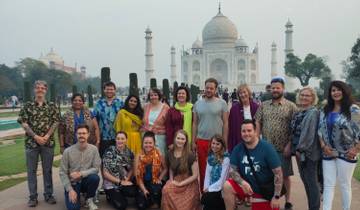
Private Full Day Taj Mahal and Fatehpur Sikri Tour from Delhi By Car
"I recommend it, especially to couples. The guides were both very competent and helpful." Simone, traveled in March 2024
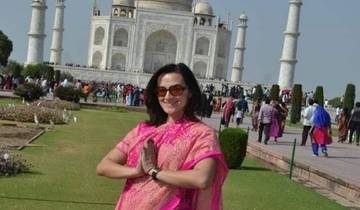
Private 2 Days Tour of Taj Mahal Agra with Fatehpur Sikri from Delhi
"A very well organised tour with the same driver throughout. Guide provided in Agra was lovely." Sarah, traveled in October 2022
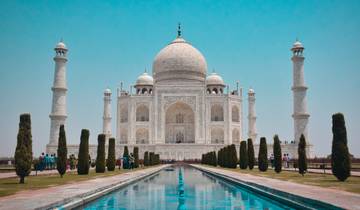
Private Taj Mahal at Sunrise & Agra Day Tour From Delhi
- 10% deposit on some dates
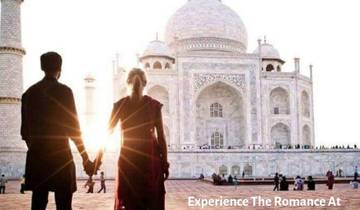
Day Trip to Taj Mahal
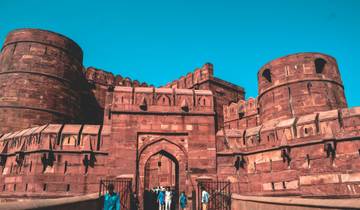
Delhi To Agra Tour Package

India's Top Selling Golden Triangle India Tour w/ Meals and Sunrise Taj Mahal
"Couldn't fault anything - hotels were good guides were knowledgeable and our driver Kan Singh was fantastic." Jonathon, traveled in March 2024
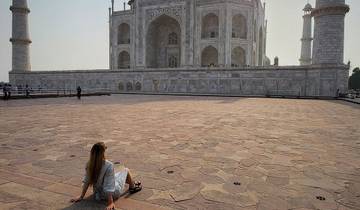
Same day Taj Mahal Tour from Delhi by Car - All Inclusive
"Excellent Services provider." Rahul, traveled in December 2021

All Inclusive Day Trip to Taj Mahal, Agra Fort and Baby Taj from Delhi by Private Car
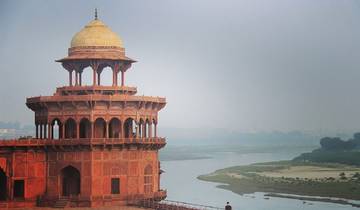
Taj Mahal Awesome View Sunrise or Sunset Agra Local
What people love about taj mahal tours.
Everything was very easy and planned perfectly, driver Dinesh was great, and on time. Highly recommend
The tour was very nice and everything was organised perfectly. I recommend it, especially to couples. The guides were both very competent and helpful. The driver also gave us a very comfortable trip. I recommend it.
A very well organised tour with the same driver throughout. Guide provided in Agra; we had one of the few female guides in the industry who was lovely and a guide provided at the location on the way back. Only suggestion would be for the company to have Delhi based driver or provide the driver with accommodation prior and after pick up of guests.
Contact our Taj Mahal travel experts
Expert in Taj Mahal at TourRadar
Vivien is one of our seasoned Taj Mahal Travel Experts. Reach out to us to get all your questions about Taj Mahal tours answered!
- Choose from 66+ Taj Mahal tours
- 869 verified reviews by TourRadar customers
- 24/7 customer support
Write us a message
- India Travel Guide | All You Need to Know
- 10 Best Trekking Companies & Operators in India (with 5,325 Reviews)
- 10 Best Backpacking Groups & Travel Agencies (with 1,857 Reviews)
- India for Female Solo Travellers - Is India Safe?
- Best 2 Week India Itineraries 2024/2025 (with Reviews)
Discover TourRadar
- Spain Tours
- Morocco Tours
- Italy Summer tours
- West Africa Partially Guided tours
- South Korea One Life Adventures - 10 Day Tour
- Exclusive 3-day Cusco and Machu Picchu Package
- Finland Travel Guide | All You Need to Know
- AU: 1-800-665-977
- UK: 0-808-189-1339
- Global: 86-29-8526-9897
- Destinations
- Middle East
- South America
- Central America
- North America
- Tailor My Trip
- Fatehpur Sikri
- Mehtab Bagh
- Tomb of I'timād-Ud-Daulah
- Akbar’s Tomb
- Jama Masjid
- Buland Darwaza
- Yamuna River
- Wildlife SOS
- 7 Days Golden Triangle
- 9 Days Best Tour
- Golden Triangle & Rajasthan
- South India Tours
- North India Tours

What Travelers Need to Know About Taj Mahal's Rules & Regulations
New rules for taj visitors, entry to the taj mahal: gates, timings, entry fee.
As far as the entry fee is concerned, the authorities have created different fee slots for tourists. While Indians have to pay an entry fee of INR 50, foreigners (except the citizens of SAARC and BIMSTEC Countries) have to spend around twenty times more money on tickets. The entry fee for foreign nationals is INR 1100 (approx. US$15). Citizens of SAARC and BIMSTEC countries need to pay INR 540 as entry fees for the Taj visit.
Additional charges:
There’s an additional fee of INR 200 for visiting the main mausoleum and it is equal for all. As mentioned earlier, the additional charges are also applied if you spend more than 3 hours at the Taj Mahal.
How and where to buy tickets/tokens:
General rules for the taj mahal visit:, tips to stay safe and avoid trouble.
Nearby attractions : Mehtab Bagh (Moonlight Garden) , Taj Nature Walk Park, Taj Museum.
You May Like
- About Agate
- In the Media
- Affiliate Program
- Customer Service
- Loyalty & Referral
- Terms & Conditions

Copyright © 1997-2024 All rights reserved

- Festival of Democracy
- Latest News
- Andhra Pradesh
- Visakhapatnam
Entertainment
- Photo Stories
- Delhi Region
- Education & Careers
- Media Outreach
- Revanth Reddy
- Telangana Assembly
- Andhra Pradesh News Updates
- telangana news updates
- 2024 Lok Sabha elections
- In conversation with PM Modi, SKY reveals secret to keeping calm during final over heroics
- New in-charge for Karnataka BJP, Radhamohan Das Agarwal to take over
- 4 killed, several wounded as truck overturns in Sri Lanka
- CPI Leader Narayana Calls for Amicable Resolution in Telugu States Chief Ministers Meeting
- This triumph was bound to happen for me, and for the team, says Virat Kohli on T20 World Cup victory
- IANS Analysis: World Tibet Day - An honour of Tibetan resistance
- 'Will affect lakhs of honest students': Centre opposes cancellation of NEET-UG exam in SC
- Baby dies due to genital injury during C-section; family protests in Karnataka
- DC who flagged MUDA allotments, among 21 IAS officers transferred; BJP lashes out at K’taka govt
- Surjewala questions timing of tariff hike by 3 telcos, accuses Centre of promoting crony capitalism
Beauties from 30 countries say ‘wah Taj’ as they visit Taj Mahal

A sea of 110 beauties from around 30 countries on Thursday visited Agra, Uttar Pradesh to witness one of the seven wonders of the world ‘Taj Mahal’. ...
A sea of 110 beauties from around 30 countries on Thursday visited Agra, Uttar Pradesh to witness one of the seven wonders of the world ‘Taj Mahal’.
The Tourism Police had made strict arrangements for the safety of the world’s beauties. Surrounded by security, these world beauties saw the symbol of love, Taj Mahal.
They looked quite excited after witnessing the Taj Mahal. These world beauties got lost in the beauty of Taj and its amazing architecture and could not stop themselves from saying ‘wah Taj’.
They also showed special interest in knowing the mosaic and history of Taj Mahal. They learned about the history of Taj Mahal and its architecture through the help of tourist guides.
The visuals show the beauties arriving from England, Bangladesh, Botswana, Vietnam, Brazil, Fiji, Uganda, South Africa, the Dominican Republic, Zimbabwe, the Philippines, Sri Lanka, and others. They were dressed in their traditional attire.
Taj Mahal is an ivory-white marble mausoleum, which is situated on the right bank of the river Yamuna in Agra. It was commissioned by Mughal Emperor, Shah Jahan to house the tomb of his wife, Mumtaz Mahal.
Meanwhile, Czech beauty Krystyna Pyszkova was crowned as the ‘Miss World’ on March 9, 2024. Krystyna had defeated Yasmina Zaytoun of Lebanon, Ache Abrahams of Trinidad and Tobago, and Lesego Chombo of Botswana. ‘Miss India’ Sini Shetty had failed to make it to the Top 4.
India had hosted the coveted beauty pageant after a gap of 28 years, and it was hosted by filmmaker Karan Johar and the winner of Miss World 2013, Megan Young.
- Uttar Pradesh

- Advertise With us
- Terms & Conditions
- Subscriber Terms of Use
- Privacy Policy
- Editor'S Desk

© 2024 Hyderabad Media House Limited/The Hans India. All rights reserved. Powered by hocalwire.com

BOOK DIRECT OFFERS

.css-lsbrzj{display:-webkit-box;display:-webkit-flex;display:-ms-flexbox;display:flex;-webkit-flex-direction:row;-ms-flex-direction:row;flex-direction:row;-webkit-column-gap:2.08vw;column-gap:2.08vw;-webkit-align-items:center;-webkit-box-align:center;-ms-flex-align:center;align-items:center;} .css-1njxoun{margin:0;-webkit-flex-shrink:0;-ms-flex-negative:0;flex-shrink:0;border-width:0;border-style:solid;border-color:rgba(0, 0, 0, 0.12);border-bottom-width:thin;background:#FFFFFF;border-color:#FFFFFF;width:4.167vw;height:0.055vw;} .css-gw9im6{margin:0;font-family:Cinzel,Palatino Linotype,sans-serif;text-transform:uppercase;font-weight:400;font-size:3.23vw;line-height:3.85vw;letter-spacing:-0.05em;color:#45443F;color:#FFFFFF;line-height:120%;white-space:nowrap;} Taj Mahal, New Delhi

WHERE RESTRAINED LUXURY SHINES

.css-1txmose{display:-webkit-box;display:-webkit-flex;display:-ms-flexbox;display:flex;-webkit-flex-direction:row;-ms-flex-direction:row;flex-direction:row;-webkit-align-items:center;-webkit-box-align:center;-ms-flex-align:center;align-items:center;-webkit-column-gap:2.083vw;column-gap:2.083vw;} .css-1p7jcgw{margin:0;-webkit-flex-shrink:0;-ms-flex-negative:0;flex-shrink:0;border-width:0;border-style:solid;border-color:rgba(0, 0, 0, 0.12);border-bottom-width:thin;height:2%;width:4.16vw;border-color:#45443F;background:#45443F;} .css-1r4ragq{margin:0;font-family:Cinzel,Palatino Linotype,sans-serif;text-transform:uppercase;font-weight:400;font-size:3.23vw;line-height:3.85vw;letter-spacing:-0.05em;color:#45443F;line-height:120%;white-space:nowrap;color:#45443F;} Highlights

State-of-the-art air purification systems

Butler service

Lush green environs

The Chambers - India's Premier Business Club

Magnificent views

Golden Keys concierge

Reimagined Taj Club
Hotel .css-115zxdz{display:-webkit-box;display:-webkit-flex;display:-ms-flexbox;display:flex;-webkit-flex-direction:column;-ms-flex-direction:column;flex-direction:column;-webkit-align-items:center;-webkit-box-align:center;-ms-flex-align:center;align-items:center;-webkit-column-gap:0;column-gap:0;} information.

Check-in from 2:00 pm
Check-out until noon
146 rooms, 40 suites and 27 residences
4 restaurants, 1 lounge and 2 bars
J Wellness Circle offering Indian and international therapies
GSTIN : 07AAACT3957G1Z9
Number One Mansingh Road, New Delhi, Delhi, 110011, India
+91 1166566162
+91 1164804425; +91 1168183700

Location & Directions
Getting here.
Number One Mansingh Road, New Delhi, Delhi 110011, India
Transfers to and from Indira Gandhi International Airport from Taj Mahal, New Delhi take approximately twenty-five minutes by car
LOCAL TRANSPORT
Public taxis are readily available. Hotel cars and taxis can be organised by the concierge

GIFT HAMPERS

TIMELESS WEDDINGS

J WELLNESS CIRCLE

EXCLUSIVE OFFERS

TAJ EXPERIENCE GIFT CARDS

Luxury hotel suites with views of the world’s most iconic landmarks
Share this article
Enjoy the world's best sights without leaving your luxury hotel room. Photo / The Dolli© at Acropolis
Travelling to a tourist hotspot this year? There is a way to see the world’s most iconic landmarks from the comfort of your own hotel bed, writes Michelle Tchea
Travelling can be exhausting - sometimes you just don’t want to get out of bed, bash heads with other tourists and line-up in one-hour-long queues to see some of the world’s most revered tourist hotspots.
The good news is, there is a way to see Greece’s Acropolis, New York’s Empire State Building and Sweden’s Old Town from the comfort of your hotel. More and more luxury hotel suites are being strategically built in the most well-positioned places to allow travellers the opportunity to wake up and go to bed with something like the Taj Mahal in clear sight.
The hotel suites and rooms do come with a caveat, they are much more expensive due to their prime location and central real estate and yes, you are right: mostly it is the most prestigious and opulent suite in the hotel that has these views.
But if the result is not having to elbow other tourists for a picture-perfect shot of your favorite landmark the splurge might actually be worth it. Here are the best luxury hotels with stellar views of national landmarks.
Crown Sydney, Australia - Presidential Villa
You either have to jump on a super yacht or helicopter to get both of Sydney’s national landmarks in full shot but as a guest of Crown Sydney, you wake up to the sun rising over both the Sydney Harbour Bridge and Opera House and the views are stellar on the 88th-floor.
With 76 residences and 349 hotel rooms, Sydney’s luxury hotel on Darling Harbour is one of the tallest buildings in the city and with this, you get stunning panoramas but while some of the simplest and lower grade rooms do have views of both landmarks too, the Presidential Villa is where you want to sleep, rest and linger. The 800sq m palatial villa is split over two levels so you can enjoy the Opera House and Harbour Bridge from your very own infinity pool and bathtub - whatever takes your fancy.

The Carlyle, New York, United States
New York has many great landmarks and you can get a crick in your neck just looking at all of them from the ground floor, but rather than annoying New Yorkers (by stopping, looking up and taking photos), the best view is definitely from the luxurious Presidential Suite of the Carlyle. Located on the 26th floor, guests have 360-degree views of the city with sweeping vistas of midtown and of course - Central Park. Inside the suite, there are Art Deco-inspired murals for art lovers to enjoy but it is really hard to not spend every waking moment peering over the edge and looking at the Empire State Building and Chrysler Building from the comfort of your king-sized bed.
Prince De Galles, Paris, France
There are many luxury hotels with views of Paris’ Eiffel Tower, but one of the most over-the-top suites has to be the Suite Lalique by Patrick Hellmann in Prince de Galles, Paris . Smaller in size compared to other suites, the 180sq m suite offers a beautiful and unobstructed view of the Eiffel Tower. From the terrace, guests can enjoy 280-degree views of the prestigious Avenue George V and the Iron Lady for the perfect chic Parisian weekend . The piece de resistance has to be that the entire suite is adorned with Lalique crystal with the duplex apartment only accessed by private lift - so this is Paris at its best. The second floor offers the best view of the Eiffel Tower and there is also an uninterrupted view of Sacre-Coeur from the dining room if you want to hit all your landmarks in one easy picture-perfect moment.

Airelles Chateau de Versailles, France
The Necker Suite at Chateau de Versailles has breathtaking views over the lush Orangery garden and the Palace from the free-standing bathtub, but if you are going to relive your dream of being French royalty, you definitely want to opt for the most opulent suite available: the Le Grand Appartement. Boasting an 18th-century vibe, the entire apartment has the most luscious views of the garden and is actually a combination of the Turgot Room, the Madam de Fouquet Room and Necker Suite - with all of them interconnecting. The apartment has a 30sq m terrace and a grand library too - if you need more reasons to book. Guests are treated to a gourmet breakfast by famed French chef Alain Ducasse, as well as an afternoon petit four and C hampagne aperitif each evening to round off a grand and royal stay in Versaille.

The Dolli, Athens, Greece
Greece just screams summer and while many tourists enjoy walking up to the Acropolis, the best place in Athens has to be at the five-star luxury hotel, the Dolli at Acropolis. The historical acropolis can be seen from both the bedroom and bathroom as you have a bubble bath with Champagne flute in hand. If you get tired of hanging out in your room, head out to the Dolli’s infinity pool and float on water or sit under a sunshade with legendary views of the Parthenon in clear sight.

Grand Hotel, Stockholm, Sweden
One of the most historical hotels in Sweden’s capital, Stockholm, the Grand Hotel still garners the attention of luxury travellers because of its location and views of some of Sweden’s most loved landmarks. Home to Swedish celebrities since 1874, the luxury hotel overlooks the city’s waterfront and has views of the Royal Palace and Gamla Stan, Stockholm’s old town. The most luxurious suite is the Wilhelmina Skogh Suite, which has chandeliers, free-flowing Champagne and of course direct access to the hotel’s newest Michelin-star restaurant, Seafood Gastro by Mathias Dahlgren.
Wynn Las Vegas, US
In a city where superlatives are worth every penny, the Wynn Resort takes everything to a whole new level when guests check into the Wynn Panoramic Corner Suite. The suite is affixed with in-room tablets for that futuristic and hands-free living in a city that never sleeps and it’s hard not to fall asleep with the 507-thread-count linens but what sets this suite apart from others is the rotating programme of commissioned artwork featuring a curated collection of “refined, modern pieces”. At 59sq m, the sought-after rooms are the most requested with spectacular views of the Strip and Las Vegas Valley - depending on how lucky you are - the gamble is all yours on which suite you get.
Oberoi Amarvilas, Agra, India
Visiting the Taj Mahal during India’s summer can be a death wish with temperatures reaching more than 49C. But if you find yourself in Agra, you can still enjoy the best views with the AC on full blast in your luxurious suite at the Oberori, Amarvilas Agra.
As the capital of the Mughal Empire in the 16th and 17th centuries, Agra is home to three Unesco World Heritage sites, the Taj Mahal, Agra Fort and the ancient city of Fatehpur Sikri. Located just 600m away, the Kohinoor Suite is the jewel of the property with 230sq m and views of the Taj Mahal in every single room. Elegant yet historical with the Mughal palace designs featuring white marble elephants and golden-domed ceilings, the stay is truly one of a kind.

Shangri-La, London, United Kingdom
Perched on level 39 of the Shard, the Shangri-la suite and premier city view room offers 270-degree views of London’s most iconic landmarks. Stretching as far as the eye can see, the views include Canary Wharf, the London Eye and of course, Tower Bridge. A personal butler is available to grant you all your travel wishes. It’s easy to visit these national landmarks but life seems far too good and luxurious, doesn’t it?

Nimb Hotel, Copenhagen, Denmark
Not considered a landmark but definitely a national treasure and culture centre for the Danes, the Tivoli Gardens is a theme park similar to Disneyland (Walt Disney is said to have visited and was inspired to create Disney World after staying as a guest) in the city of Copenhagen. Created in 1843, the Moorish-inspired fairytale castle is home to Copenhagen’s most luxurious hotel, Nimb, which has 38 rooms and suites sitting right next to the Tivoli Gardens - a place where young and old come to ride rollercoasters, eat roasted candied peanuts and drink Danish beer. Apparently, Tivoli Gardens was built because the founder Georg Carstensen suggested to King Christian VIII that an amusement park was essential to stop him from being dethroned since, “When people are amusing themselves, there is no time for politics”. An interesting theory that created one of the most loved destinations in Copenhagen’s history and yes, in case you were wondering - King Christian did keep his crown.
Latest from Travel
Watch: taupō mcdonald’s goes viral after being hailed world’s ‘coolest’, yearning for summer fed up with winter here are 4 island holidays to escape to, beloved tourist activity banned at popular australian sanctuary, have the holiday of your dreams with my queensland.

'I couldn't believe my eyes ... I’ve never experienced anything quite like it.'

Is it a bad idea to drink alcohol on a plane?

Time to get away?

COMMENTS
Book a Hotel near Taj Mahal, Agra. No Reservation Costs. Great Rates. Choose from a wide range of properties which Booking.com offers. Search now!
Taj Mahal at sunrise. Peter Adams/Getty Images. The Taj Mahal looms fairytale-like from the banks of the Yamuna River. It's India's most recognized monument and is also one of the Seven Wonders of the World. The monument dates back to 1632 and is actually a tomb that contains the body of Mumtaz Mahal—the wife of Mughal emperor Shah Jahan.
Get more information on the best time to visit the Taj Mahal in a day. 7-Day Maharajas' Express Luxury Train TourDelhi - Agra - Ranthambore - Jaipur - Jodhpur -Udaipur - Mumbai . Taj Mahal Entrance Cost and Rules. The Taj Mahal is open from 6 am to 7 pm every day except for Fridays when it is closed for prayer. The Taj also reopens every day ...
Night viewing of Taj Mahal is available on five days in a month i.e. on full moon night and two nights before and two after the full moon. Timing: 20:00 hrs. to 23:59 hrs. in 8 batches of max. 50 people each. Time duration for each batch is half an hour (30 minutes). View details.
2. Don't visit on Friday. This one's pretty straightforward- the Taj Mahal is closed every Friday to allow practicing Muslims to come in and worship at its mosque. It's located directly to the west of the main mausoleum structure, which is closest to Mecca. 3.
Learn how to visit the Taj Mahal, the iconic marble mausoleum built by a Mughal emperor for his wife. Find out what to bring, wear, see and do in Agra and beyond with this comprehensive guide.
Copies of the Taj Mahal have been built around the world. Constructed by Aurangzeb's son Azam Shah in 1679, the Bibi-qa-Maqbara in Aurangabad, is an obvious tribute to the Taj, though much less refined. There are also modern reproductions of the Taj Mahal in Bangladesh, China, Indonesia, Malaysia, the US, Brazil, Colombia, and several Gulf ...
Travel Information. Home. Tourism Offices. +91 562 2226431 Office of UP. Tourism 64, Taj Road, Agra 10:00 AM to 5:00PMexcluding declared hoiliday & sunday. Government of India Tourism Office, 191, The Mall +91 562 2226368 +91 562 2226378. +91 562 2421204 U.P. Tourism Reception Counter, Agra Cantt, Railway Station 06:30 AM to 09:30PM.
In December. Full-on smog central. Fog mayhem. At this time of year, the Taj can be blanketed in fog and hard to make out, especially in the morning. In the afternoons, the haze burns off and the skies are as pristine as they can get in India. The guesthouse owner had strenuously advised us to visit later in the day.
February 21, 2018. • 5 min read. The Taj Mahal is widely considered one of the most beautiful buildings ever created. The exquisite marble structure in Agra, India, is a mausoleum, an enduring ...
191, Mall Road, Agra - 282001. Tel : (+91) 562 - 2226378. Guides may help you in exploring Agra & around in a better way . Guides will also tell you about excursions, attraction, things to see , activities to enjoy , best itineraries as per your timings & much more. But please ensure that you are hiring a government approved guide.
The new time limit for the visit of the Taj Mahal by the UNESCO World Heritage Committee is established as a precaution to prevent overpopulation and damage. The extra fee of the initial ticket price will be payable for those staying longer than 3 hours. The number of visitors is likewise limited to 40 thousand daily.
One of the world's most recognisable buildings, the Indian landmark attracts up to eight million visitors per year. Here's what you should consider before you go.
For your visit to the Taj Mahal, be sure to wear either long pants, long skirts or a long dress that covers you all the way past the ankles. Avoid wearing sleeveless or tight-fitting tops, instead, opt for a lightweight linen top. Short sleeve is okay. Headscarves are not required to visit the interior.
The Taj Mahal is open daily except on Fridays, when it is closed for prayers. The gates open at sunrise and close at sunset. 6. Buy the tickets at the south gate (or online) Normal entrance to the Taj Mahal costs ₹1300 (₹250 Indians - ₹50 without access to the main mausoleum - and ₹740 SAARC nationals).
Learn how to plan your first visit to the Taj Mahal, one of the Seven New Wonders of the World, in Agra, India. Find out the best time, gate, ticket, photography tips and more.
Settle on an early-morning strategy, or go for a "last thing at night" visit — the Taj opens 30 minutes before sunrise and closes 30 minutes before sunset.Sunrise is truly magical, thanks to a ...
Agra Fort: A short Tuktuk ride from the Taj and clocking in at a cheaper 650 Rupees (aprx $7.50USD) for a foreign visitor, this is where the emperors of the Mughal Empire lived until the capital was shifted to Delhi in 1638. The 38-hectare site is imposing and, unlike the Taj Mahal, you can get a sense of its vastness from the outside.
But without further ado, here are my 15 best tips for visiting the beautiful Taj Mahal. 1. Don't visit the Taj Mahal on a Friday. Simply put: this wonder of the world is closed on Fridays. So make sure to keep this in mind when you're planning your trip to India and the Taj Mahal.
The Taj Mahal (/ ˌ t ɑː dʒ m ə ˈ h ɑː l, ˌ t ɑː ʒ-/; lit. ' Crown of the Palace ') is an ivory-white marble mausoleum on the right bank of the river Yamuna in Agra, Uttar Pradesh, India.It was commissioned in 1631 by the fifth Mughal emperor, Shah Jahan (r. 1628-1658) to house the tomb of his beloved wife, Mumtaz Mahal; it also houses the tomb of Shah Jahan himself.
Expert Tips in 2024. There are three seasons in Agra, home to the Taj Mahal: the hot season (April to June), the rainy season (July to September), and the (mild) dry season (October to March). October to March is the best time period to visit the Taj Mahal weather-wise, when temperatures average from 15 to 27°C (59-81°F).
From Goa to Taj Mahal. If you travel to Goa and want to visit Taj Mahal as well, it's best to take a flight to New Delhi, and from there take the express train or minibus to Agra. Flights are usually inexpensive, but you can also take a train from Goa to Agra, such as the Goa Express.
Reach out to us to get all your questions about Taj Mahal tours answered! Choose from 66+ Taj Mahal tours. 869 verified reviews by TourRadar customers. 24/7 customer support. +1 844 311 8331. Browse the best tours in Taj Mahal with 869 reviews visiting places like Taj Mahal and Agra. All Major Brands.
An elegant poet described Taj Mahal as the teardrop on the cheek of eternity. Taj Mahal is a world wonder located in Agra. Every year tourists amounting to twice the total population of Agra visit the city for spotting Taj Mahal. To immortalize his love for his favorite wife, Mumtaz Mahal, the Mughal Emperor Shah Jahan built the most amazing mausoleum of all times.
The Taj Mahal complex is a very large place, so knowing the rules and regulations as Taj Mahal travel tips is very important when visiting. New rules for Taj visitors Taj Mahal's Rules & Regulations • In June 2019, the Indian government, with the Archaeological Survey of India (ASI), announced that visitors who spend more than 3 hours at the ...
Watch on. Talk Travel App has compiled a list of reasons why the Taj Mahal should be a part of everybody's travel bucket list. 1. The reason behind the construction of the Taj Mahal. It was the Mughal Emperor Shah Jahan who commissioned the construction of this exquisite monument as an expression of his love to his dear wife Mumtaz Mahal ...
A sea of 110 beauties from around 30 countries on Thursday visited Agra, Uttar Pradesh to witness one of the seven wonders of the world 'Taj Mahal'. The Tourism Police had made strict ...
Taj Mahal, New Delhi, is a luxury 5-star deluxe hotel that has recently undergone a complete renovation, preserving its timeless appeal while incorporating contemporary charm. Situated in the heart of the city, the hotel offers a unique vantage point with views of the leafy boulevards of Lutyens Delhi, adding to its status as an iconic landmark ...
Visiting the Taj Mahal during India's summer can be a death wish with temperatures reaching more than 49C. But if you find yourself in Agra, you can still enjoy the best views with the AC on ...